 Open Access Library Journal, 2014, 1, 1-47 Published Online May 2014 in OALib. http://www.oalib.com/journal http://dx.doi.org/10.4236/oalib.1100367 How to cite this paper: El-Gohary, N.S. (2014) Arylidene Derivatives as Synthons in Heterocyclic Synthesis. Open Access Li- brary Journal, 1: e367. http://dx.doi.org/10.4236/oalib.1100367 Arylidene Derivatives as Synthons in Heterocyclic Synthesis N. S. El-Gohary Department of Medicinal Chemistry, Faculty of Pharmacy, Mansoura University, Mansoura, Egypt Email: dr.nadiaelgohary@yahoo.com Received 18 March 2014; revised 25 April 2014; accepted 7 May 2014 Copyright © 2014 by author and OALib. This work is licensed under the Creative Commons Attribution International License (CC BY). http://creativecommons.org/licenses/by/4.0/ Abstract This review describes the synthetic procedures for the preparation of arylideneacetophenones, arylidenecycloalkanones, 2-arylidene-1-indanones, 2-arylidene-1-tetralones, 2-arylidene-1-ben- zosuberones, aurones, 1-thioaurones, 3-arylidene-4-chromanones, 3-arylidene-1-thio-4-chroma- nones, 3-arylideneflavanones, 3-arylidene-1-thioflavanones, arylideneanilines, arylidenemalono- nitriles, diethyl arylidenemalonates, ethyl arylidenecyanoacetates, arylidenecyanoacetamides, 5- arylidene derivatives of barbituric and thiobarbituric acids, arylidene derivatives of Meldrum’s acid and arylidene derivatives of dimedone. Also, it demonstrates the reactivity of these arylidene derivatives in heterocyclic synthesis with emphasis on the most recent findings. Some of these are the α,β-enones, víz. aurones and 3-arylidene-4-chromanones belong to the natural products. The others are synthetic substances which are convenient and important intermediates for the syn- thesis of a variety of useful and novel heterocyclic systems. Keywords Arylidenes, Synthesis, Reactions, Heterocycles 1. Introduction The chemistry of different arylidene compounds has generated intensive scientific studies throughout the world. Especial interest has been focused on the synthesis and pharmacological activities of different arylidene com- pounds. They are versatile synthons so that a variety of novel heterocycles with good pharmaceutical profiles can be designed. Those arylidenes are usually prepared through Knoevenagel condensations of aldehydes with active methylene compounds, they are usually base [1], Lewis acid [2], or surfactant-catalyzed [3]; thus, create much wastes. Recen tly, there was an interest in so-called solven t-free [4] [5] Knoevenagel condensations on solid supports that were promoted by infrared [6] or microwave irradiation [7] [8]. Unfortunately, the latter tech niques  N. S. El-Gohary require solvents for the extraction from the solid supports as well as for the preparation of the initial adsorbates, and do not yield pure products. Thus, further solvents are required for purifying the workup. Even catalys t-free Knoevenagel reactions in water could not reach quantitative yields [9]-[11]. This research deals with the various methods of preparation of arylideneacetophenones, arylidenecycloalkanones, 2-arylidene-1-indanones, 2-aryli- dene-1-tetralones, 2-arylidene-1-benzosuberones, aurones, 1-thioaurones, 3-arylidene-4-chromanones, 3-aryli- dene-1-thio-4-chromanones, 3-arylideneflavanones, 3-arylidene-1-thioflavanones, arylideneanilines, arylidene- malononitriles, diethyl arylidenemalonates, ethyl arylidenecyanoacetates, arylidenecyanoacetamides, 5-aryli- dene derivatives of barbituric and thiobarbituric acids, arylidene derivatives of Meldrum’s acid and arylidene derivatives of dimedone as well as their utilizatio n in heterocyclic synthesis. 2. Synthesis 2.1. Synthesis of Arylideneacetophenone Derivatives (Chalcones) Different methods are available for the preparation of chalcones [12]-[14]. The most convenient method is the Claisen-Schimdt condensation of equimolar quantities of arylmethylketones with aryl aldehydes in the presence of aqueous alcoholic alkali [15]-[25]. Chalcones are used to synthesize several derivatives like cyanopyridines, pyrazolines, isoxazoles, and pyrimidines having different heterocyclic ring systems [26]-[29]. 2.1.1. Various Condensing Agents Have Been Used in the Synthesis of Chalcon es 1) Alkal i Alkalis are the most widely used condensing agents for the synthesis of chalcones. They are used as an aque- ous alcoholic solution of suitable concentration viz. 30%, 40%, 50% and 70% [15]-[25 ]. 2) Acids Methanolic solution of dry hydrochloric acid gas at 0˚C was us ed for the synthesis of chalcones from aromatic ketones and aldehydes [26] [27]. In addition, concentrated sulfuric acid in acetic acid was used as a condensing agent in the synthesis of chalcones [28]. 3) Other Condensi n g Agents Raval and Shah [29] used phosphorous oxychloride as a condensing agent to synthesize chalcones. In addition, Szell and Sipos [30] condens e d 2-hydroxy-5-nitroacetophenone wit h benzalde hyde usin g a nhydrous A lCl3. Besides the above, other condensing agents have been used in the synthesis of chalcones; namely, amino ac- ids [31], an aqueous solution of borax [32], perchloric acid [33], piperidine [34], boron trifloride [35], alkali metal alkoxides [36], magnesium tert-butoxide [37], and thionyl chloride [38]. In recent years, microwave assisted solid support solvent-free organic synthesis have attracted the attention as they offer several advantages such as simple procedure, fast reaction rate, mild reaction conditions, eco-friendly and improved yields as compared to conventional methods [39] [40]. 2.1.2. Mechanism The follo wi ng mechani s ms have been s ug ge sted for the synthesi s of chalco ne s: 1) Base catalyzed reaction (Scheme 1) [21] [41]. 2) Acid catalyzed reaction (Scheme 2) [42]. 2.1.3. Reactivity of Chalcone Derivatives The chalcones 1 are useful intermediates for the synthesis of a variety of heterocyclic compounds. Isoxazoles 2 are prepared by the reaction of chalcones 1 with hydroxylamine hydrochloride and sodium acetate [43] (Scheme 3). Treatment of chalcones 1 with guanidine hydrochloride in the presence of alkali afforded 2-aminopyrimi - dines 3 [44] (Scheme 3). Thiazines 4 and oxazines 5 can be synthesized by reaction of chalcones 1 with thiourea and urea, respectively [45] (Scheme 3). Pyrazoles 6, 7 are obtained through the reaction of chalcones 1 with hy- drazine hydrate and phenyl hydrazine derivatives, respectively [46]-[49] (Scheme 3). Furthermore, reaction of hydrazine hydrate with 1 in the presence of different aliphatic acids resulted in the formation of pyrazole de- rivatives containing N-acyl moiety 8a-c [49] [50] (Scheme 3). Condensation of chalcones 1 with malononitrile and ammonium acetate yields 2-ami no-3-cyanopyridines 9 [49] [51] (Scheme 3). On the other hand, reaction of 1 with malononitrile in refluxing methanol or ethanol and in the presence of freshly prepared sodium alkoxide solution yielded 3-cyanopyridines 10 [52] (Scheme 3). Reaction of cyanopyridines 10 with hydrazine hydrate 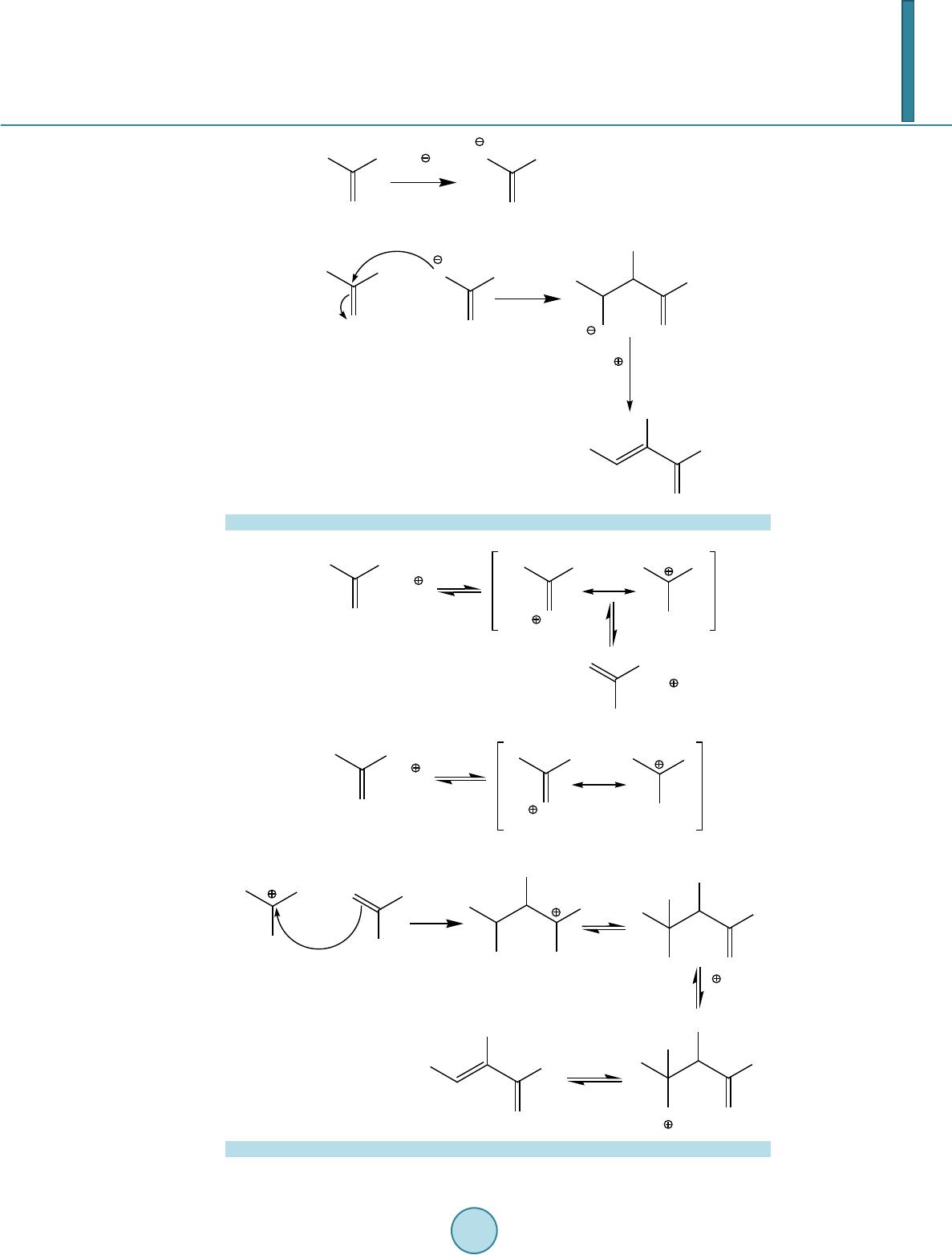 N. S. El-Gohary Ar H 3 C O OH Ar H 2 C O +H 2 O (i) H Ar 1 O Ar H 2 C O + (ii) Ar 1 Ar OO H H-H 2 O Ar 1 Ar O H + H 2 O 1 Scheme 1. Mechanism of base catalyzed condensation of aromatic ketones with aldehydes. ArH 3 C O ArH 3 C OH + (i) HAr 1 O (ii) Ar 1 Ar OH OH H Ar 1 Ar O H 1 +H ArH 3 C OH ArH 2 C OH H +H HAr 1 OH HAr 1 OH HAr 1 OH ArH 2 C OH + Ar 1 Ar OH O H H H Ar 1 Ar OH 2 O H H -H 3 O Scheme 2. Mechanism of acid catalyzed condensation of aromatic ketones with al de hydes . 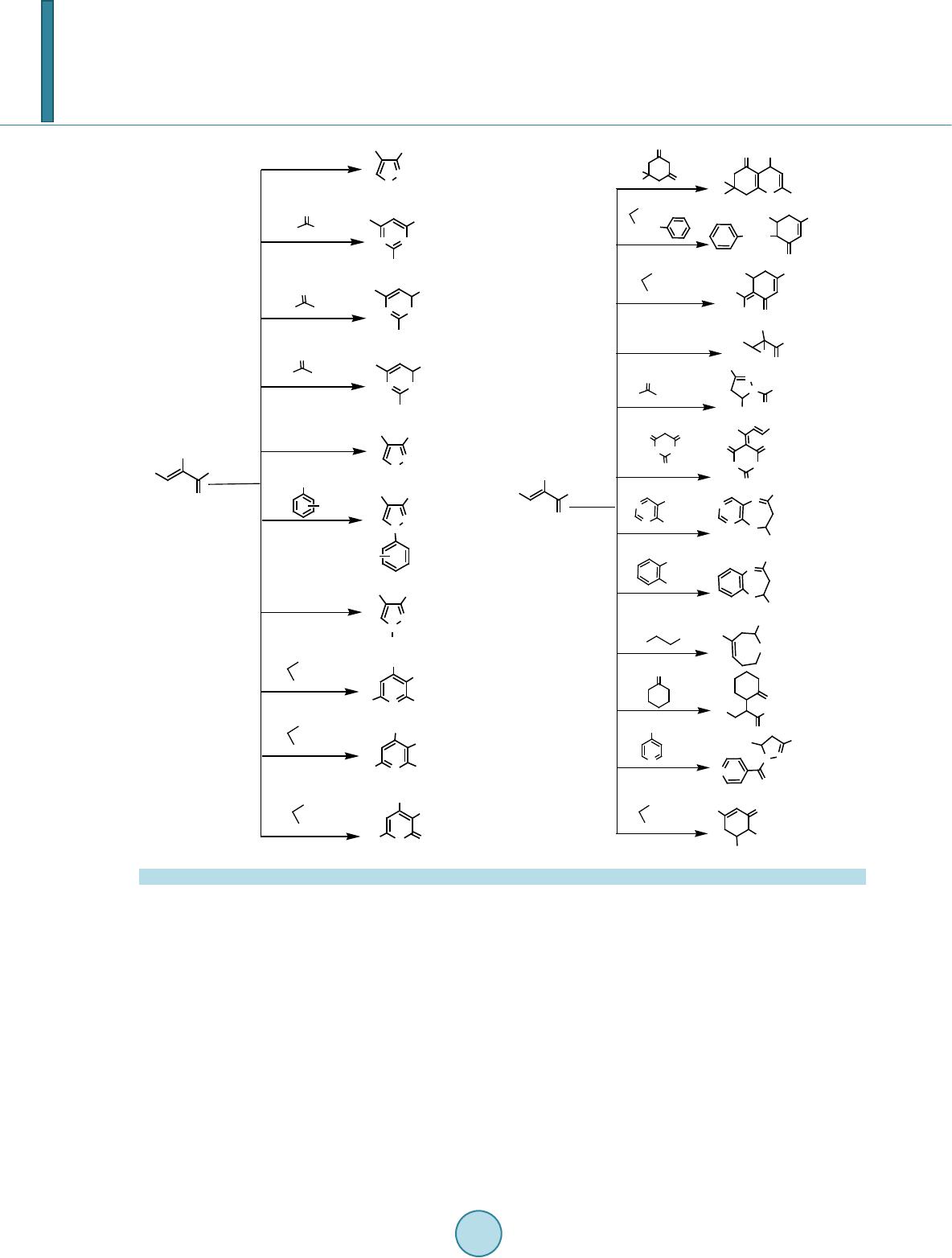 N. S. El-Gohary Ar1Ar O H 1 NH2OH N O Ar1 Ar 2 NH H2NNH2N N Ar Ar1 NH2 3 NS Ar Ar1 NH2 4 S H2NNH2 O H2NNH2NO Ar Ar1 NH2 5 NH2NH2.H2O N N H Ar1 Ar 6 CN CN N CN NH2 9 NHNH2 R N N Ar1 Ar R 7 NH2NH2.H2O RCOOH N N Ar1 Ar 8a: R= H 8b: R= CH3 8c: R= C3H7 COR N H CN O12 COOC2H5 CN CN CN MeONa/MeOH or EtONa/EtOHN Ar Ar1 OMe 10 NH4OAc Ar1 Ar CN Ar Ar1 (Et) Urea-hydrogen peroxideAr 1 Ar O H O 16 O H 2 NNHNH 2 . HCl N N Ar 17 Ar 1 O NH 2 HN NH OO O N NNH 2 NH 2 HN NH O O O Ar Ar 1 18 N NN H NAr Ar 1 19 SH NH 2 S NAr Ar 1 20 H 2 NNH 2 Ar NH Ar 1 21 O Ar 1 Ar O O 22 13a: R= H 13b: R= CH 3 Ar Ar 1 O COCH 3 COCH 3 15 H 3 C OH ArAr 1 O CONH COCH 3 HNOC 14 Ar 1 Ar O H 1 N CONHNH 2 NN Ar Ar 1 O N 23 COOR COCH 3 24a: R= CH 3 24b: R= C 2 H 5 O O R R O O Ar 1 R R Ar Ar 1 O Ar COOR Scheme 3. Preparation of compounds 2-10 and 12-24. using Lewis acid (1.0 equivalent of BF3∙Et2O) in refluxing ethanol under anhydrous conditions afforded 1H-py- razolo[3,4-b]pyridines 11 in very good yields and short r eaction time [52] (Scheme 4). Similarly, treat ment of 1 with ethyl cyanoacetate in absolute ethanol and in the presence of ammonium acetate afforded cyanopyridine derivatives 12 [49] (Scheme 3). Reaction of 1 with cyclohexane-1,3-diones produced 2,4-diaryl-5-oxo-5,6,7,8- tetrahydro-2-chromenes 13a, b. [53] Similarly, acetoacetanilide and acetylacetone reacted with chalcones 1 to afford cyclohexenone derivatives 14 and 15, respectively [49] (Scheme 3). Epoxidation of chalcones 1 with urea-hydrogen peroxide (UHP) under ultrasound irradiation gave oxirane derivatives 16 [54] (Scheme 3). Reac- tion of 1 with semicarbazide hydrochloride in glacial acetic acid/dioxane afforded pyrazoline-1-carboxamides 17 [55] (S cheme 3). The barbitones 18 are obtained upon condensation of chalcones 1 with barbituric acid [49] [56] [57] (Scheme 3). Treating 1 with 4,5-diaminopyrimidine gave [1,4]diazepine derivatives 19 [58] (Scheme 3). Condensation of chalcones 1 with 2-aminothiophenol afforded [1,4]benzothiazepines 20 [59] (Scheme 3). Tetrahydro-1H-azepines 21 were synthesized via reaction o f 1 with ethylen ediamine [60] (Scheme 3). Reaction of chalcones 1 with cyclohexanone in benzene in the presence of sodium hydroxide and a catalytic amount of  N. S. El-Gohary tributyl benzyl ammonium chloride (TBBAC) at room temperatue afforded 2-(1-oxo-1,3-diarylpropan-2-yl) cyclohexanones 22 [61] [62] (Scheme 3). Furthermore, reaction of 1 with isonicotinoyl hydrazide in refluxing ethanol gave N-isonicotinoyl-3,5-diarylpyrazolines 23 (Scheme 3) [49]. Reaction of 1 with methyl acetoacetate or ethyl acetoacetate in refluxing ethanol and in the presence of catalytic amounts of piperidine and basic alu- mina afforded 4,6-diaryl-2-oxocyclohex-3-enecarboxylates 24a, b [49] [63] (Scheme 3). Condensation of cy- clohexenecarboxylates 24a, b with hydrazine hydrate produced 4,6-diaryl-3-oxo-2,3,4,5-tetrahydroindazoles 25 [49] (Scheme 5). 2.2. Synthesis of Arylidenecycloalkanone Derivatives Arylidenecycloalkanones are frequently used α,β-unsaturated ketones. Their synthesis is based on the reaction of the appropriate cyclic ketone with aldehydes, through aldol condensation reaction. Several reports exist for their synthesis [64]-[69], involving the use of organic and inorganic bases, metal catalysts, different types of Friedel- Crafts catalysts and trichloro-1,3,5-triazine (TCT). A more convenient method used solid potassium hydroxide [70] [71] or sodium hydrox ide [72] as a catalyst for the condensation of different aldehydes with cycloalkanones in ethanol and resulted in α,α'-bis(substituted benzylidene)cycloalkanones 26 and 27 in good yields. This me- thod is economical and eco-friendly as neither any byproduct was formed nor any toxic material was used dur- ing the synthesis, and the reactions were carried out at ambient temperature. In addition, the same condensation was carried out in refluxing ethanol and in the presence of a catalytic amount of ammonium chloride to afford α,α'-bis(arylidene)cycloalkanones [73]. Moreover, a simple and efficient procedure for the synthesis of α,α'-bis (arylidene)cycloalkanones has been developed using N-bromosuccinimide (NBS) as a catalyst under mild reac- tion conditions [74]. Recently, a simple, improved and solvent-free synthesis of 26 and 27 was perfo rmed using activated barium hydroxide and grinding three to five minutes at room temperature [75]. Reaction of cyclopentanone with substituted benzaldehydes (1:2 molar ratio) in alcoholic alkali so lution pro- duced α,α'-bis(substituted benzylidene)cyclopentanones 26 (Scheme 6) [76] [77]. Cyclohexanone was reacted with substituted benzaldehydes under alkaline reaction conditions (1:2 molar ra- tio) to afford α,α'-bis(substituted benzylidene)cyclohexanones 27 which could be easily separated (Scheme 7) [76]-[82]. The same condensation was carried out using amino-functionalized ionic liquid, 1-aminoethyl-3-me- thyl tetrafluoroborate ([2-aemim][BF4]) as solvent and catalyst [83]. In addition, Brønsted acid-surfactant cat- alyst was utilized for synthes is of α,ά-bis(substituted benzylidene)cyclohexanones in aqueous media [84]. In addition, α,α'-bis(substituted benzylidene)cycloalkanones 26 and 27 could be obtained by refluxing 1,1- diacetates and cycloalkanones in tetrahydrofuran (THF) and in the presence of Samarium (III) Triiodide (SmI3) as a catalyst (Scheme 8) [85]. Cyclohexylphenyl methanols 28 were prepared by D-glucosamine catalyzed aldol reaction of cyclohexanone with substituted benzal de hydes (Scheme 9) [86]. 3,5-Dibenzylidene-4H-pyran-4-ones (30, X = O) and 3,5-dibenzylidene-4H-1-thiopyran-4-ones (30, X = S) were synthesized via reaction of tetrahydr o-4H-pyran -4-one (29, X = O) or tetrahydro-4H-1-thiopyran-4-one (29, X = S) with substituted benzaldehydes either under alkaline [87]-[90] or acidic [91] [92] reaction conditions (Scheme 10). NH2NH2.H2O BF3.Et2O/EtOH N Ar Ar1 11 N Ar Ar1 OMe 10 CN (Et) N H N NH2 Scheme 4. Preparation of compounds 11. Ar Ar1 NH N O 24a,b Ar1 O Ar COOR NH2NH2.H2O 25 Scheme 5. Preparation of compounds 25.  N. S. El-Gohary Scheme 6. Preparation of compounds 26 through reaction of cyclopenta- none with substituted benzaldehydes under alkaline conditions. Scheme 7. Preparation of compounds 27 through reaction of cyclohex- anone with substituted benzaldehydes under alkaline conditions. OR SmI 3 THF, reflux O R R + 26: n=1 AcO AcO n n n=1; 2 27: n=2 Scheme 8. Preparation of compounds 26 and 27 through reaction of 1,1- diacetates and cycloalkanones. OHC R OO + OH D-glucosamine H 2 O, 30 0 C 28 R Scheme 9. Preparation of compounds 28. OHC R R X O X O R + 29: X = O; S 30: X = O; S Scheme 10. Preparation of compounds 30. 2.3. Synthesis of 2-Arylidene-1-Indanone Derivatives 2-Arylidene-1-indanones 32 are important intermediates for the synthesis of a wide variety of heterocyclic ring systems. For this reason, it is useful to have simple and convenient procedures for their preparation. Most of the utilized syntheses are based on the condensation of 1-indanones 31 with aldehydes in the presence of a catalyst to afford 2-arylidene-1-indanones 32 (Scheme 11). In most cases sodium or potassium hydroxide is used as a catalyst [93]-[99] and 2-arylidene-1-indanones 32 are obtained in good yields. In addition, various inorganic acids, viz. sulfuric, phosphoric or hydrochloric acids were used as catalysts to prepare 32 [100]-[105]. It is worth mentioning that acetic anh ydride was used to facili- tate the condensation of indanones with substituted benzaldehydes [106]. Basavaiah and Reddy [107] have in- troduced a simple one-pot procedure for the preparation of 2-arylidene-1-indanones 32 starting from tert-butyl 3-aryl-3-hydroxy-2-methylenepropanoate 33, which was allowed to react with a catalytic amount of concen- 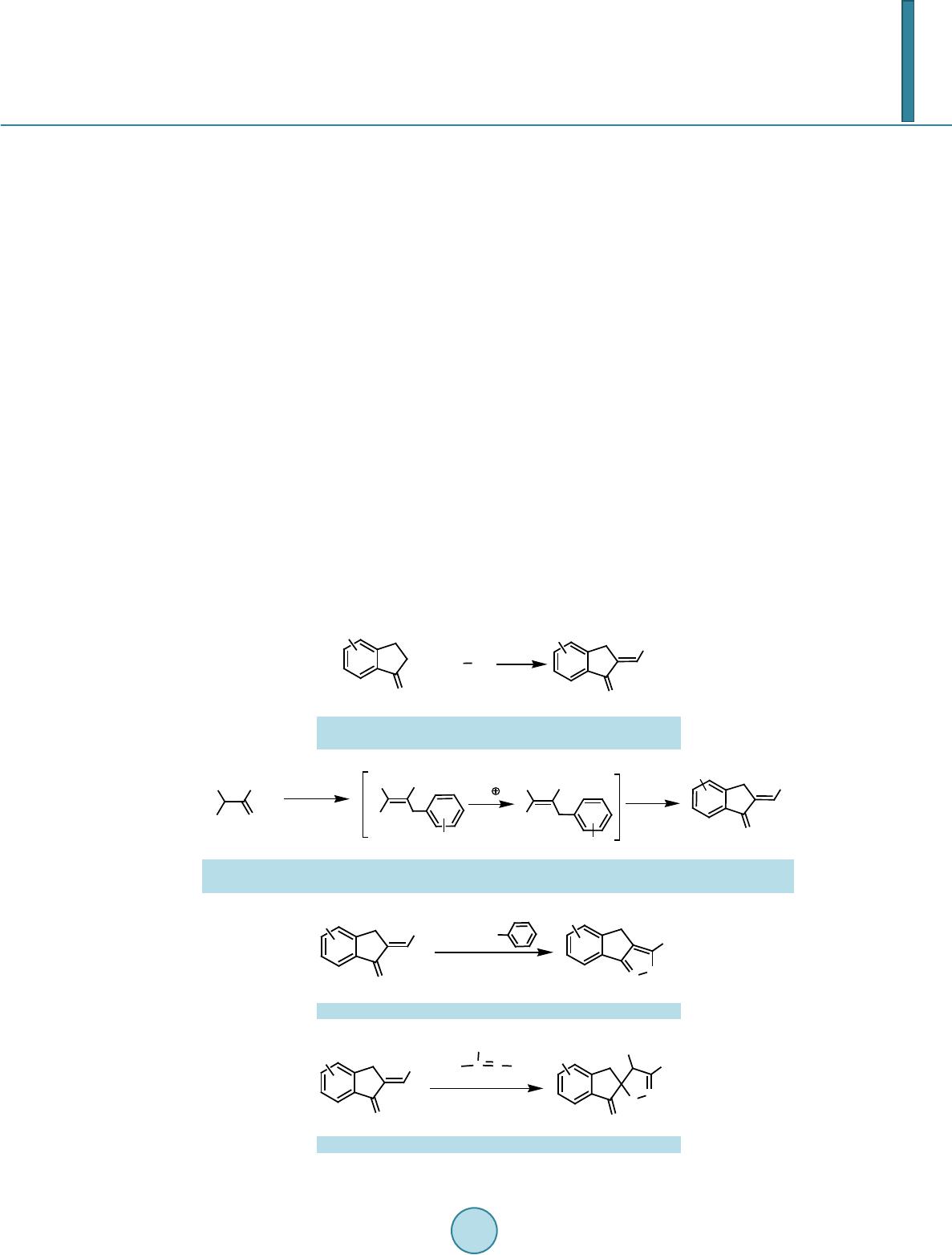 N. S. El-Gohary trated sulfuric acid in benzene followed by reaction of the intermediates formed with trifluoroacetic anhydride (TFAA) in methylene chloride to afford 32 (Scheme 12). Reactivity of 2-Arylidene-1-Indanone Derivatives The synthesis of indeno[1,2-c]pyrazoles 34 was accomplished via reaction of 2-aryliden e -1-indanones 32 with phenylsulfonylhydrazide in an inert solvent such as aromatic hydrocarbon and in the presence of a catalytic amount of acid [108] (Scheme 13). The [3 + 2] cycloaddition reactions of 2-arylideneindanones 32 with the arylnitrile oxides generated in situ from arylhydroxyaminoyl chlorides 35 and triethylamine led to the formation of the spiro derivatives 36 [109] (Scheme 14). 2.4. Synthesis of 2-Arylidene-1-Tetralone Derivatives 2-Arylidene-1-tetralones 38 are useful intermediates for the synthesis of polycyclic ring systems. Several syn- thetic methods have been developed for their preparation. The majority of compounds 38 have been synthesized by the condensation of 1-tetralones 37 with aromatic aldehydes in aqueous alcoholic solution of sodium or po- tassium hydroxide [94] [110]-[122]. Piperidine is another alkaline catalyst which has also been used to obtain 2-arylidene-1-tetralones 38 [108] [123]-[126]. In addition, acidic catalysts such as sulfuric, phosphoric and hy- drochloric acids were utilized for this condensation [127]-[129] (Scheme 15). Reactivity of 2-Arylidene-1-Tetralone Derivatives The naphtho[1,2-c]pyrazole derivatives 39 were prepared via reaction of 2-arylidene-1-tetralones 38 with phe- nylsulfonylhydrazide in an inert solvent such as aromatic hydrocarbon and in the presence of a catalytic amount of acid [108] (Scheme 16). The reaction of 38 with the bicyclic carbonyl ylide 41 generated from the α-diazo ketone 40 in the presence of Rh2(OAc)4, afforded the spirodioxa ring systems 42 [130] (Scheme 17). Scheme 11. Preparation of compounds 32 through condensa- tion of 1-indanones 31 with aldehydes. O Ar Ar HO COOtBu CH 2 H 2 SO 4 Benzene Ar H COOtBu H Ar HCOOH TFAA CH 2 Cl 2 33 32 RR R Scheme 12. Preparation of compounds 32 starting from tert-butyl 3-a ry l-3-hydroxy-2-methyle ne - propanoate 33. Scheme 13. Preparation of compounds 34. Ar1C Cl NOH 36 ON O Ar1 Ar R Et3N 35 O Ar 32 R Scheme 14. Preparation of compounds 36.  N. S. El-Gohary Scheme 15. Preparation of compounds 38. Scheme 16. Preparation of compounds 39. O Ar 38 OO H N 2 CH 3 O CH 3 O Ar O O CH 3 O Rh 2 (OAc) 4 + 40 41 42 R R Scheme 17. Preparation of compounds 42. Moreover, the preparation of benzo[g]pyrazolo[3,4-b]quinolines 43 was accomplished via cyclocondensation reaction of 38 with ami nopyrazoles under solvent-free conditions [131] (Scheme 18). Treatment of 38 with potassium isothiocyanate gave 2-[aryl(isothiocyanato)methyl]-3,4-dihydronaphthalen- 1(2H)-ones 44. Reaction of 44 with primary aromatic amines gave 4-aryl-1-(substitu ted phenyl)-1,4,5,6-terahy- drobenzo[h]quinazoline-2-thiols 45 [129] (Scheme 19). Dispiropyrrolidinyl derivatives, 1',2',3',4'-tetrahydronaphthalen-1'-one-spiro[3'.3]-4-aryl-N-methylpyrro lid in e- 2-spiro -2''-acenaph th en-1''-ones 48 were obtained through reaction of 2-arylidene-1-tetralones 38, acenaphthy- lenequinone 46 and sarcosine 47 in aqueous met ha nol [132] (Scheme 20). Furthermore, 1',2',3',4'-tetrahydronaphthalen-1'-one-spiro[2'.3]-(4-aryl)pyrrolidine-spiro-[2.2'']oxindoles 50 were synthesized via reaction of 2-arylidene-1-tetralones 38, isatin (49) and benzylamine in dry acetonitrile [132] (Scheme 21). A new method to prepare benzo[c]xanthones 51 was reported by the ultraviolet radiation-mediated tandem reaction through irradiating a solution of 2-benzylidene-1-tetralones 38 in acetonitrile with ultravio let light (500 W middle-pressure Hg) [133] (Scheme 22). 2.5. Synthesis of 2-Arylidene-1-Benzosuberone Derivatives 2-Arylidene-1-benzosuberones 53 were synthesized by the condensation of 1-benzosuberone 52 with aromatic aldehydes using alka l i ne [96] [121] [134] [135] or acidic [136] catalysts (Scheme 23). 2.6. Synthesis of Aurone Derivatives Aurones 55 are the oxa analogues of the 2-arylidene-1-indanones 32, different procedures were adopted for their 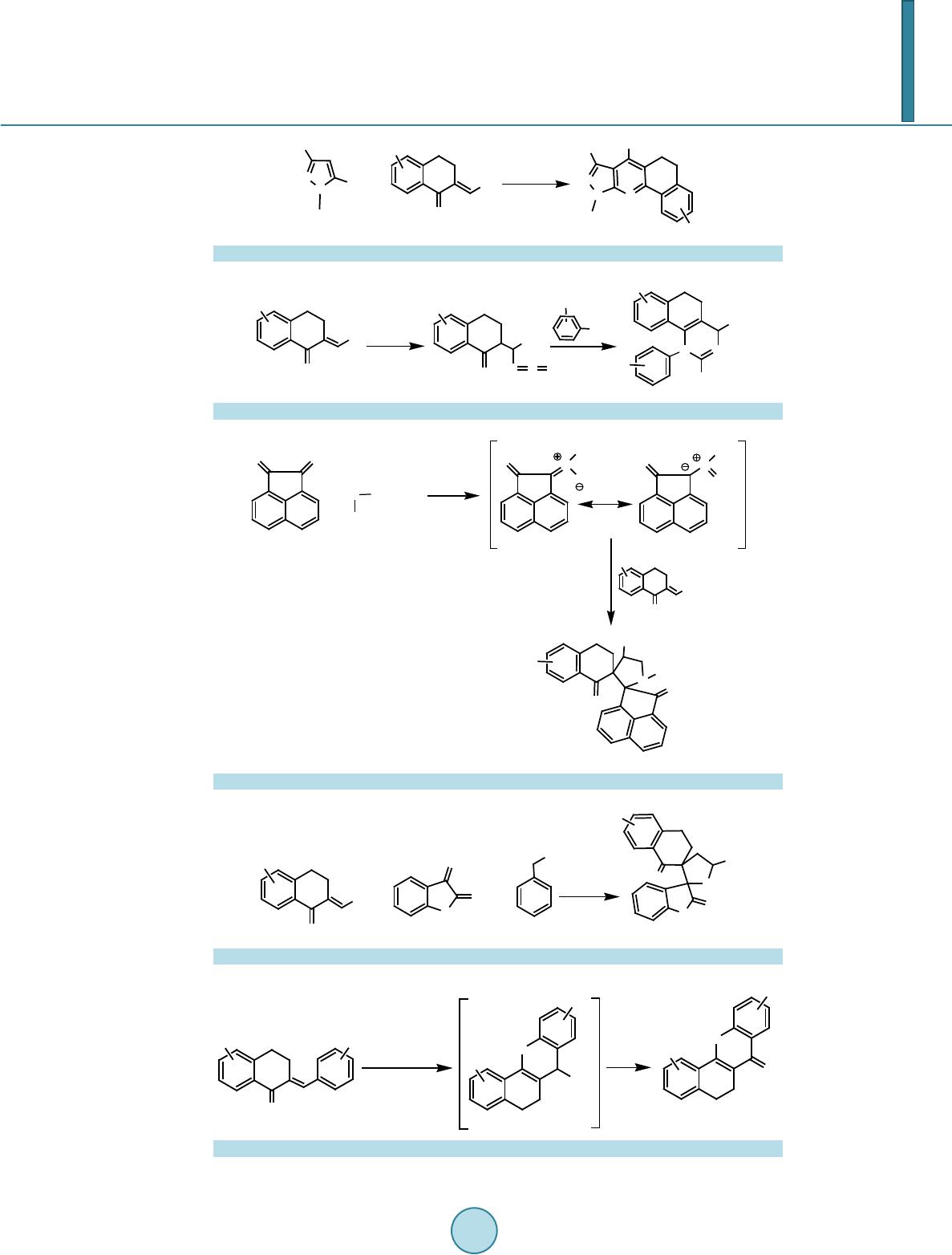 N. S. El-Gohary NNNH 2 Fusion NNN Ar O Ar 38 + Ar RR Ar 43 R R Scheme 18. Preparation of compounds 43. KNCS O Ar N C S O Ar 38 R1 NH2 NN SH Ar R1 44 45 R R R Scheme 19. Preparation of compounds 45. O O + HN CH3 CH2COOH N OCH3 CH2 N OCH3 CH2 O Ar 38 MeOH/H2O N OO CH3 Ar 4647 48 R R Scheme 20. Preparation of compounds 48. N H O OH NH 2 + O Ar 38 N H O NH Ar O 49 50 MeCN R R + Scheme 21. Preparation of compounds 50. O 38 hv, O2 rose BengalO OOH R1 R1O O R1 51 MeCN RR R Scheme 22. Preparation of compounds 51. 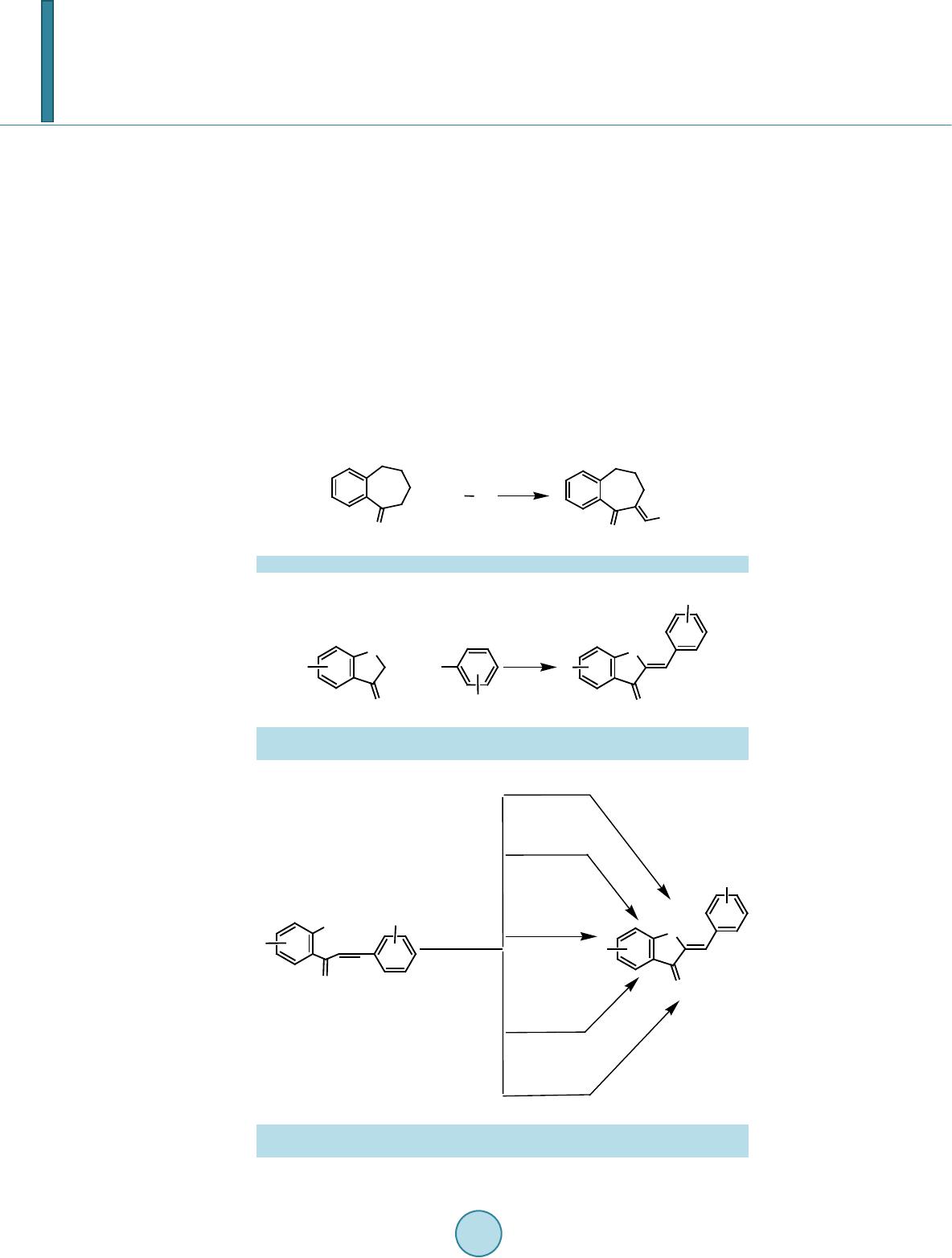 N. S. El-Gohary preparation. First, the Algar-Flynn-Oyamada reaction based on the oxidative cyclization of 2'-hydroxychalcones, where aurone is one of the products formed during preparation of 2'-hydroxychalcone [137]-[139]. Another procedure described by Donnelly and co-workers [140] [141] is based on bromomethylation of chalcones and 2'-acetoxychalcones followed by ring closure of the bromodihydro analogues providing aurones 55. However, none of these procedures can be considered as a rational method for the synthesis of aurones. The most common synthetic procedures for aurones 55 are based on the condensation of coumaran-3-ones 54 with substituted benzaldehydes in the presence of a catalyst. As catalyst, sodium hydroxide [142] [143], potassium hydroxide [144], anhydrous sodium acetate [145], sulfuric [145], hydrochloric [146], and phosphor ic acids [ 147] were used for this condensation (Scheme 24). Farkas et al. [148]-[150] performed the condensation of the ap- propriate coumaran-3-one 54 with substituted benzaldehydes in refluxing acetic anhydride to obtain aurones 55. Another synthetic procedure was developed for the prepa ration of aurones 55 through cyclization of 1-(2-hy- droxyphen yl)-3-(substituted phenyl)prop-2-en-1-ones 56 in methanol and in the presence of a catalytic amount of silver nitrate [151] (Scheme 25). In addition, other synthetic procedures were adopted for the preparation of aurones 55 through cyclization of 56 using mercuric acetate in pyridine [152] [153], mercuric acetate in polyethylene glycol (PEG-400) [154], mercuric acetate in dimethyl sulfoxide (DMSO) [155], and cupric bromide in DMSO [152] (Scheme 25). Scheme 23. Preparation of compounds 53. Scheme 24. Preparation of compounds 55 through condensation of coumaran-3- ones 54 with substituted benzaldehydes. Hg(OAc) 2 PEG-400 O R O R 1 55 56 OH R O R 1 Hg(OAc) 2 Pyridine Hg(OAc) 2 DMSO DMSO CuBr 2 MeOH AgNO 3 Scheme 25. Preparation of compounds 55 through cyclization of 1-(2-hydroxy- phenyl)-3-(substituted phenyl)prop-2-en-1-ones 56. 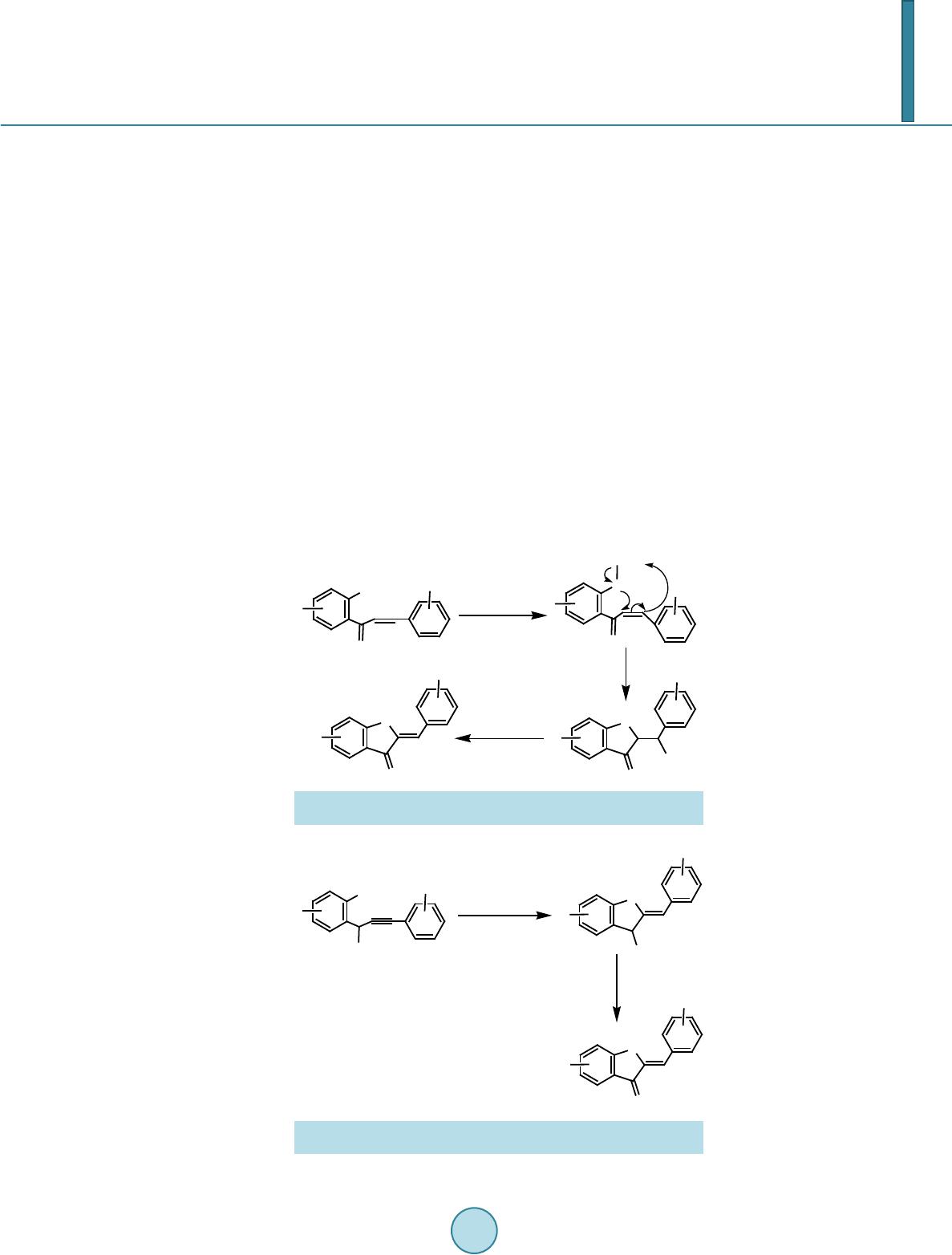 N. S. El-Gohary Mechanism of Cyclization Using Mercuric Acetate in Pyridine [152] The mechanism of cyclization of 56 into aurone deri va tives 55 is illustrated in Scheme 26. Furtherm ore, gold-catalyzed cyclization of alkynol derivatives 57 has become an efficient tool in the synthesis of aurones 55 and provided the best results under mild reaction conditions and excellent selectivities, avoiding the formation of flavones as byproducts [156] [157] (Scheme 27). 2.7. Synthesis of 1-Thioaurone Derivatives 1-Thioaurones 59 are synthetic thio analogues of the naturally-occurring aurones, their synthesis has already been published [158]-[162]. Condensation of 1-thiocoumaran-3-ones 58 with aromatic aldehydes in the presence of phospho ric acid [147] or piperidine [159] afforded 59. In addition, the same reaction was carried out in THF and in the presence of 1.5 equivalents of lithium diisopropylamide (LDA) at −10˚C [163] (Scheme 28). Moreover, a convenient one-step synthesis has been published [161], whereas, equimolar amounts of (2-me- thylthio)benzoic acid derivatives 60 and aromatic aldehydes were allowed to react with 2.0 equivalents of LDA in THF at 0˚C to yield 1-thioaurones 59 (Scheme 29). In 2010, Boughaleb et al. [162] described new synthetic pathway for the preparation of 1-thioaurones 59 (Scheme 30). Reactivity of Aurone and 1-Thioaurone Derivatives Reaction of 55 or 59 with 2-aminoth iophenol in ethanol and in the presence of sodium ethoxide gave the spiro compounds 61a, b. By the way of contrast, the 6,12-dihydrobenzofuro[2,3-c][1,5]benzothiazepines 62a and the O R O R 1 HgOAc O R O R 1 HgOAc O R O R 1 55 56 OH R O R 1 Hg(OAc) 2 Pyridine Scheme 26. Mechanism of cyclization of compounds 56 into aurone derivatives 55 using mercuric acetate in pyridine. OH R HO R 1 AuCl/ K 2 CO 3 , MeCN O R OH R 1 MnO 2 , CHCl 2 O R O R 1 57 55 Scheme 27. Preparation of compounds 55 through cyclization of al- kynol derivatives 57.  N. S. El-Gohary Scheme 28. Preparation of compounds 59 through condensation of 1-thiocoumaran-3-ones 58 with aromatic aldehydes . CH 3 S O S O Ar Ar OHC + OH 60 59 THF LDA RR Scheme 29. Preparation of compounds 59 through reaction of (2-methylthio)benzoic acid derivatives 60 with aromatic aldehydes. SH O S O Ar + OHClCH 2 COOH NaOH SCH 2 COOH O OH Ac 2 O AcOH S OCOCH 3 Ar OHC NaOH / N 2 59 RRR R Scheme 30. Preparation of compounds 59 starting from 2-mercaptobenzoic acid derivatives. 6,12-dihydrobenzothieno[2,3-c][1,5]benzothiazepines 62b were obtained in good yields v ia heating 55 or 59, respectively with 2-aminothiophenol in polyphosphoric acid (PPA) under nitrogen. Treatment of 62a, b with 2-chloroethyl-N,N-dimethylammonium chloride and potassium carbonate in ethyl acetate produced the annu- lated benzofuran and benzothiophene derivatives 63a, b. The tetracyclic derivatives 62a, b were deprotonated with sodium hydride in DMF to afford compounds 64a, b [164] (Scheme 31). Reaction of aurones 55 with hydrazine hydrate in ethanol gave the benzofuro[3,2-c]pyrazole derivatives 65. Refluxing aurones 55 with phenyl hydrazine in glacial acetic acid gave the benzofuro[3,2-c]pyrazole derivatives 66. In addition, benzofuro[3,2-c]isoxazole derivatives 67 were synthesized by the reaction of aurones 55 with hydroxylamine hydrochloride in alcoholic solution of potassium hydroxide. Furthermore, benzofuro[2,3-c]pyri - dine derivatives 68 were obtained through reaction of aurones 55 with a cetamide in alcoholic solution of potas- sium hydroxide. Finally, benzofuro[3,2-d]pyrimidine derivatives 69 were synthesized via reaction of aurones 55 with urea or thiourea in alcoholic solution of potassium hydroxide [165] (Scheme 32). 2.8. Synthesis of 3-Arylidene-4-Chromanone Derivatives The synthesis and chemical transformation of 3-arylidene-4-chromanones and related compounds received much attention due to the abundance of this moiety in many natural products and biologically active substances [166]-[169]. Thiochromones are synthetic compounds and some of their derivatives are reported to have medi- cinal uses [170] [171]. Current literature showed th at there has been an increasing trend towards the synthesis of heterocycles containing these two ring systems [172]. The synthesis of 3-arylidene-4-chromanones 71 is based on the condensation of 4-chromanones 70 with aro- matic aldehydes in the presence of a catalyst (Scheme 33). Acid-catalyzed condensation (H2SO4, H3PO4 or HCl) of the two components was accomplished [173]-[180]. In addition, Farkas et al. [181]-[183] performed the same reaction in hot acetic anhydride, which is a very simple and convenient method, but sometimes it requires a pro- longed time. Another procedure used for the synthesis of 71 is the base catalyzed condensation of 4-chroma- nones 70 with aromatic aldehydes using sodium hydroxide [184], sodium methoxide [185], anhydrous potas- sium acetate [186], piperidine [187]-[189], or pyrrolidine [190]. A new synthetic method for 71 was through 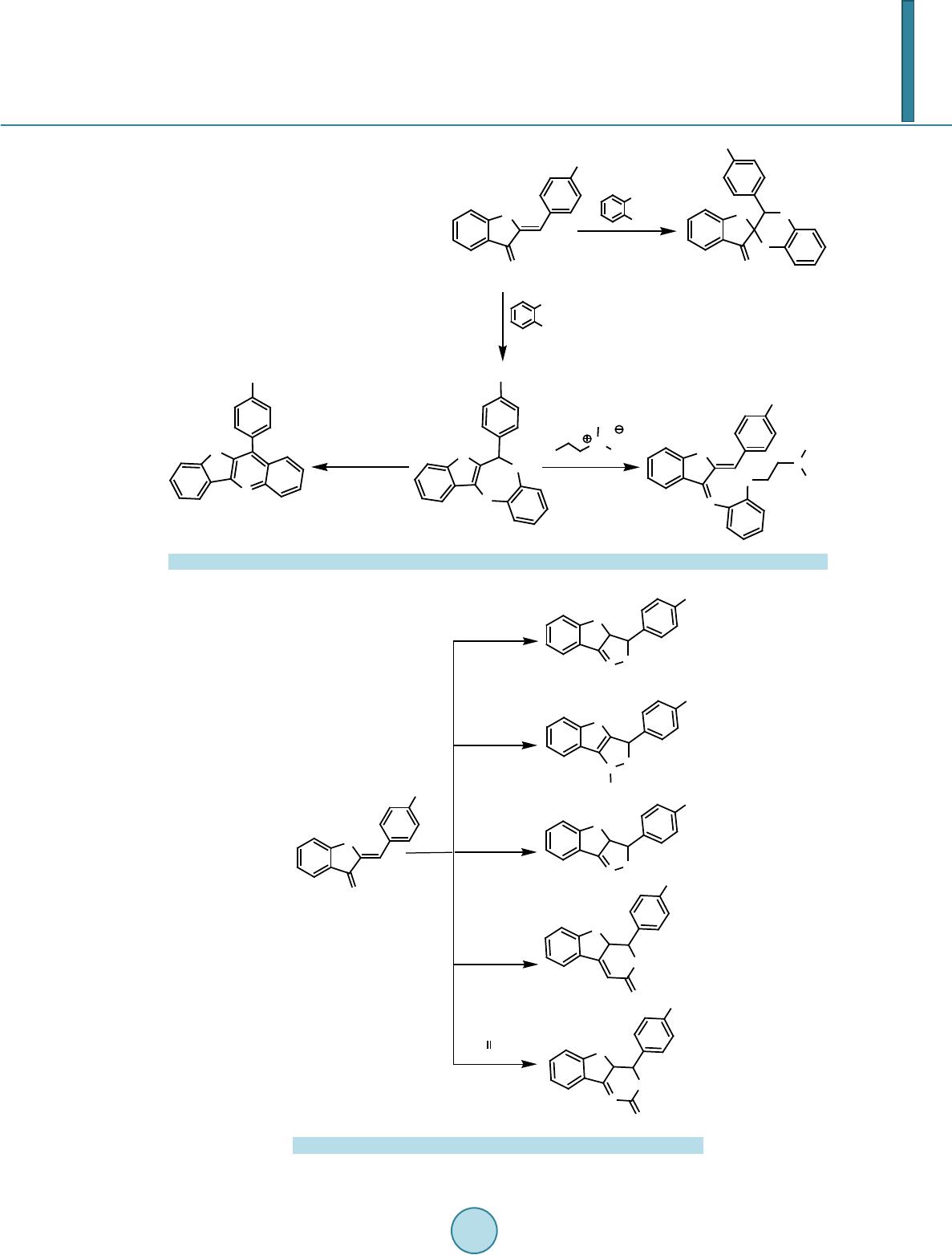 N. S. El-Gohary X O R NH2 SH X O S NH R X HN S R NH Cl CH 3 CH 3 Cl X N R S N CH 3 CH 3 X N R NaOEt NH2 SH PPA / N 2 NaH / DMF 55: X=O 59: X=S 61a,b 62a,b 63a,b 64a,b K 2 CO 3 / EtOAc Scheme 31. Preparation of compounds 61-64. O O R 55 NH 2 NH 2 .H 2 O NH 2 NHph NH 2 OH.HCl CH 3 CONH 2 NH 2 CNH 2 X O 65 NNH R O 66 NNH R ph O 67 NO R O NH O R 68 O N NH X R 69 X = O; S Scheme 32. Preparation of compounds 65-69.  N. S. El-Gohary condensation of different aromatic aldehydes with 4-chromanones 70 using amberlyst-15 as a catalyst under mi- crowave irradiation in solvent-free conditions [191]. However, it should be mentioned that in case of using pipe- ridine as a catalyst, an exo-endo double bond migration takes place if the aldehyde has strong electron-with- drawing substituents [188] [192]. In such a case, 3-arylmethyl-4-chromenone (homoisoflavone) 72 is the prod- uct instead of the expected 3-arylidene-4-chromanone 71 (Scheme 34). Basavaiah et al. [107] [193] synthesized 3-arylidene-4-chromanones 71 by ring closure of the acrylic acid derivatives 73 with TFAA in methylene chlo- ride (Scheme 35). Reactivity of 3-Arylidene-4-Chromanone Derivatives Refluxing a solution of 3-arylidene-4-chromanone 71, isatin (49) and sarcosine (74) afforded 4-ar yl -N-me - thyl-spiro[2.3'](2-oxoindoline)-spiro[3.3'' ](substituted 4-chromanone)pyrrolidines 75 [194] (Scheme 36). Whe- reas, refluxing a solution of 71, isatin (49) and L-proline (76) in aqueous methanol gave 4-aryl-spiro[2.3'](2- oxoindoline)-spiro[3.3'']-(substituted 4-chromanone)hexahydropyrrolizines 77. The reaction proceeded via for- mation of an azomethine ylide which readily undergoes 1,3-dipolar cycloaddition reaction with 3-arylidene-4- chromanones to give a single cycloadduct [194] (Scheme 36). 2.9. Synthesis of 3-Arylidene-1-Thio-4-Chromanone Derivatives The synthesis of 3-arylidene-1-thio-4-chromanones 79 is based on the condensation of 1-thio-4-chromanones 78 with aromatic aldehydes under acidic conditions [195]-[199]. The same condensation was accomplished using piperidine as a catalyst [187]-[189], or amberlyst-15 under microwave irradiation [191] (Scheme 37). As de- scribed for the condensation of 4-chromanone 70 with aromatic aldehydes [187] [188], in case of aromatic al- dehydes bearing strongly electron-withdrawing substituents, an exo-endo double bond transposition also takes place, resulting in the formation of 3-arylmethyl-1-thio-4-chromenones 80 instead of 3-arylidene-1-thio-4- chromanones 79 [188] (Scheme 38). 2.10. Synthesis of 3-Arylideneflavanone Derivatives 3-Arylideneflavanones (flavindognides) 82 are well known flavanone derivatives. They were first synthesized by Katschalowsky and von Kostanecki in 1904 [200]. They wer e also synthes ized by the acid -catalyzed cond ensation Scheme 33. Preparation of compounds 71 through condensa- tion of 4-chromanones 70 with aromatic aldehydes. O O Ar OHC O O Ar + RR 7072 ArCHO = Aromatic aldehydes substituted with electron-withdrawing groups Piperidine Scheme 34. Preparation of compounds 72. O O Ar R 71 73 TFAA CH 2 Cl 2 HOOC O Ar R Scheme 35. Preparation of compounds 71 through cyclization of acrylic acid derivatives 73 with TFAA. 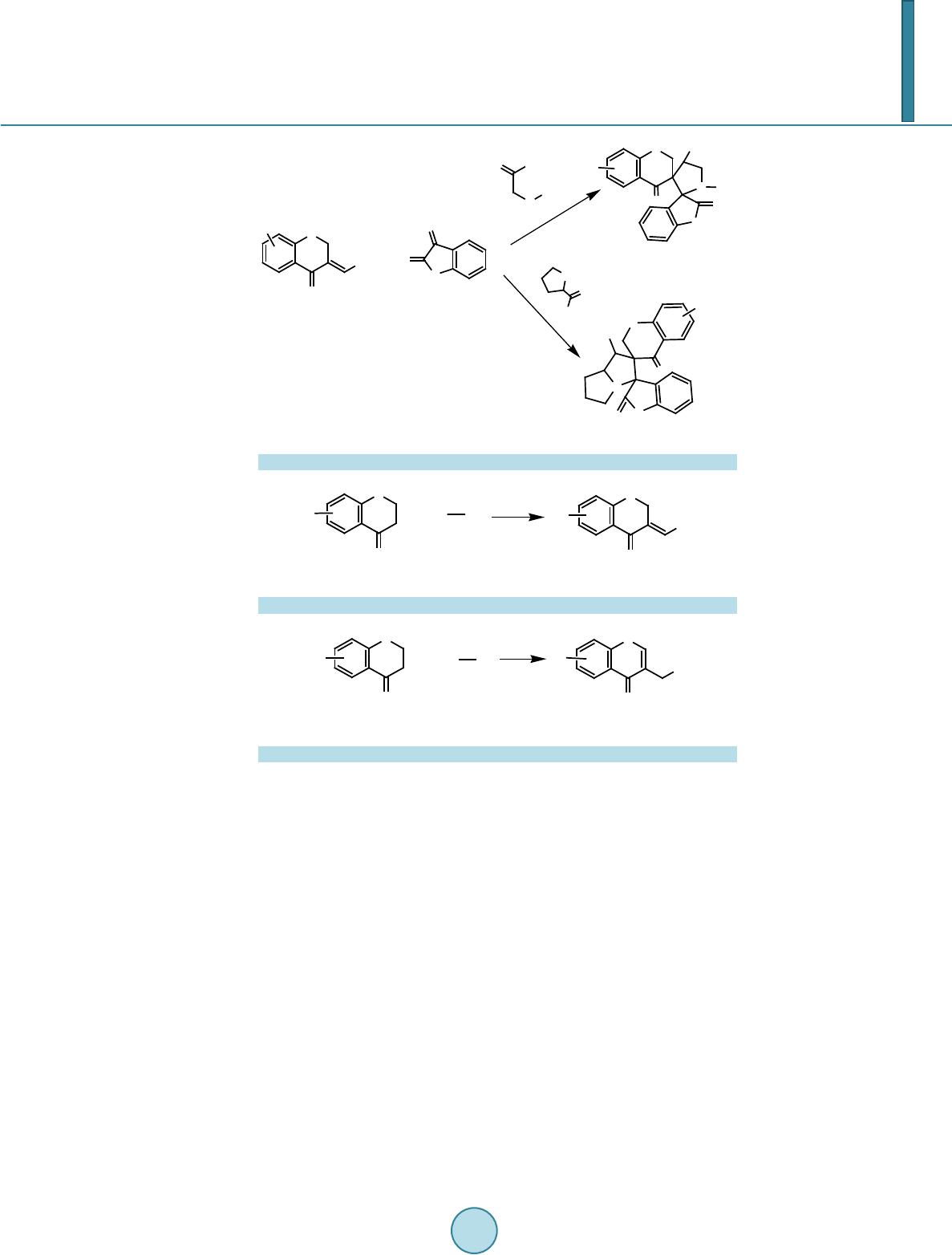 N. S. El-Gohary N H O O OH O N H CH 3 O O Ar MeOH / H 2 O NH N O OO CH 3 Ar + NH O HO O N Ar O N H O MeOH / H 2 O R R R 71 49 74 76 75 77 Scheme 36. Preparation of compounds 75 and 77. S O ArOHC S O Ar + 78 79 R R ArCHO = Aromatic aldehydes substituted with electron-donating groups Scheme 37. Preparation of compounds 79. ArCHO = Aromatic aldehydes substituted with electron-withdrawing groups S O Ar OHC S O Ar + 78 80 R R Scheme 38. Preparation of compounds 80. of flavanones 81 with aromatic aldehydes [200]-[204] (Scheme 39). In addition, glycine was described as a ca- talyst for this condens ation [205]. It was reported that in some cases the base catalyzed condensation of hydrox- yacetophenone with benzaldehyde gave 3-benzylideneflavanone as a coproduct of the corresponding hydroxy- chalcone [206]-[208]. Furthermore, the synthesis of 82 via base-catalyzed condensation of flavanone 81 with aromatic aldehydes was reported [189] [209]. It is worth mentioning that if aldehydes with strong electron-with- drawing substituents are used, 3-arylmethylflavones 83 are obtained instead of 3-arylideneflavanones 82 [210] (Scheme 40). 3-Arylmethylflavones 83 w ere also obtained via treatment of 82 with pyridinium chlorochromate (PCC) (5.0 equivalent) in DMF [211] (Scheme 41). 2.11. Synthesis of 3-Arylidene-1-Thioflavanone Derivatives 3-Arylidene-1-thioflavanones 85 were synthesized by the acid-catalyzed condensation of 1-thioflavanones 84 with aromatic aldehyd es [212] [213] (Scheme 42). Also, b ase catalyzed condensation of thioflavanones 84 with aromatic aldehydes using piperidine was reported [214]. However, this procedure can be used only for the syn- thesis of 3-aryliden e -1-thioflavanones substituted with electron-donating or slightly electron-withdrawing sub- stituents in the aryliden e moiety. When aromatic aldeh ydes substituted with strongly electron-with drawing sub- stituents were used, 3-arylmethyl-1-thioflavones 86 were obtained [214] [215] (Scheme 43). Reactivity of 3-Arylidene-1-Thioflavanone Derivatives Reaction of 3-arylid ene-1-thioflavanones 85 with sodium oxychloride and hydrogen peroxide gave 3-arylidene-  N. S. El-Gohary ArCHO = Aromatic aldehydes substituted with electron-donating groups Ar OHC + O O R R 1 O O R R 1 Ar 81 82 Scheme 39. Preparation of compounds 82 through condensation of flavanones 81 with aromatic aldehydes substituted with elec- tron-donating groups. ArCHO = Aromatic aldehydes substituted with electron-withdrawing groups + O O R R1 81 83 O R R1 Ar Ar OHC O Scheme 40. Preparation of compounds 83 through condensation of flavanones 81 with aromatic aldehydes substituted with strong electron-withdrawing groups. O O R R 1 Ar 82 83 O R R 1 Ar O PCC (5 equiv.) DMF, 40 o C Scheme 41. Preparation of compounds 83 through treatment of 3-arylideneflavanones 82 with pyridinium chlorochromate (PCC). Ar OHC + O S R R 1 O S R R 1 Ar 84 85 ArCHO = Aromatic aldehydes substituted with electron-donating groups Scheme 42. Preparation of compounds 85 through condensation of 1-thioflavanones 84 with aromatic aldehydes substituted with electron-donating groups. + O S R R 1 84 86 S R R 1 Ar Ar OHC ArCHO = Aromatic aldehydes substituted with electron-withdrawing groups O Scheme 43. Preparation of compounds 86 through condensation of 1-thioflavanones 84 with aromatic aldehydes substituted with strong electron-withdrawing groups. 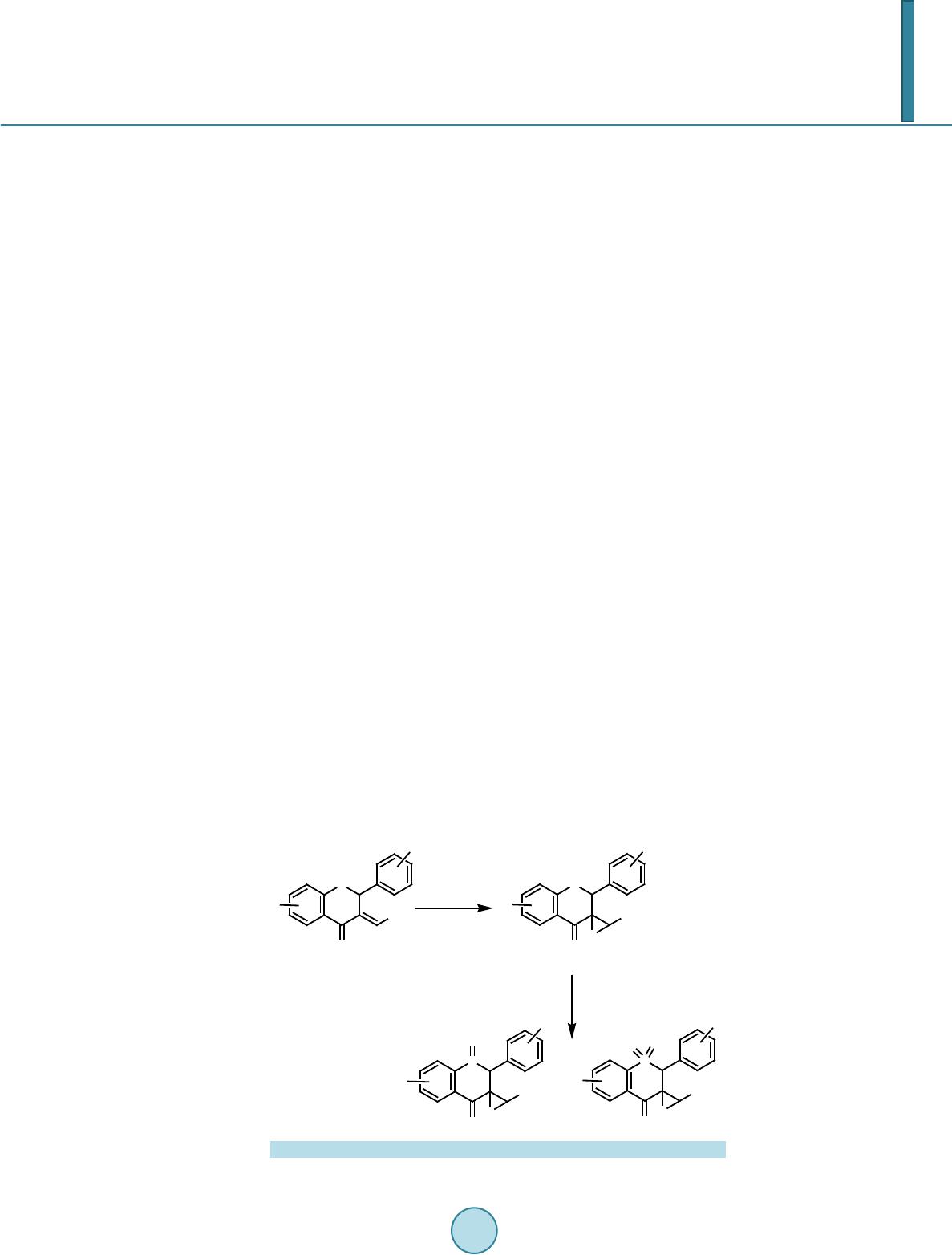 N. S. El-Gohary 1-thioflavanone epoxides 87 [216]. Reaction of epoxide derivatives 87 with dimethyldioxirane (DMD) yielded the sulfoxide and sulfone derivatives 88 and 89 [216] (Scheme 44). 2.12. Synthesis of Arylideneaniline Derivatives (Schiff Bases) Schiff bases are typically formed by the condensation of primary amines with aldehydes. Schiff b as es a r e i mpo r- tant intermediates for the synthesis of various bioactive compounds. Literature survey revealed that these com- pounds have been associated with diverse chemotherapeutic activities, including antimalarial [217], anticancer [218], antibacterial [219], antifungal [220], antitubercular [221], ant i -inflammatory [222], antimicrobial [222] and antiviral [223] activities. On the other hand, they are fundamental materials for the synthesis of various Schiff base ligands which are used as chiral auxiliaries in asymmetric synthesis [224]. Metal complex Schiff bases have also been used in oxidation reactions [225]. 2.12.1. Various Reaction Conditions Have Been Used in the Synthesis of Schiff Bases Schiff bases are compounds containing an azomethine group (-C=N-). They are usually formed by condensation of primary amines with carbonyl compounds according to the following equation [226]; R-NH2 + R1-CHO → R-N = CH-R1 + H2O, where R, R1 may be an aliphatic or aromatic group. Schiff bases of aromatic aldehydes have an effective conjugated system and are more stable [227]. They are prepared under various reaction condi- tions, the use of organic solvents such as THF and 1,2-dichloroethane (DCE) was reported [228]. The reaction was also carried out in ethanol at room temper ature [229] [230], in refluxing ethanol [231], in refluxing ethanol and in the presence of a catalytic amount of glacial acetic acid [222] [232], in refluxing methanol and in the presence of a catalytic amount of glacial acetic acid [233], in methanol at room temperature and in the presence of a catalytic amount of concentrated hydrochloric acid [234], in refluxing ethanol and in the presence of a cata- lytic amount of concentrated sulfuric acid [235], in refluxing mixture of ethanol/dioxane and in the presence of a catalytic amount of glacial acetic acid [236], in refluxing ethanol and in the presence of a catalytic amount of anhydrous zinc chloride [237], in refluxing benzene [238], in dichloromethane (DCM) at room temperature and in the presence of anhydrous magnesium sulfate [238], using DCM and a catalytic amount of neutral alumina under microwave irradiation [238], under solvent-free conditions in the presence of lemon juice as natural acid catalyst [239], in refluxing methanol and in the presence of a catalytic amount of nickel nitrate [240], and using phosphorus pentoxide/silica gel (P2O5/SiO2) [241]. In addition, a green and efficient method for the synthesis of Schiff bases in aqueous media was described [242]. 2.12.2. Mechanism Concerning the mechanism of the transformation of aldehydes and amines into Schiff bases 90, two possible pathways are illustrated (Scheme 45 an d S cheme 46) [239]. In S cheme 45, th ere is nucleophilic attack of a p ri- mary amine on carbonyl carbon that affords hydroxyl compound which on dehydration gives Schiff bases. The O S R R 1 Ar 85 i. NaOCl ii. H 2 O 2 /NaOH O S R R 1 Ar 87 O DMD O S R R 1 Ar 89 O O S R R 1 Ar 88 O + OOO Scheme 44. Preparation of compounds 87-89.  N. S. El-Gohary Aryl or heteroaryl H 2 N H O RNAryl or heteroaryl R OH H H H -H 2 O NAryl or heteroaryl R 90 + Scheme 45. Mechanism of condensation of benzaldehyde derivatives with primary amines without using Lewis acid as a catalyst. NAryl or heteroaryl R O H O H Lewis acid Aryl or heteroaryl H 2 N NAryl or heteroaryl R HO H H NAryl or heteroaryl R OH H H Lewis acid Lewis acid Lewis acid Lewis acid Lewis acid -H 2 O 90 R R Scheme 46. Mechanism of condensation of benzaldehyde derivatives with primary amines using Lewis acid as a catalyst. formation of Schiff bases 90 in this method largely depends on the rate of removal of water from the reaction mixture. Originally, the classical synthetic route for preparation of Schiff bases was reported by Schiff [243] which involves the condensation of primary amines with carbonyl compounds under azeotropic distillation [244] with the simultaneous removal of water. The removal of water during this condensation was conventionally fa- cilitated by using molecular sieves [245] or a Dean-Stark apparatus [246]. In literature, the removal of water in situ has been accomplished by using dehydrating solvents such as tetramethyl orthosilicate [247] and trimethyl orthoformate [248] [249]. To overcome the difficulties in the removal of water, an alternative method has been employed in which Lewis acid is used as a catalyst that accelerates nucleophilic attack of amines on carbonyl carbon as well as serv- ing as a dehydrating agent for removal of water in the second step (Scheme 46). Several modified methods for synthesis of Schiff bases have been reported in literature in which Lewis acids were used as catalysts such as ZnCl2 [250], TiCl4 [251], alumina [252], P2O5 [253] and also by us i ng hydrotalcite [254]. 2.12.3. Reactivity of Schiff Bases Schiff bases are important intermediates for the synthesis of many heterocyclic compounds. Condensation of 90 with indole in basic medium afforded N-substituted indoles 91 [255]-[258]. The thiazolidin-4-one derivatives 92a,b were obtained via reaction of 90 with thioglycolic [259]-[268] and thiolactic acids [269], respectively. Reaction of Schiff bases 90 with chloroacetyl chloride in dioxane and in the presence of triethylamine gave chloroacetamido derivatives 93 [266] or the azetidin-2-ones 94 [265] [270]. Similarly, reaction of 91 with phe- nylacetyl chloride in dioxane and in the presence of triethylamine produced the azetidinones 95 [271]. The pyr- rol-2-one derivatives 96 can be synthesized by reaction of 90 with maleic anhydride [272]-[275] (Scheme 47). 2.13. Synthesis of Arylidenemalononitrile Derivatives The Knoevenagel reaction is the most simple and straightforward method used to produce the substituted al- kenes [276]. Classically, the process consists of condensation of aldehydes or ketones with active methylene  N. S. El-Gohary NAryl or heteroaryl R 90 N H NAryl or heteroaryl R 91 H N NAryl or heteroaryl OCl R 94 ClCOCH 2 Cl NAryl or heteroaryl R SO 92a: R 1 = H 92b: R 1 = CH 3 H C R 1 HS COOH R 1 NAryl or heteroaryl OCl R 93 ClCOCH 2 Cl O OONAryl or heteroaryl R O 96 CH 2 COCl NAryl or heteroaryl O R 95 Scheme 47. Preparation of compounds 91-96. compounds in the presence of a variety of reagents. Several bases [276]-[279], Lewis acids [280] [281] or hete- rogeneous media [282]-[289] were used as catalysts in Knoevenagel condensation reaction for the synthesis of arylidenemalononitriles 97. In addition, a simple and more efficient procedure was developed for the condensa- tion of malononitrile with aromatic, heteroaromatic and aliphatic aldehydes in water [290] (Scheme 48). Reactivity of Arylidenemalononitrile Derivatives The arylidenemalononitr iles 97 are useful intermediates for the synthesis of a variety o f hetero cyclic co mpounds, 2-aminobenzo[h]chromene-3-carbonitrile derivatives 98 were synthesized via condensation of 97 with α-n aph - thol in the presence of Mg/Al hydrotalcite under single-mode microwave irradiation [291] (Sch eme 49). On the other hand, 3-aminobenzo[f]chromene-2-carbonitrile derivatives 99 were obtained through condensation of 97 with β-naphthol [292] (Scheme 49). Pyrano[3,2 -c]chromenes 100 were prepared by heating 4-hydroxycoumarin with 97 in pyridine [293], in ethanol and in the presence of triethylamine as a catalyst [294] or in water [295] (Scheme 49). Acid hydrolysis of pyrano[3,2-c]chromenes 100 produced compound 101, which is subsequently transformed into warfarin 102 (Ar = phenyl) [293] [296]-[298] (Scheme 50). Several pyrano[3,2-c]quinolines 103 were prepared via reaction of 4-hydroxyquinolin-2(1H)-ones with arylidenemalononitriles 97 [299] [300] (Scheme 49). Three component reaction between arylidenemalononitriles 97, 1,3 -indanedione and thioglycolic ac- id under microwave irradiation afforded indeno[1,2-b]pyridine derivatives 104 [301] (Scheme 49). The analogous three-component reaction of 97 with 1,3-indanedione and 4-methylbenzenethiol, or aromatic amine under micro- wave irradiation afforded indeno[1,2-b]pyridines 105 [301] (Scheme 49). A series of dihydropyrrolo[1,2-f]phe- nanthridines 106 was prepared via reaction between 97, isocyanides and phenanthridine in dry diethyl ether [302] 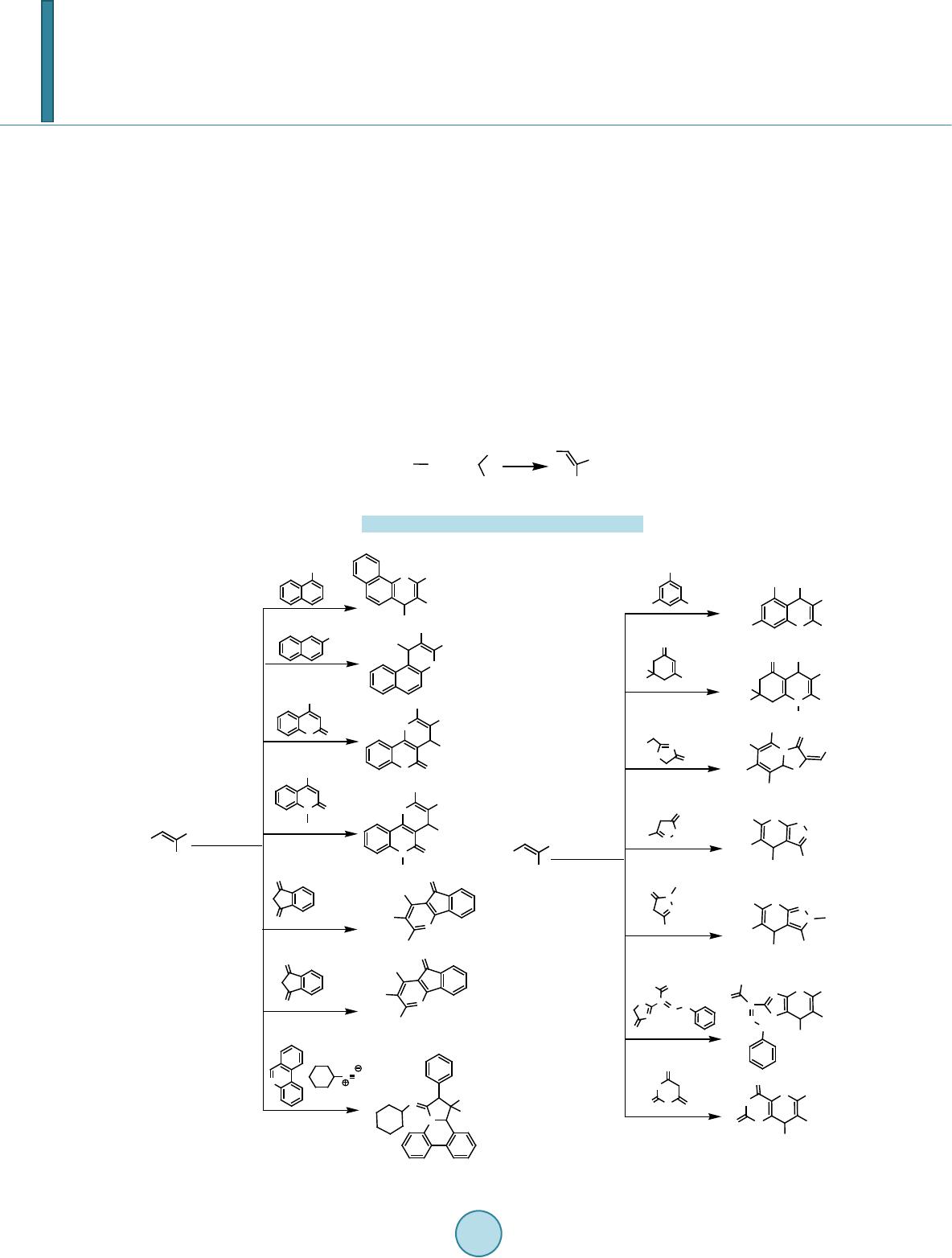 N. S. El-Gohary (Scheme 49). Condensation of 97 with 5-methylresorcinol monohydrate in ethanol afforded the chromene deri- vatives 107 [303] (Scheme 49). Hexahydroquinolin-5-ones 108 were synthesized through reaction of 3-ami no- cyclohex-2-en-1-ones with 97 [304] (Scheme 49). The thiazolopyridine derivatives 109 were obtained using 2:1 molar ratio of 97 and 2-(4,5-dihydro-4-oxothiazol-2-yl)acetonitrile or ethyl 2-(4,5-dihydro-4-oxothiazol-2- yl)acetate [305] [306] (Scheme 49). Reaction of 2-isoxazolin-5-ones with 97 was reported to yield pyrazo- lo[2,3-c]isoxazole derivatives 110 [307] (Scheme 49). Condensation of 97 with 3-methylpyrazo l-5-ones gave the pyranopyrazole derivatives 111 [292] (Scheme 49). Whereas, pyrano[2,3-d]thiazole derivatives 112 were pre- pared through reaction of 97 with α-(4 -oxothiazolin-2-yl)-α-phenylhydrazonoacetamide [308] (Scheme 49). Condensation of 97 with barbituric or thiobarbituric acid afforded the corresponding pyrano[2,3-d]pyrimidine derivatives 113 [308] (Scheme 49). In addition, the pyrido[1,2-a]quinazoline derivatives 114 were synthesized via condensation of 97 with 2-(2-cyanoacetamido)benzoic acid [309] (Scheme 49). It was found that 3-phenyl- 2-thiohydantoin rea c t s wi th 97 to give the corresponding pyrrolo[1,2-c]imidazole derivatives 115 [310] (Scheme 49). Reaction of 3-oxo-3-phenyl-N-(pyridin-3-yl)propanamide with 97 in ethanol gave tetrahydropyridines 116 [311] (Scheme 49). In addition, 6-acetyl-3-amino-2,5-diphenyl-2,3,4,5-tetrahydropyridazine-4-carbonitrile de- rivatives 117 were obtained through reaction of 97 with 1-(phenylhydrazono)propan-2-one in pyridine [312] Scheme 48. Preparation of compounds 97. Ar CN CN 97 98 99 OH O Ar NH 2 CN OH O Ar CN NH 2 O OH O O O NH 2 CN Ar O 100 104 O OHSCH 2 COOH + O N Ar NC HOOCH 2 CS 105 O N Ar NC RX X=S; NH, R=alkyl; aryl O OHXR + NN C + 106 NCN CN N N OH O R N O NH 2 CN Ar O 103 R 107 O CN Ar NH 2 CH 3 HO CH 3 OHHO 108 O NHR 1 R R N O R R Ar CN NH 2 R 1 N SO X S N X Ar X Ar NH 2 O 109 N N CH 3 R O R = H; C 6 H 5 N S O CNH N O H 2 N N S ONH 2 CN Ar 112 C NNH O NH 2 NO R O N O O H 2 N NC Ar R 110 R = H; C 6 H 5 N N O H 2 N NC Ar CH 3 R 111 ONH 2 CN Ar HN N H X O X = O; S HN N H O XO113 X = CN; COOEt Ar CN CN 97 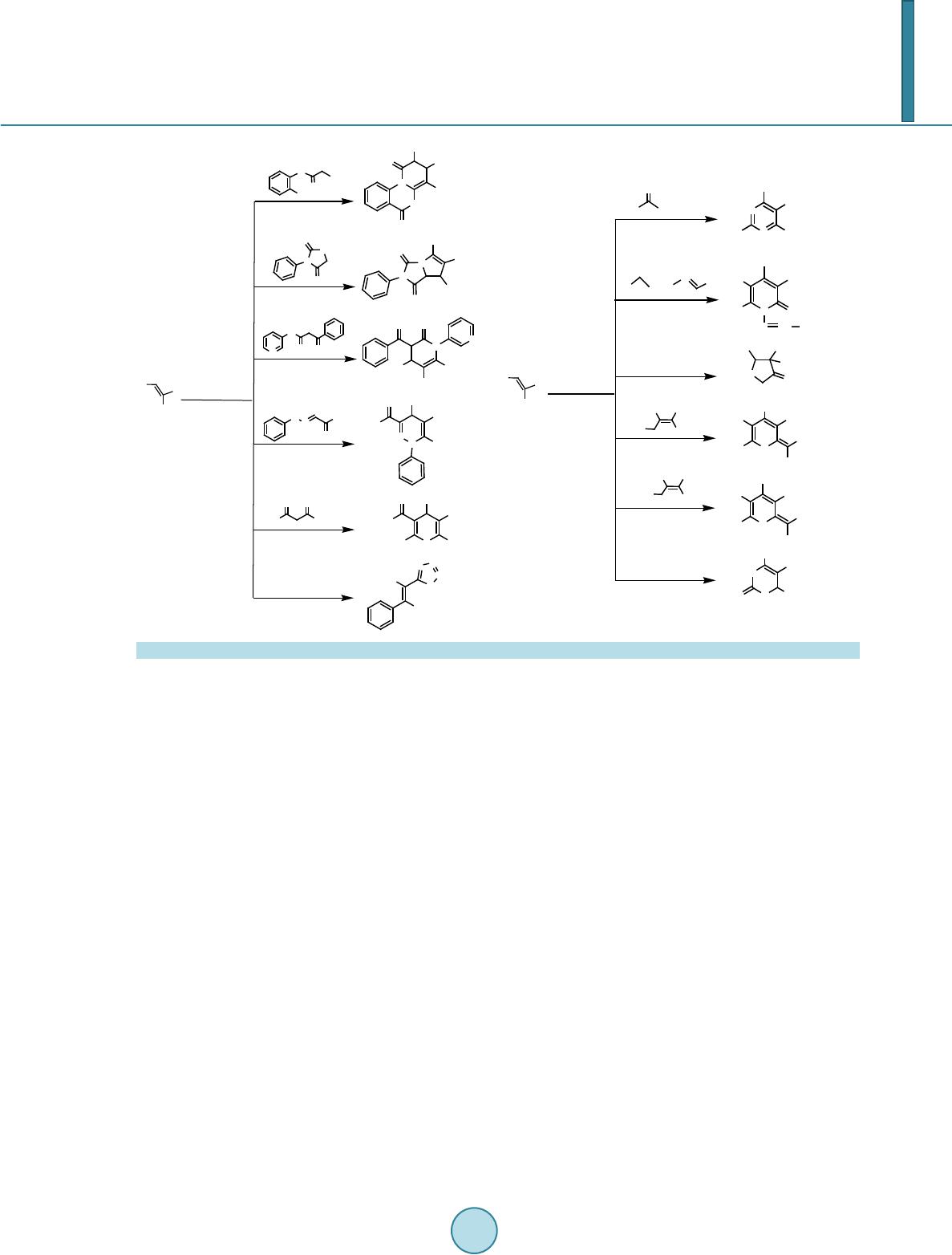 N. S. El-Gohary Ar CN CN 97 COOH H NCN O NH N O CN Ar CN O 114 NH N O S N N O SNH 2 CN Ar 115 116 N H N OON NH 2 O O Ar N CN H NNCH 3 ONN CN NH 2 Ar H 3 C O 117 118 H 3 COC 2 H 5 O O O CN NH 2 Ar C 2 H 5 O O H 3 C 119 H NC N H N N N NaN 3 RNH2 NH .HCl N N CN NH2 Ar R120 NC CONH NAr1 N O NCH Ar1 Ar CN NC H2N121 SO CN CN Ar 122 HSCH2COOH CN CN H 2 N NC CN COOC 2 H 5 H 2 N C 2 H 5 OOC N H Ar NC H2N COOC2H5 COOC2H5 CN N H Ar NC H2N CN CN CN 123 124 NH2CSNH2 HN N H Ar S CN NH2 125 Ar CN CN 97 Scheme 49. Preparation of compounds 98-100 and 103-125. (Scheme 49). Reaction of 97, ethyl acetoacetate and aqueous solution of ammonium hydroxide afforded 4H- pyran derivatives 118 [313] (Scheme 49). Tetrazoles 119 have been prepared through reaction of 97 with so- dium azide in water [314] (Scheme 49). Micheal additions of arylidenemalononitriles 97 with amidines in re- fluxing acetonitrile and in the presence of a catalytic amount of magnesium oxide produced the pyrimidine de- rivatives 120 [289] (Scheme 49). Reaction of 97 with hydrazide-hydrazone derivatives in dioxane and in the presence of triethylamine as a catalyst gave 6-amino-2-oxopyridine-3,5-dicarbonitriles 121 [315] (Scheme 49). The synthesis of thiophene derivatives 122 was accomplished through the condensation of 97 with thioglycolic acid [316] [317] (Scheme 49). 2-Ami no-1,1,3-tricyanoprop-2-ene reacts with 97 to yield the pyridine deriva- tives 123 [318] [319] (Scheme 49). Similary, diethyl 3-amino-2-cyanopent-2-ene-1,5-dicarboxylate was reacted with 97 to yield the pyridine derivatives 124 [319] [320] (Scheme 49). Treatment of 97 with thiourea in DMF and in the presence of a catalytic amount of piperidine resulted in the formation of the thioxopyrimidine deriva- tives 125 [321] (Scheme 49). Reaction of arylidenemalononitriles 97 with 2-cyanothioacetamide in ethanol and in the presence of piperi- dine as a basic catalyst afforded 1,6-dihydro-6-thioxopyridine-2,3,5-tricarbonitriles 126. Reaction of thioxopy- ridines 126 with (2-acetoxyethoxy)methyl bromide in DMF and in the presence of sodium hydride afforded 6-[(2-acetoxyethoxy)methylthio]pyridine-2,3,5-tricarbonitriles 127 that is further reacted with ammonia in me- thanol to produce 6-[(2-hydroxyethoxy)methylthio]pyridine-2,3,5-tricarbonitriles 128. Reaction of 126 with ethoxymethyl chloride in DMF and in the presence of sodium hydride gave 6-(ethoxymethylthio)pyridine-2,3,5- tricarbonitriles 129 [322] (Scheme 51). It was reported that thermal Michael addition reaction takes place when 6,7-dimethoxyisochromanone 130 was treated with arylidenemalononitriles 97 at 190˚C to afford 131 which underwent elimination of malononi- trile producing 132 [323] (Scheme 52). 2.14. Synthesis of Diethyl Arylidenemalonate Derivatives Diethyl arylidenemalonates 133 are easily accessible by Knoevenagel condensation [324] [325] (Scheme 53).  N. S. El-Gohary 100 O O NH 2 CN Ar OO ArOH OCOOH O ArOH O CH 3 O H 101 102 Scheme 50. Preparation of compounds 101 and 102. Ar CN CN + CN NH 2 S N H Ar CNNC NC SN Ar CNNC NC S O AcO N Ar CNNC NC S O Piperidine O AcO Br Cl O NaH/DMF NaH/DMF NH 3 /MeOH N Ar CNNC NC S O HO 97 126 127 128 129 EtOH Scheme 51. Preparation of compounds 126-129. Ar CN CN 97 O O + 130 MeO MeO O O 131 MeO MeO Ar CN NC 190 o C O O 132 MeO MeO Ar CN CN - Scheme 52. Preparation of compounds 132. Ar CHO COOEt COOEt + Ar COOEt COOEt 133 Scheme 53. Preparation of compounds 133. Various reaction conditions were reported for the preparation of diethyl arylidenemalonates 133. The reaction was performed in water or ethanol without catalyst [326], in refluxing dry xylene and in the presence of a cata- lytic amount of piperidine/glacial acetic acid (3:1) [327], in refluxing ethanol and in the presence of a catalytic amount of piperidine/glacial acetic acid (2:1) [328] or in refluxing pyridine [329]. In addition, Knoevenagel condensations of benzaldehyde or substituted benzaldehydes with diethyl malonate was carried out in Lewis acidic 1-butyl-3-methylimidazolium chloroaluminate, [bmim]Cl∙xAlCl3 and 1-butylpyridinium chloroaluminate,  N. S. El-Gohary [bpy]Cl∙xAlCl3 ionic liquids [330]. Reactivity of Diethyl Arylidenemalonate Derivatives Reaction of diethyl arylidenemalonates 133 with indole 134 in isobutanol at room temperature, employing Cu(OTf)2-bis(oxazoline) complexes under nitrogen afforded ethyl 3-aryl-2-etho xycarbon yl-3-(3-indolyl) propanoates 135 [331] (Scheme 54). Reaction of diethyl 4-methoxybenzylidenemalonate 136 with but-2-yne- 1,4-diol 137 in the presence of sodium hydride (NaH) in THF at room temperature for five minutes afforded ethyl 3-(4-methoxyphenyl)-4-oxo-3,3a,4,6-tetrahydro-1H-furo[3,4-c]pyran-3a-carboxylate 138 [332]-[335] (Scheme 55). 2.15. Synthesis of Ethyl Arylidenecyanoacetate Derivatives Ethyl arylidenecyanoacetates 139 are prepared via Knoevenagel condensation of aldehydes with ethyl cyano- acetate (Scheme 56). Several publications were reported for the synthesis of ethyl arylidenecyanoacetates. The reaction was carried out in aqueous medium at room temperature [336], in refluxing ethanol and in the presence of piperidine/glacial acetic acid (2:1) [328], in refluxing ethanol and in the presence of Trizma [337]. Also , this condensation was performed in ethanol/water mixture and in the presence of sodium or potassium hydroxide at 50˚C - 60˚C [279]. The same reaction was carried out using magnesium bromide diethyl etherate (MgBr2∙OEt2) as Lewis acid in the presence of triethylamine [338]. In addition, poly(4-methyl vinylpyridinium hydroxide)/ SBA-15, a novel basic polymeric composite was applied as a recyclable catalyst for the Knoevenagel condensa- tion reaction of aromatic alde hydes with ethyl cyanoacetate in water at 95˚C [339]. Furthermore, they were pre- pared via heating a mixture of aldehyde and ethyl cyanoacetate at 80˚C - 85˚C in an oil bath and in the presence of rare earth triflates as Yb(OTf)3 [340]. The same reaction was performed in distilled water and in the presence of hydroxyapatite supported caesium carbonate as a recyclable solid base catalyst (HAP-Cs2CO3) [278] or under microwave irradiation [341]. Reactivity of Ethyl Arylidenecyanoacetate Derivatives The thiazolopyridine derivatives 109 were also obtained using 2:1 molar ratio of ethyl arylidenecyanoacetates 139 and 2-(4,5-dihydro-4-oxothiazol-2-yl)acetonitrile or ethyl 2-(4,5-dihydro-4-oxothiazol-2-yl)acetate [305] [306] (Scheme 57). Reaction of ethyl arylidenecyanoacetates 139 with hydrazide-hydrazone derivatives in dio- xane and in the presence of a catalytic amount of triethylamine produ ced ethyl 2-amino-5-cyano-6-oxopyridine- 3-carboxylates 140 [298 ] (Scheme 57). The synthesis of thiophene derivatives 141 was accomplished through the condensation of 139 with thioglycolic acid [316] [317] (Scheme 57). Reaction of 139 with 2-cyanoacetic Ar COOEt COOEt 133 N H + Ligand-Cu (II) N H Ar COOEt COOEt 134 135 Isobutanol Scheme 54. Preparation of compounds 135. + H 3 CO COOEt COOEt OH HO NaH/CuI THF O O COOEt O OCH 3 137 136138 Scheme 55. Preparation of compounds 138. Ar CHOCOOEt CN + Ar COOEt CN 139 Scheme 56. Preparation of compounds 139.  N. S. El-Gohary NC CONH NAr 1 ArCOOEt CN N O NCH Ar 1 Ar CN EtOOC H 2 N 139 140 (C2H5)3N/dioxane HSCH2COOH SO CN COOEt Ar NHNH 2 O CH 2 CN 141 N NH 2 NH 2 Ar COOEt NC O 142 COOH H NCN O NH N O COOEt Ar CN O 144 N N CH 3 R O N N OOH CN Ar H 3 C R 145 HN N H O XO ONH 2 COOEt Ar HN N H X O 146 N S O CNH N O H 2 N N S ONH 2 COOEt Ar 147 C NNH O NH 2 H 2 N SCH 3 NH HN N SCH 3 CN O Ar 143 X = O; S R = H; C 6 H 5 N SO X S N X Ar X Ar NH 2 O 109 X = CN; COOEt Scheme 57. Preparation of compounds 109 and 140-147.  N. S. El-Gohary acid hydrazide gave the pyridine derivatives 142 [342] (Scheme 57). The reaction of 139 with S-methylthiourea in pyridine produced the pyrimidine derivatives 143 [343]. In addition, the pyrido[1,2-a]quinazoline derivatives 144 were synthesized via condensation of 139 with 2-(2-cyanoacetamido)benzoic acid [309] (Scheme 57). Moreover, the pyrano[2,3-c]pyrazole derivatives 145 were obtained through condensation of 139 with 3-me- thylpyrazolone derivatives [344] [345] (Scheme 57). Condensation of 139 with barbituric or thiobarbituric acids afforded the corresponding pyrano[3,2-d]pyrimidine derivatives 146 [308] (Scheme 57). Whereas, pyrano[2,3-d] thiazole derivatives 147 were prepared through reaction of 139 with α-(4-oxothiazolin-2-yl)-α-phenylhydrazo- noacetamide [308] (Scheme 57). Reaction of 139 with 2-cyanothioacetamide in ethanol and in the presence of a catalytic amount of piperidine afforded ethyl 3,5-dicyano-1,6-dihydro-6-thioxopyridine-2-carboxylates 148. Reaction o f 6-thioxopyridines 148 with (2-acetoxyethoxy)methyl bromide in DMF and in the presence of sodium hydride afforded ethyl 3,5-di- cyano-6-[(2-acetoxyethoxy)methylthio]pyridine-2-carboxylates 149 that is further reacted with ammonia in me- thanol to produce ethyl 3,5-dicyano-6-[(2-hydroxyethoxy)methylthio]pyridine-2-carboxylates 150. Reaction of 148 with ethoxymethyl chloride in DMF and in the presence of sodium hydride gave ethyl 3,5-dicyano-6- (ethoxymethylthio)pyridine-2-carboxylates 151 [322] (Scheme 58). 2.16. Synthesis of Arylidenecyanoacetamide Derivatives Arylidenecyanoacetamides 152 are prepared v ia Knoevenagel condensation of aldehydes with cyanoacetamide derivatives (Scheme 59). The reaction was carried out under solvent-free conditions [346], in water and in the presence of triethylbenzylammonium chloride (TEBA) [347], in aqueous medium at room temperature [326], or via grinding of aldehydes w ith cyanoacetamide derivatives at room temperature and in the presence of a cataly- tic amount of 1,8-diazabicyclo[5.4.0]undec-7-ene (DBU) [348]. Reactivity of Arylidenecyanoacetamides The benzylidenecyanoacetamide derivative 153 has been extensively utilized in heterocyclic synthesis. Reaction of 153 with hydrazine hydrate or phenylhydrazine in refluxing ethanol and in the presence of a catalytic amount of piperidine produced the pyrazole derivatives 154 (Scheme 60) [349]. The 2-oxopyrimidine derivative 155 was prepared through condensation of 153 with urea in refluxing ethanol and in the presence of a catalytic amount of pi peridine (Scheme 60) [349]. In addition, the 2-thi oxopyrim i dine deri vative 156 was obtained through Ar CN COOEt + CN NH2 S N H Ar CN NC EtOOC SN Ar CN NC EtOOC S O AcO N Ar CN NC EtOOC S O Piperidine O AcO Br Cl O NaH/DMF NaH/DMF NH3/MeOH N Ar CN NC EtOOC S O HO 139 148 149 150 151 EtOH Scheme 58. Preparation of compounds 148-151. Ar CHO CONHR CN Ar CONHR CN + 152 Scheme 59. Preparation of compounds 152.  N. S. El-Gohary NH 2 NHR Piperidine/EtOH NH 2 CONH 2 Piperidine/EtOH Piperidine/EtOH CN NHRX Piperidine/EtOH NH 2 NHCSNH 2 CN HN O CH3 HN CH3 N NR NH R = H; C 6 H 5 N NH R XN HCN H3C N N NH2 SN NH2 H3C HN N NH2 O N H OCH3 153 154 156 155 157 X = O, R = H X = S, R = H X = O, R = NH 2 Scheme 60. Preparation of compounds 154-157. condensation of 153 with thiosemicarbazide in refluxing ethanol and in the presence of a catalytic amount of piperidine (Scheme 60) [349]. Moreover, reaction of 153 with cyanoacetamide, cyanothioacetamide or cyano- acetic acid hydrazide afforded the cyanopyridine derivatives 157 (Scheme 60) [349]. 2.17. Synthesis of 5-Arylidene Derivatives of Barbituric and Thiobarbituric Acids Barbituric and thiobarbitur ic acids have attracted the attention of medicinal chemists for over hundred years due to their therapeutic valu e s [350] [351]. 5-Arylidenebarbiturate/thiobarbiturate derivatives are important members of the pyrimidine family. The major importance of these compounds has been centered on their application as useful precursors in the preparation of new heterocyclic compounds [293] and as selective oxidizing agents [352]-[354]. Barbituric acid and its derivatives exhibited different biolog ical activities such as antibacterial, hy - potensive and tranquilizing activities [355]. The clinical use of barbiturates in neurological disorders has also been investigated [356]. 5-Arylidenebarbiturates/thiobarbiturates 158 (Scheme 61) have been synthesized by Knoevenagel reaction of barbituric acid with different aldehydes under various conditions. The reaction was car- ried out under aqueous reflux using acetic acid as a catalyst [357]. Villemin and Labiad [358] synthesized 5-ary- lidenebarbiturates under microwave irradiation and in the presence of montmorillonite KSF clay. Dewan and Singh [359] reported various catalysts like NH4OAc/AcOH, montmorillonite K-10, silica gel, basic alumina, NaCl, montmorillonite KSF, and KSF/NaCl for the synthesis of 5-arylidene barbiturates/thiobarbitura tes 158. A grinding method has also been employed for the synthesis of 158 [360]. The same reaction was promoted by 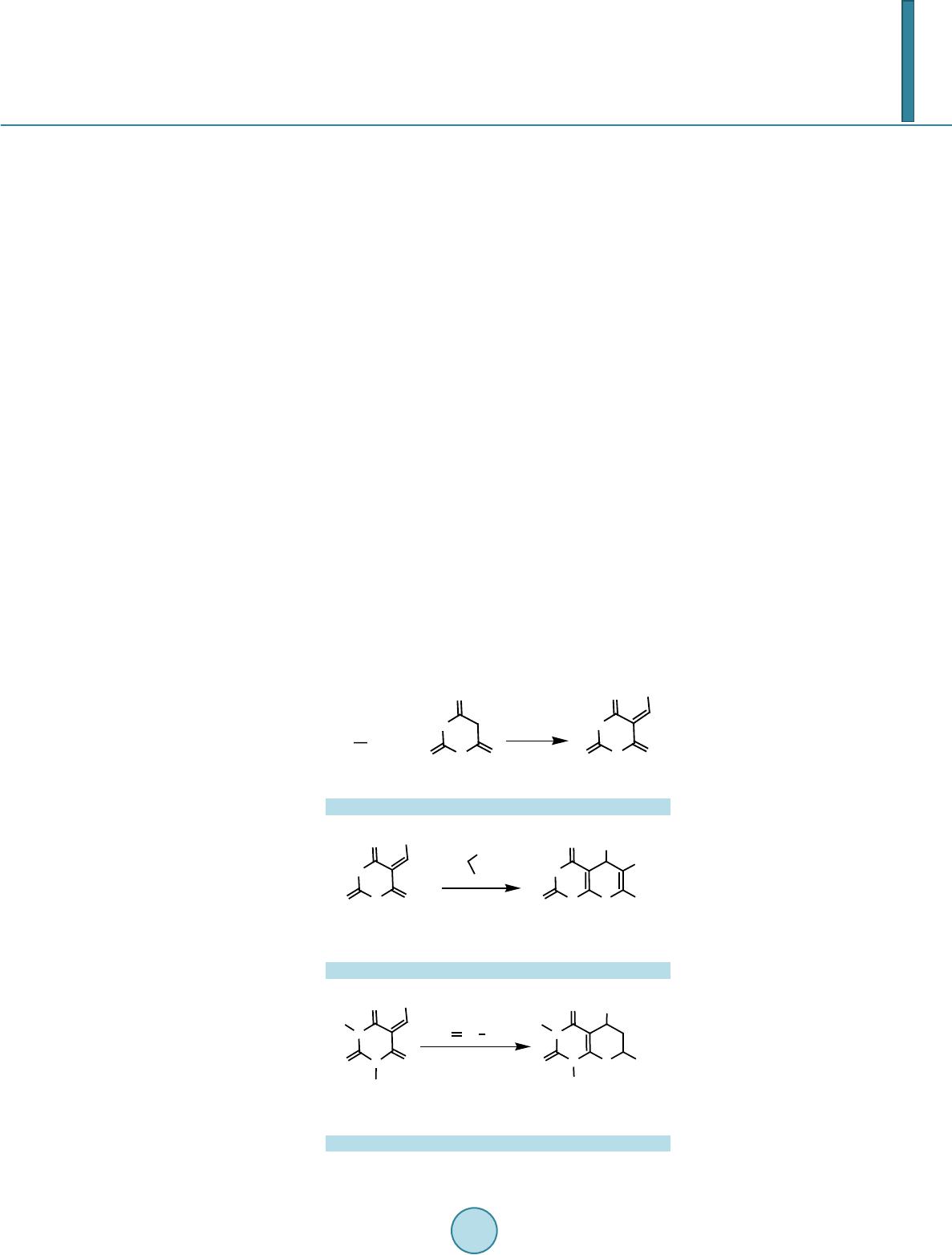 N. S. El-Gohary infrared irradiation in absence of solvent [361]. Also, it was carried out on basic alumina in a conventional mi- crowave oven in the absence of solvent [362]. In addition, the same reaction has been achieved by employing bismuth chloride under solvent-free conditions [363]. Reddy et al. [364] reported the same reaction under mi- crowave irradiation in absence of solvent and catalyst. In addition, Khan et al. [365] reported an improved, rapid and convenient met hod un de r e c o-benign conditions i.e. , using water as a solvent and bismuth chloride as a cata- lyst at room temperature. Recently, 5-arylidenebarbiturate/thiobarbiturate derivatives 158 were obtained in ex- cellent yields and high purity through condensation of barbituric or thiobarbituric acid with aromatic aldehydes in distilled water at room temperature and in the presence of a catalytic amount of ethanolamine [366] or L-ty- rosine [367]. Reactivity of Arylidenebarbiturates and Thiobarbiturates Reaction of 158 with malononitrile in ethanol and in the presence of a catalytic amount of piperidine afforded 7-amino-5-aryl-2-oxo(thioxo)-4-oxo-2,3,4,5-tetrahydro-1H-pyrano[2,3-d]pyrimidine-6-carbonitriles 159 [366] (Scheme 62). Cycloaddition reactions of 5-aryliden eba rbiturate derivatives 158 with a tenfold excess of ethyl vinyl ether in methylene chloride at room temperature afforded 2H-pyrano[2,3-d]pyrimidine-2,4-(3H)-diones 160 [368] (Scheme 63). 2.18. Synthesis of Arylidene Derivatives of Meldrum’s Acid 2,2-Dimethyl-1,3-dioxane-4,6-dione (Meldrum’s acid) undergoes standard Knoevenagel condensation with aromatic and heteroaromatic aldehydes furnishing the corresponding arylidene derivatives 161 (Scheme 64), which are versatile substrates for different kinds of reactions [369]. In addition , they are useful intermediates for cycloaddition reaction and for the synthesis of heterocyclic compounds with potential pharmacological activity [370]. The Knoevenagel condensation of aldehydes with Meldrum’s acid is generally catalyzed by bases, such as pyridine [371] or by piperidine/glacial acetic acid in benzene [372]. Uncatalyzed reaction was reported in li- terature us ing DMF or DMSO as solvent [373]. In addition, anhydrous zinc chloride was reported to promote the reaction in absence of any solvent [374]. The same reaction was also carried out in water [375]. In additio n, the Knoevenagel condensation of aromatic aldehydes with Meldrum’s acid proceeded efficiently in the recyclable Ar CHO + X = O; S158 N H HN O O X Ar N H HN O O X Scheme 61. Preparation of compounds 158. 158 N H HN O O X Ar HN N H O XO Ar CN NH 2 CN CN 159 X = O; S Scheme 62. Preparation of compounds 159. N N O OO Ar OC2H5 R R 158 N N O O O Ar R R 160 R = H; CH3; C2H5; i-Bu H2CCH OC2H5 CH2Cl2 / r.t. Scheme 63. Preparation of compounds 160. 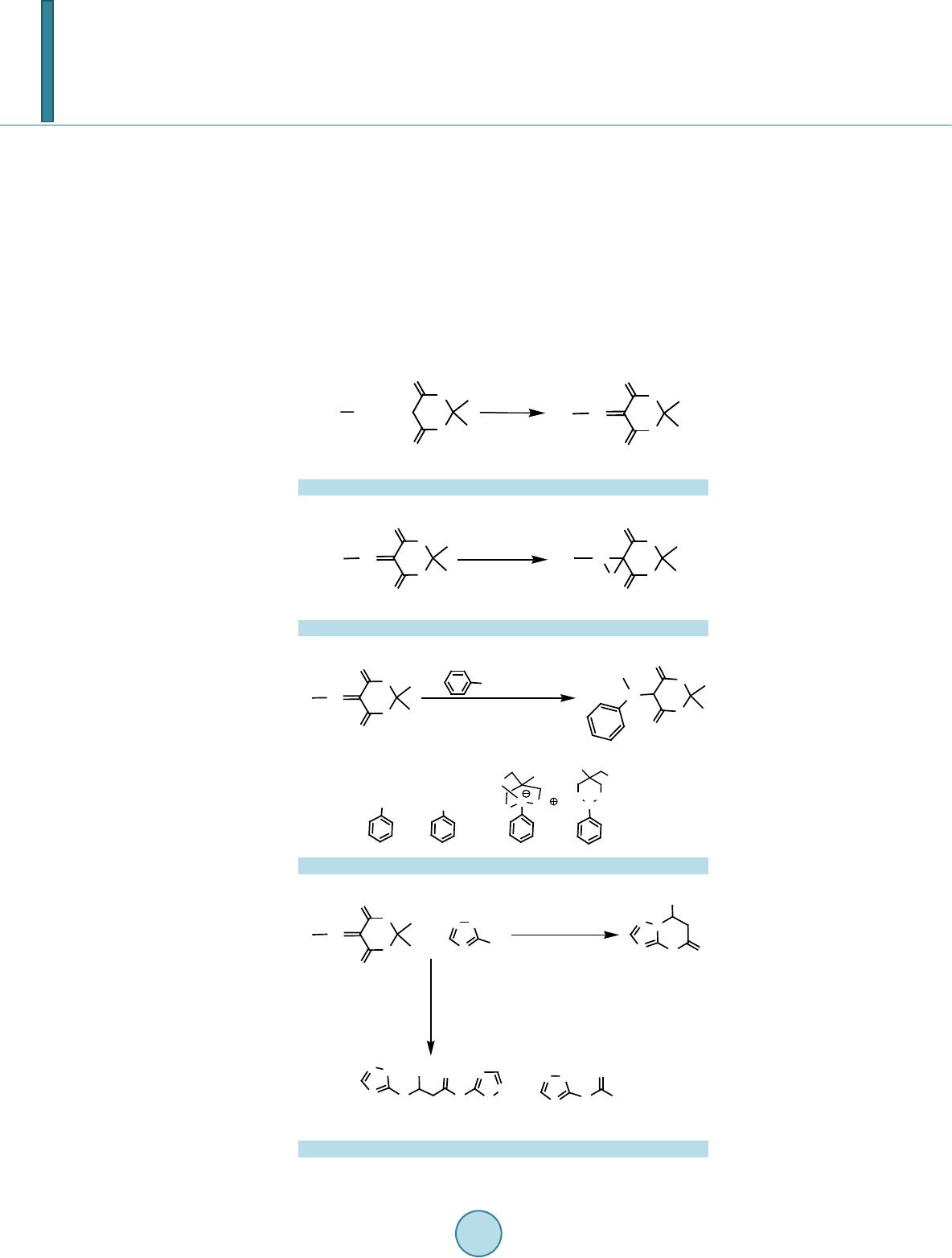 N. S. El-Gohary ionic liquid [bmim]BF4 at room temperature and in the presence of a catalytic amount of piperidine [376]. Also, the same condensation was carried out in methanol at room temperature [377]. Reactivity of Arylidene Derivatives of Meldrum’s Aci d The epoxide analogues of arylidene Meldrum’s acid 162 were prepared through reaction of 161 with hydrogen peroxide in acetonitrile at room temperatu re [378] [379] (Scheme 65). Rhodium-catalyzed additions of arylboron reagents to 161 in dioxane at room temperature gave compounds 163 [380] (Scheme 66). The condensation of 161 with 3-amin o-1,2,4-triazole in nitrobenzene afforded 4,5,6,7- tetrahydro-1,2,4-triazolo[1,5-a]pyrimidin-5-ones 164. In DMF, the reaction proceeds with the formation of arylsubstituted N-(2H-1,2,4-triazol-3-yl)-3-(2H-1,2,4-triazol-3-ylamino)propionamides 165, in addition, the amide 166 and the aldehydes were present in the reaction mixture [381] (Scheme 67). Scheme 64. Preparation of compounds 161. O O O O HC Ar H2O2/MeCNO O O O CH Ar O 161 162 Scheme 65. Preparation of compounds 162. O O O O HC Ar 161 Bxn [Rh(cod)Cl] 2 (1.5 mol %) KOH (1 equiv), dioxane, r.t. (2 equiv) O O O O CH Ar 163 Bxn = B(OH) 2 BB O O O K O O OSiMe 3 Scheme 66. Preparation of compounds 163. O O O O HC Ar 161 N N NH NH 2 N N N N HO Ar Ar-CHO N N H N N H O N H Ar NH N NN H O NH N NCH 3 + Nitrobenzene -Me 2 CO -CO 2 DMF -Me 2 CO -CO 2 ++ 164 165 166 Scheme 67. Preparation of compounds 164 and 165. 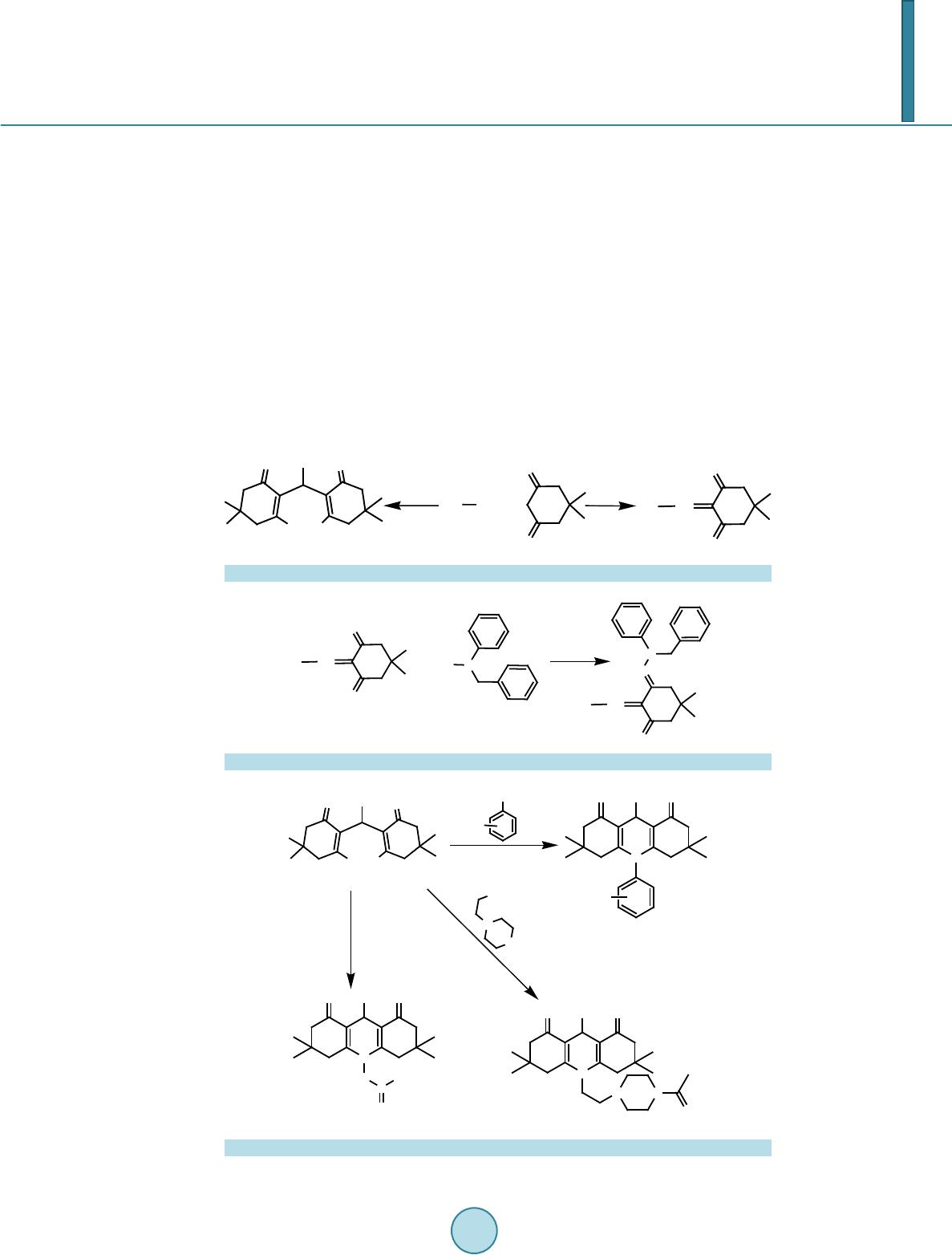 N. S. El-Gohary 2.19. Synthesis of 2-Arylidene Dimedone and Bisdimedone Derivatives 5,5-Dimethylcyclohexane-1,3-dione (dimedone) was condensed with aromatic aldehydes in equimolar ratio and in presence of bases such as potassium hydroxide [382] [383] or piperidine [383] to give 2-arylidene-5,5-di me- thylcyclohexane-1,3-dione derivatives 167 (Scheme 68). The same products were obtained through fusion of equimolar amounts of the aromatic aldehydes and dimedone in an oil bath at 150˚C [384]. On the other hand, reaction of dimedone with aromatic aldehydes in 2:1 molar ratio afforded the bisdimedone derivatives 168 (Scheme 68), several reaction conditions were reported for this reaction. The reaction was performed in reflux- ing aqueous ethanol and in the presence of a catalytic amount of piperidine [385], under solvent-free conditions [346], in aqueous ethanol at room temperature and in the presence of a catalytic amount of piperidine [386], in water at 100˚C and in the presence of a catalytic amount of iodine [387], HClO4-SiO2 or PPA -SiO2 [388], in re- fluxing aqueous methanol [389], in aqueous media at room temperature [390] or in refluxing acetonitrile and in the presence of of zinc oxide as a catalyst [391], also it was carried out in dry methylene chlorid e and in the pre - sence of silica chloride nano particle (nano SiO2-Cl) [392] to afford the corresponding 2,2'-(arylmethy- lene)bis(3-hydroxy-5,5-dimethyl-2-cyclohexen-1-one) (bisdimedone derivatives) 168. The same reaction was performed using ytterbium triflate [Yb(OTf) 3-SiO2] and amine as a catalytic system under solvent-free conditions Ar CHO + O O O O HC Ar 167 Ar OH HO OO 1:1 1:2 168 Scheme 68. Preparation of compounds 167 and 168. Scheme 69. Preparation of compounds 169. Ar OH HO OO N Ar O O R NH 2 R P 2 O 5 /EtOH NH 2 NHCSNH 2 AcOH N Ar O O HN CNH 2 S N Ar OO N N O N NH NH 2 AcOH 168 170 171 172 Scheme 70. Preparation of compounds 170-172.  N. S. El-Gohary [393]. This method is advantageous as being eco-friendly, non-corrosive, and allow s reutilization of the catalytic system. Recently, bisdimedone derivatives 168 were obtained through reaction of dimedone with aromatic al- dehydes in 2:1 molar ratio in ethylene glycol and in presence of nickel nanoparticles [394]. Reactivity of 2-Arylidene Dimedone and Bisdimedone Derivatives Reaction of arylidenedimedone derivatives 167 with N-benzyl-N-phenylhydrazine in 50% acetic acid produced compounds 169 [384] (Sch eme 69). When bisdimedone derivatives 168 were reacted with different amines in ethanol and in the presence of a ca- talytic amount of P2O5, 10-(substituted phenyl)-3,4,6,7,9,10-hexahydro-1,8(2H, 5H)-acridinedione derivatives 170 were obtained. The condensation of N-(2-aminoethyl)piperazine with bisdimedones 168 in acetic acid af- forded the acridinediones 171 in which the N-acetylation of the piperazine ring has also occurred. The reaction of bisdimedones 168 with thiosemicarbazide gave N-(3,3,6,6-tetramethyl-3,4,6,7,9,10-hexahydro-1,8-dioxo-(2H, 5H)-acrid in-10-yl)thiourea derivatives 172 [395] (Scheme 70). 3. Conclusion Literature data have been summarized to help chemists to find information appropriate for the high synthetic potential of different arylidene derivatives. Syntheses of many biologically active heterocyclic compounds be- longing to these compounds have also been reported. References [1] Choudary, B.M., Lakshmi Kantam, M., Kavita, B., Venkat Reddy, Ch. and Figueras, F. (2000) Catalytic C-C Bond Formation Promoted by Mg-Al-O-t-Bu Hydrolacite. Tetrahedron, 56, 9357-9364. http://dx.doi.org/10.1016/S0040-4020(00)00906-6 [2] Prajapati, D., Lekhok, K.C., Sandhu, J.S. and Ghosh, A.C. (1996) Magnesium Perchlorate as Efficient Lewis Acid for the Knoevenagel Condensation between β-Diketon e s a n d A l de hy de s . Journal of the Chemical Society, Perkin Transac- tions 1, 959-960. http://dx.doi.org/10.1039/p19960000959 [3] Khan, R.H., Mathur, R.K. and Ghosh, A.C. (1996) Tellurium (IV) Tetrachloride Catalyzed Facile Knoevenagel Reac- tion. Synthetic Communications, 26, 683-686. http://dx.doi.org/10.1080/00397919608086741 [4] Tanaka, K. (2003) Solvent-Free Organic Synthesis. Chapter 3.2, Wiley-VCH, Weinh eim, 93-136. http://dx.doi.org/10.1002/3527601821 [5] Tanaka, K. and Toda, F. (2000) Solvent-Free Organic Synthesis. Chemical Reviews, 100, 1025-1074. http://dx.doi.org/10.1021/cr940089p [6] Obrador, E., Castro, M., Tamariz, J., Zepeda, G., Miranda, R. and Delgado, F. (1998) Knoevenagel Condensation in Heterogeneous Phase Catalyzed by IR Radiation and Tonsil Actisil FF. Synthetic Communications, 28, 4649-4663. http://dx.doi.org/10.1080/00397919808004530 [7] Balalaie, S. and Nemati, N. (2001) One-Pot Preparation of Coumarins by Knoevenagel Condensation in Solvent-Free Condition under Microwave Irradiation. Heterocyclic Communications, 7, 67-72. http://dx.doi.org/10.1515/HC.2001.7.1.67 [8] Loupy, A., Song, S., Sohn, S., Lee, Y. and Known, T. (2001) Solvent-Free Bentonite-Catalyzed Condensation of Ma- lonic Acid and Aromatic Aldehydes under Microwave Irradiation. Journal of the Chemical Society, Perkin Transac- tions 1, 1220-1222. http://dx.doi.org/10.1039/b009803p [9] Maggi, R., Bigi, F., Carloni, S. and Mazzoc, A. (2001) Uncatalysed Reactions in Water: Part 2. Preparation of 3- Carboxycoumarins. Green Chemistry, 3, 173-174. http://dx.doi.org/10.1039/b101822c [10] Bigi, F., Conforti, M.L., Maggi, R., Piccinno, A. and Sartori, G. (2000) Clean Synthesis in Water: Uncatalysed Prepa- ration of Ylidenemalononitriles. Green Chemistry, 2, 101-103. http://dx.doi.org/10.1039/b001246g [11] Bigi, F., Carloni, S., Ferrari, L., Maggi, R., Mazzacani, A. and Sartori, G. (2001) Clean Synthesis in Water. Part 2: Uncatalysed Reactions of Meldrum’s Acid and Alde hydes . Tetrahedron Letters, 42, 5203-5205. http://dx.doi.org/10.1016/S0040-4039(01)00978-9 [12] Rupe, H. and Wasserzug, D.J. (1901) Chemis ch e Berichte, 34, 3527-3531. http://dx.doi.org/10.1002/cber.19010340342 [13] Hermes, S.A. (1969) Chemische B er i chte, 70, Article ID : 96422h. [14] Breslow, D.S. and Houser, C.R. (1940) Chemische Berichte, 62, 2385. [15] Kazauki, K., Hitayama, K., Yokomor, S. a nd Soki, T. (1976) Chemical Abstracts, 85, 591.  N. S. El-Gohary [16] Obara, H., Onodera, J. and Kurihara, Y. (1971) The Synthesis of 2’,3’,4,4’,6’-Pentahydroxychalcone. Bulletin of the Chemical Society of Japan, 44, 289. http://dx.doi.org/10.1246/bcsj.44.289 [17] Gaissman, T.A. and Clinton, R.O. (1946) Flavanones and Related Compounds. I. The Preparation of Polyhydroxychal- cones and Flavanones. Journal of the American Chemical Society, 68, 697-700. http://dx.doi.org/10.1021/ja01208a051 [18] Martin, G.J., Beler, J.M. and Avakian, S. (1956) Therapeutic Substituted Chalcones. US Patent No. 2769817. [19] El.Hashah, M.A., El-Kady, M., Saiyed, M.A. and El asw y, A.A. (1985) Egyptian Journal of C hemi st ry, 27, 715. [20] Crawley, L.S. and Fanshawe, W.J. (1977) Neighboring Group Participation in Cyclodehydration. A Regiospecific Iso- xazole Synthesis. Journal of Heterocyclic Chemistry, 14, 531-534. http://dx.doi.org/10.1002/jhet.5570140339 [21] Patil, C.B., Mahajan, S.K. and Katti, S.A. (2009) Chalcone: A Versatile Molecule. Journal of Pharmaceutical Sciences and Research, 1, 11-22. [22] Taylor, E.C. and Morrison, R.W. (1967) An Unusual Molecular Rearrangement of an N-Aminopyrimidine. The Jour- nal of Organic Chemistry, 32, 2379-2382. http://dx.doi.org/10.1021/jo01283a004 [23] Utale, P.S., Raghuvanshi, P.B. and Doshi, A.G. (1998) Synthesis of Some New 1-Carbamoyl-3-(substituted 2-hydr o xy - phenyl)-5-aryl -2-pyrazolines. Asian Journal of Chemistry, 10, 597-599. [24] Doan, T.N. and Tran, D.T. (2011) Synthesis, Antioxidant and Antimicrobial Activities of a Novel Series of Chalcones, Pyrazolic Chalcones, and Allylic Chalcones. Pharmacology & Pharmacy, 2, 282-288. http://dx.doi.org/10.4236/pp.2011.24036 [25] Jyo th, M.V., Prasad, Y.R., Venkatesh, P. and Sureshreddy, M. (2012) Synthesis and Antimicrobial Activity of Some Novel Chalcones of 3-Acetyl Pyridine and Their Pyrimidine Derivatives. Chemical Science Transactions, 1, 716-722. http://dx.doi.org/10.7598/cst2012.223 [26] Lyle, R.E. and Paradis, L.P. (1955) Acid-Catalyzed Condensations. II.1 The Condensation of Benzaldehyde with Su b - stituted Acetophenones. Journal of the American Chemical Society, 77, 6667-6668. http://dx.doi.org/10.1021/ja01629a094 [27] Marathey, M. G. (1952) J ournal of the University of Poona, 1. [28] Younis, F.M. (2011) Preparation of Number of Chalcone Compounds from 6-Formyl-5-met hoxy-1, 3 -benzoxathiol. College of Basic Education Researchers Journal, 11, 711-721. [29] Raval, A.A. and Shah, N.M. (1962) Journal of Scientific Research (India), 21, 234. [30] Szell and Sipos (1961) Neue Nitro-chalkone, V. Justus Liebigs Annalen der Chemie, 641, 113-115. [31] Reichel, L. (1944) Nalanxlissenchaften, 33, 215. [32] Jadhav, G.V. and Kulkami, V.G. (1951) Borax as a new Condensing Agent for the Synthesis of Chalcones. Current Science (India), 20, 42-43. [33] Vlasov, V.M. (1971) Izvestiya Sibirskogo Otdeleniya Akademii Nauk SSSR, Seriya Khimicheskikh Nauk, 2, 96. [34] Cheng, P.L., Fournari, P. and Triouflet, J. (1963) Reserches en série hétérocyclique. VII. Syntèse de chromannones et o-hydroxychalcones substituées sur le differents cycles. Bulletin de la Societe Chimique de France, 10, 2248-2251. [35] Breslow, D.S. and Hauser, C.R. (1940) Condensations. XI. Condensations of Certain Active Hydrogen Compounds Effected by Boron Trifluoride and Aluminum Chloride. Journal of the American Chemical Society, 62, 2385-2388. http://dx.doi.org/10.1021/ja01866a035 [36] Fujise, S. and Tatsuta, H. (1942) Journal of the Chemical Society of Japan, 63, 932. [37] Guthrit J.L. and Rabjohn, N. (1957) Some Reactions Effected by Means of Bromomagnesium t-Alkoxides. The Jour- nal of Organic Chemistry, 22, 176-179. http://dx.doi.org/10.1021/jo01353a022 [38] Jayapal, M.R., Sreenivasa Prasad, K. and Sreedhar, N.Y. (2010) Synthesis and Characterization of 2,4-Dihydroxy Sub- stituted Chalcones Using Aldol Condensation by SOCl2/EtOH. Journal of Chemical and Pharmaceutical Research, 2, 127-132. [39] Ameta, K.L., Rathore, N.S. and Kumar, B. (2011) Synthesis of Some Novel Chalcones and Their Facile One-Pot Con- version to 2-Aminobenzene-1,3-dicarbonitriles Using Malononitrile. Analele Universităţii din Bucuresti-Chimie (serie nouă), 20, 15-24. [40] Tiwari, V., Singh, J.P., Sharma, P., Dangi, L. and Dulawat, S.S. (2011) Microwave Assisted Improved Synthesis of Chalcones under Microwave Irradiation and Their Antibacterial Activity. Journal of Chemical, Biological and Physi- cal Sciences, 1, 22-27. [41] Funiss, B.S., Hannford, A.J., Smith, P.W.G. and Tatchell, A.R. (2004) Vogel’s Textbook of Practical Organic Che- mistry. 5th Edition, Longman, London, 1032-1035. [42] Mukherji, S.M., Singh, S.P. and Kapoor, R.P. (2003) Organic Chemistry. Vol II, International (P) Limited, 586-587.  N. S. El-Gohary [43] Toche, R.B., Kazi, M.A., Jachak, M.N. and Desai, A.E. (2009) Synthesis and Molluscicidal Activities of Quinolone Substituted Pyrazoline and Isoxazoline Derivatives. Journal of Applied Sciences Research, 6, 637-641. [44] Agarwal, P.K., Sharma, S.K., Sawant, D. and Kundu, B. (2009) Application of the Pictet-Spengler Reaction to Aryl Amine-Based Substrates Having Pyrimidine as a p-Nucleophile: Synthesis of Pyrimidoquinolines with Structural Analogy to Benzonaphthyridines Present in Alkaloids. Tetrahedron, 65, 1153-1161. http://dx.doi.org/10.1016/j.tet.2008.11.067 [45] Kalirajan, R., Sivakumar, S.U., Jubie, S., Gowramma, B. and Suresh, B. (2009) Synt hes is a nd Biological Evaluation of Some Heterocyclic De rivatives of Chalcones. International Journal of ChemTech Research, 1, 27-34. [46] Crawley, L.S. and Fanshawe, W.J. (1977) Neighboring Group Participation in Cyclodehydration. A Regiospecific Isoxazole Synthesis. Journal of Heterocyclic Chemistry, 14, 531-534. http://dx.doi.org/10.1002/jhet.5570140339 [47] Azarifar, D. and Shaebanzadeh, M. (2002) Synthesis and Characterization of New 3,5-Dinaphthyl Substituted 2-Pyra - zolines and Study of Their Antimicrobial Activity. Molecules, 7, 885-895. http://dx.doi.org/10.3390/71200885 [48] Samshuddin, S., Narayana, B., Sarojini, B.K., Khan, M.T.H., Yathirajan, H.S., Raj, C.G.D. and Raghavendra, R. (2012) Antimicrobial, Analgesic, DPPH Scavenging Activities and Molecular Docking Study of Some 1,3,5-Triary l - 2-pyrazolines. Medicinal Chemistry Research, 21, 2012-2022. http://dx.doi.org/10.1007/s00044-011-9735-9 [49] Samshuddina, S., Narayana, B., Sarojini, B.K., Yathirajan, H.S. and Raghavendra, R. (2012) Synthesis, Characteriza- tion and Biological Evaluation of Functionalized Derivatives of Versatile Synthon 4,4’-Difluoro Chalcone. Der Phar- ma Chemica, 4, 1445-1457. [50] Loh, W.-S., Quah, C.K., Chia, T.S., Fun, H.-K., Sapnakumari, M., Narayana, B. and Sarojini, B.K. (2013) Synthesis and Crystal Structures of N-Substituted Pyrazolines. Molecules, 18, 2386-2396. http://dx.doi.org/10.3390/molecules18022386 [51] Sammour, A., Akhnookh, Y. and Jahine, H. (1970) Studies on Chalcones. Condensation with Ethyl Cyanoacetate and Malononitrilie in Presence of Ammonium Acetate. United Arab Republic Journal of Chemistry, 13, 421-437. [52] Goda, F.E., Abdel-Aziz, A.A.-M. and Attef, O.A. (2004) Synthesis, Antimicrobial Activity and Conformational Analysis of Novel Substituted Pyridines: BF3-Promoted Reaction of Hydrazine with 2-Alkoxy Pyridines. B ioorganic & Medicinal Chemistry, 12, 1845-1852. http://dx.doi.org/10.1016/j.bmc.2004.01.040 [53] Ahmed, M.G., Ahmed, S.A., Roman, U.K.R., Touchy, A.S., Badal, M.R., Hossain, M.A. and Uddin, M.K. (2005) Syn - thesis of Substituted and Unsubstituted 2, 4 -D ia ry l -5-oxo-5,6,7,8-tetrahydro-2-chromens. Indian Journal of Chemistry, 44B, 622-624. [54] Jin, H., Zhao, H., Zhao, F., Li, Sh., Liu, W., Zhou, G., Tao, K. and Hou, T. (2009) Efficient Epoxidation of Chalcones with Urea-Hydrogen Peroxide under Ultrasound Irradiation. Ultrasonics Sonochemistry, 16, 304-307. http://dx.doi.org/10.1016/j.ultsonch.2008.10.013 [55] Sharshira, E.M. and Hamada, N.M. M. (2011) Synthesis and in Vitro Antimicrobial Activity of Some Pyrazolyl-1-Car- boxamide Derivatives. Molecules , 16, 7736-7745. http://dx.doi.org/10.3390/molecules16097736 [56] Chandrashekhar, C.H., Latha, K.P., Vagdevi, H.M. and Vaidya, V.P. (2011) Synthesis and Antimicrobial Activity of Chalcones of Naphtho[2,1-b]furan Condensed with Barbituric Acid. Der Pharma Chemica, 3, 329-333. [57] Sangani, H.G., Bhimani, K.B., Khunt, R.C. and Parikh, A.R. (2006) Synthesis and Characterization of Barbitones as Antimicrobial Agents. Journal of the Serbian Chemical Society, 71, 587-591. http://dx.doi.org/10.2298/JSC0606587S [58] Al-Issa, S.A. (2007) Synthesis of 3,5-Diaryl Azoline and [1,4]Diazepine Derivatives via Microwave Irradiation. Jour- nal of King Saud University-Science, 19, 6 7 -77. http://dx.doi.org/10.4197/Sci.19-1.6 [59] Ameta, K.L., Rathore, N.S. and Kumar, B. (2012) Synthesis and in Vitro Anti-Breast Cancer Activity of Some Novel 1,5-Benzothiazepine Derivatives. Journal of the Serbian Chemical Society, 77, 725-731. http://dx.doi.org/10.2298/JSC110715219A [60] Yadav, J.S. and Srivastava, Y.K. (2010) An Efficient Microwave Assisted Synthesis of Some Novel 1,4-Dizepine Deri- vatives as Possible Antimicrobial Agents. Rasayan Journal of Chemistry, 3, 726-730. [61] Joung, M.E. (1976) A Review of Annulation. Tetrahedron, 32, 3-31. http://dx.doi.org/10.1016/0040-4020(76)80016-6 [62] Hathaway, B.A. (1987) An Aldol Condensation Experiment Using a Number of Aldehydes and Ketones. Journal of Chemical Education, 64, 367-368. http://dx.doi.org/10.1021/ed064p367 [63] Rajanarendar, E., Kalyan Rao, E. and Raju, S. (2009) Microwave Assisted Rapid and Efficient Synthesis of New 3- Ethoxy-4,6-diaryl-4, 5 -dihydro-2, 1 -benzisoxazoles. Indian Journal of Chemistry, 48B, 749-753. [64] Nakano, T., Irifune, S., Umano, S., Inada, A., Ishii, Y. and Ogawa, M. (1987) Cross-Condensation Reactions of Cy- cloalkanones with Aldehydes and Primary Alcohols under the Influence of Zirconocene Complexes. The Journal of Organic Chemistry, 52, 2239-2244. http://dx.doi.org/10.1021/jo00387a025 [65] Li, J.T., Yang, W.Z., Chen, G.F. and Li, T.S. (2003) A Facile Synthesis of α,α'-Bis(substituted benzylidene)cycloalka-  N. S. El-Gohary nones Catalyzed by KF/Al2O3 under ultrasound Irradiation. Synthetic Communications, 33, 2619-2625. http://dx.doi.org/10.1081/SCC-120021982 [66] Yadav, J.S., Reddy, B.V.S., Nagaraju, A. and Sarma, J.A.R.P. (2002) Microwave Assisted Synthesis of α,α'-Bis(be n- zylidene)ketones in Dry Media. Synthetic Communications, 32, 893-896. http://dx.doi.org/10.1081/SCC-120002700 [67] Zhang, X.Y., Fan, X.S., Niu, H.Y. and Wang, J.J. (2003) An Ionic Liquid as a Recyclable Medium for the Green Prep- aration of α,α'-Bis (substituted benzylidene)cycloalkanones Catalyzed by FeCl 3· 6H 2O. Green Chemistry, 5, 267-269. http://dx.doi.org/10.1039/b212155g [68] Wang, L., Sheng, J. , Tia n, H., Han, J., Fa n, Z. and Qi an, C. (2 004) A Convenient Synthesis of α,α’-Bis(substituted ben- zylidene)cycloalkanones Catalyzed by Yb(OTf)3 under Solvent-Free Conditions. Synthesis, 2004, 3060-3064. http://dx.doi.org/10.1055/s-2004-834900 [69] Bigdeli, M.A., Mahdavinia, G.H., Jafari, S. and Hazarkhani, H. (2007) Wet 2,4,6-Trichloro[1,3,5]triazine (TCT) an Efficient Catalyst for Synthesis of α,α'-Bis(substituted-benzylidene)cycloalkanones under Solvent-Free Conditions. Catalysis Communications, 8, 2229-2231. http://dx.doi.org/10.1016/j.catcom.2007.05.010 [70] Singh, N., Pandey, J., Yadav, A., Chaturvedi, V., Bhatnagar, Sh., Gaikwad, A.N., Sinha, S.K., Kumar, A., Sh ukl a, P.K. and Tripathi, R.P. (2009) A Facile Synthesis of α,α'-(EE)-bis(benzylidene)-cycloalkanones and Their Antitubercular Evaluations. European Journal of Medicinal Chemistry, 44, 1705-1709. http://dx.doi.org/10.1016/j.ejmech.2008.09.026 [71] Mahdavinia, G.H. and Mirzazadeh, M. (2012) Facile and Convenient Synthesis of α,α'-Bis(substituted-arylidene)cy- cloalkanones: An Improved Protocol. E-Journal of Chemistry, 9, 49-54. http://dx.doi.org/10.1155/2012/390528 [72] Rahman, A.F.M.M., Ali, R., Jahng, Y. and Kadi, A.A. (2012) A Facile Solvent Free Claisen-Schm i d t Reaction: Sy n- thesis of α,α'-Bis-(substituted-benzylidene)cycloalkanones and α,α'-Bis-(substituted-alkylidene)cycloalkanones. Mole- cules, 17, 571-583. [73] Teimouri, F., Hadi Khezri, S., Miri, Z., Eftekhari-Sis, B. and Azizian, J. (2009) Ammonium Chloride Catalyzed Aldol Condensation: A Facile Synthesis of α,α'-Bi s (substituted benzylidene) Cycloalkanones. Journal of Sciences (Islamic Azad University ) (JSIAU), 19, 103-108. [74] Mahdavinia, Gh.H. and Peikarporsan, S. (2011) Crossed Aldol Condensation Reaction Catalyzed by NBS as an Effi- cient and Almost Neutral Catalyst: Preparation of α,ά-Bis(substituted-benzylidene)cycloalkanones. Trends in Modern Chemistry TMC, 1, 5 -10. [75] Kumar, S., Kumar, P. and Makrandi, J.K. (2012) A Simple, Improved and Solvent Free Synthesis of α,α'-Bis(aryli- dene)cycloalkanones. Der Chemica Sinica, 3, 269-273. [76] Singh, N., Pandey, J., Yadav, A., Chaturvedi, V., Bhatnagar, Sh., Gaikwad, A.N., Sinha, S.K., Kumar, A., Shukla, P.K. and Tripathi1, R.P. (2009) A Facile Synthesis of α,α'-(EE)-bis(benzylidene)-cycloalkanones and Their Antitubercular Evaluations. European Journal of Medicinal Chemistry, 44, 1705-1709. http://dx.doi.org/10.1016/j.ejmech.2008.09.026 [77] Zou, Q., Zhao, Y., Makarov, N.S., Campo, J., Yuan, H., Fang, D.-C., Perry, J.W. and Wu, F. (2012) Effect of Alicyclic Ring Size on the Photophysical and Photochemical Properties of Bis(arylidene)cycloalkanone Compounds. Physical Chemistry Chemical Physics, 14, 11743-11752. http://dx.doi.org/10.1039/c2cp41952a [78] Colonge, J. and Sibeud, J. (1952) Bulletin de la Societe Chimique de France, 786-789. [79] Emerson, W.S., Birum, G.H. and Longley Jr., R.I. (1953) Bicyclic Dihydropyrans by the Diels-Alder Reaction. J ou r - nal of the American Chemical Society, 75, 1312-1313. http://dx.doi.org/10.1021/ja01102a013 [80] Jaitak, V., Kaul, V.K. and Das, P. (2013) Environmentally Benign Michael and Claisen Schmidt Reaction of Aromatic Carbonyl Compounds by Alkaline Polyionic Resin. Indian Journal of Chemistry, 52B, 1137-1145. [81] Huitric, A.C. and Kumler, W.D. (1956) The Dipole Moments, Spectra and Structure of Some New 2-Pheny l-, 2-Ben- zyl-, 2-(p-Halobenzylidene)- and 2,6 -Bis-(p-halobenzylidene)-cyclohexanones. Journal of the American Chemical So- ciety, 78, 614-622. http://dx.doi.org/10.1021/ja01584a026 [82] Fringuelli, F., Pani, G., Piermatti, O. and Pizzo, F. (1994) Condensation Reactions in Water of Active Methylene Compounds with Arylaldehydes. One-Pot Synthesis of Flavonols. Tetrahedron, 50, 11499-11508. http://dx.doi.org/10.1016/S0040-4020(01)89287-5 [83] Kang, L.-Q., Song, G.-H., Wang, J.-Y. and Wei, B.-G. (2008) Synthesis of α,α'-Bis(substituted benzylidene)cycloalka- nones catalyzed by Amino-Functionalized Ionic Liquid. Journal of the Chinese Chemical Society, 55, 1125-1128. [84] Sheikhhosseini, E., Ahmadi, S.A. and Sadeghi, S. (2014) P-Dodecylbenzenesulfonic Acid (DBSA), a Brønsted Acid- Surfactant Catalyst for Synthesis of α,ά-Bis(substituted benzylidene)cycloalkanones with Electron-Withdrawing Subs- tituent in Aqueous Media. Journal of Applied Chemical Research, 8, 25-30. [85] Wang, X.X. and Zhang, Y.M. (2004) Formation of α,α'-Bis(substituted benzylidene)cycloalkanones from Masked Al- dehydes Promoted by Samarium (III) Triiodide. Chinese Chemical Letters, 15, 511-514.  N. S. El-Gohary [86] Singh, N., Pandey, J. and Tripathi, R.P. (2008) d-Glucosamine, a Natural Aminosugar as Organocatalyst for an Eco- friendly Direct Aldol Reaction of Ketones with Aromatic Aldehydes in Water. Catalysis Communications, 9, 743-746. http://dx.doi.org/10.1016/j.catcom.2007.08.014 [87] Fehnel, E.A. and Carmack, M. (1948) Studies in the Thiapyran Series. The Preparation, Properties and Reactions of 1,4-Thiapyrone-1-Dioxide. Journal of the American Chemical Society, 70, 1813-1817. http://dx.doi.org/10.1021/ja01185a048 [88] Chardwell, H.M.E. (1949) Experiments on the synthesis of Substances Related to Sterols. Part XLVII. The Synthetic Use of thia Cyclohexan-4-One Methiodide. Journal of the Chemical Society, 715-719. http://dx.doi.org/10.1039/jr9490000715 [89] Cornubert, R., Delmas, R., Monteil, S. and Viriot, J. (1950) Bulletin de la Societe Chimique de France, 36. [90] Leonard, N.J. and Choudhury, D. (1957) γ-Pyro nes by Isomerization. Substituted 3,5-Dibenzyl-4H-py r a n-4-ones. Jour- nal of the American Chemical Society, 79, 156-160. http://dx.doi.org/10.1021/ja01558a042 [91] Puar, M.S., Rovnyak, G.C., Cohen, A.I., Toeplitz, B. and Gougoutas, J.Z. (1979) Orientation of the Sulfoxide Bond as a Stereochemical Probe. Synthesis and Proton and Carbon-13 NMR of Substituted Thiopyrano[4, 3 -c]pyrazoles. The Journal of Organic Chemistry, 44, 2513-2518. http://dx.doi.org/10.1021/jo01328a040 [92] Rovnyak, G.C. and Shu, V. (1979) Preparation of Thiopyrano- and Pyrano[4,3-c]pyrazoles. Structure Elucidation of Dehydro Coproducts. The Journal of Organic Chemistry, 44, 2518-2522. http://dx.doi.org/10.1021/jo01328a041 [93] Turk, C.F. (1975) Pyrazoline Derivatives, Their N-Oxides, and Salts. Ger Offen Patent No. 2520171. [94] Krapcho, J. and Schawartz, J. (1976) CNS Active Compounds. US Patent No. 3969527. [95] Krapcho, J., and Turk, F. (1975) 2-Amino-4,5-Dihydro-4-Arylidenopyrimidines. US Patent No. 3925384. [96] Sohár, P., Perjési, P. , Törnroos, K.W., Husebye, S., Vértes, A., Vankó, G. and Bozak, R. (2000) Study on Ferrocenes, Part 7. E-2-Ferrocenemethylene-1-benzocyclanones. Synthesis, Stereostructure, NMR, IR, X-Ray, and Mössbauer Spec - troscopic Investigation. Journal of Molecular Structure, 524, 297-304. http://dx.doi.org/10.1016/S0022-2860(00)00380-X [97] Gupta, R., Gupta, A.K., Paul, S. and Kachroo, P.L. (1995) Improved Microwave-Induced Synthesis of Chalcones and Related Enones. Indian Journal of Chemistry, 34B, 61-62. [98] Mandal, S.K. and Sarkar, A. (2002) endo-Selective Allylation at the Benzylic Centre of a Cr(CO)3 Complexed Aro- matic Ring. Journal of the Chemical Society, Perkin Transactions 1, 669-674. http://dx.doi.org/10.1039/b109291j [99] Asiri, A.M. and Rasul, M.G. (2009) Synthesis of (2E)-2-(2,4,6-trimethoxybenzylidene)indan-1-one. Molbank, 2009, M588. [100] Witschard, G. and Griffin, C.E. (1964) The Wittig Reaction with Five- and Six-Membered Cyclic Ketones and Their Benzylidene Derivatives. The Journal of Organic Chemistry, 29, 2335-2340. http://dx.doi.org/10.1021/jo01031a057 [101] Lankin, D.C. and Zimmer, H. (1973) Synthesis of Condensed Heterocyclic Systems V: 1H-indeno[1,2-b]quinolines from Photochemical and Acid-Calalyzed Rearrangements of Trans-2-(2-aminobenzylidene)-indanones. Journal of He- terocyclic Chemistry, 10, 1035-1038. http://dx.doi.org/10.1002/jhet.5570100630 [102] Kumbharek, R. and Sridhar, M. (2012) Trifluoromethanesulfonic Acid Promoted Dakin-West Reaction: An Efficient and Convenient Synthesis of β-Acetamido Ketones. Journal of Chemical Sciences, 124, 495. http://dx.doi.org/10.1007/s12039-011-0183-3 [103] Murray, R.J. and Cromwell, N.H. (1976) Mobile Keto Allyl Systems. 18. Synthesis and Charge-Transfer Interactions of 2-(Alpha-aminobenzyl)-1-Indenones. The Journal of Organic Chemistry, 41, 3540-3545. http://dx.doi.org/10.1021/jo00884a011 [104] Wagner, H., Horn, B., Eppner, H. and Kühmstedt, H. (1979) Pharmazie, 34, 56. [105] Berthelote, C., McCooye, C., Leblanc, Y. and Trimble, L.A. (1997) Studies on the Dimerization of 2-Benzy l i de n e -1- Indanone. The Journal of Organic Chemistry, 62, 4339-4342. http://dx.doi.org/10.1021/jo970402y [106] Singh, G. and Ray, J.N. (1930) Journal of the Indian Chemical Society, 7, 637. [107] Basavaiah, D. and Reddy, R.M. (2001) One-Pot Inter- and Intramolecular Friedel-Crafts Reactions in Baylis-Hillman Chemistry: A Novel Facile Synthesis of (E)-2-arylideneindan-1-ones. Tetrahedron Letters, 42, 3025-3027. http://dx.doi.org/10.1016/S0040-4039(01)00354-9 [108] Coombs, R.W. and Houlihan, W.J. (1974) Process for Preparing Substituted Indeno, Naphtho and Cycloheptapyra- zoles. US Patent No. 3843665. [109] Boudriga, S., Wannassi, N., Askri, M., El Baker Rammah, M. and Strohman, C.J. (2009) Journal de la Société Chimi- que de Tunisie, 11, 29-36. [110] Thadhaney, B., Sain, D. and Joshi, A. and Talesara, G.L. (2009) Synthesis and Biological Evaluation of Some Ethox-  N. S. El-Gohary yphthalimide Derivatives of Benzo (g) Indazoles. International Journal of Chemical Sciences, 7, 1185-1194. [111] Sohár, P., Perjési, P., Tö rnroos, K.W., Husebye, S., Vértes, A., Vankó, G. and Bozak, R. (2000) Study on Ferrocenes, Part 7. E-2-Ferrocenemethylene-1-benzocyclanones. Synthesis, Stereostructure, NMR, IR X-Ray, and Mossbauer Spec- troscopic Investigation. Journal of Molecular Structure, 524, 297-304. http://dx.doi.org/10.1016/S0022-2860(00)00380-X [112] Gupta, R., Gupta, A.K., Paul, S. and Kachroo, P.L. (1995) Indian Journal of Chemistry, 34B, 61-62. [113] Orlov, V.D., Borovoi, I.A. and Lavrushin, V.F. (1976) Zhurnal Strukturnoi Khimii, 17, 691. [114] Schwender, C.F. and Shavel Jr., J. (1974) 1-Oxo-Substituted-Tetrahydronaphthalenes (Substituted-Tetralones). US Pa - tent No. 3833726. [115] Ansell, L.L., Webb, T.E., Burnham, J.W., Eisenbraun, E.J., Hamming, M.C. and Keen, G.W. (1976) Synthesis of 2-(1-Naphthylmethyl)-3,4-dihydronaphthalene, 2-(1-Naphthy l m e thyl)-1, 2 ,3,4-tetrahydronaphthalene, 7a,8,9,13b-Tetra- hydro-7H-dibe nz [ a, k L]Anthracene, and 5,6-Dihydro-4H-dib e nz [ a, k L]anthracene. Organic Preparations and Pro- cedures International, 8, 125-132. http://dx.doi.org/10.1080/00304947609355605 [116] Aizenshtat, Z., Hausmann, M., Pickholtz, Y., Tal, D. and Blum, J. (1977) Chlorocarbonylbis(triphenylphosphine)iri- dium-Catalyzed Isomerization, Isoaromatization, and Disproportionation of Some Cycloalkanones Having Exocyclic Double Bonds. The Journal of Organic Chemistry, 42, 2386-2394. http://dx.doi.org/10.1021/jo00434a010 [117] Kerbal, A., Tshiamala, K., Cerutti, E., Laude, B. and Vebrel, J. (1990) Bulletin de la Societe Chimique de France, 127, 252. [118] D’Auria, M., D’Onofrio, F. and Vantaggi, A. (1990) Benzophenone Sensitized Rearrangement of Furylidenetetralones. Tetrahedron, 46, 7831-7840. http://dx.doi.org/10.1016/S0040-4020(01)90080-8 [119] D’Auria, M., D’Annibale, A. and Ferri, T. (1992) Photochemical Behaviour of Furylidene Carbonyl Compounds. Te- trahedron, 48, 9323-9336. [120] Sur, S., Ganesh, S., Puranik, V.G. and Sarkar, A. (1998) Remote Stereocontrol as a Synthetic Strategy: Diastereoselec- tive Annulations on an Arene Tricarbonylchromium Template. Journal of the Chemical Society, Perkin Transactions 1, 977-982. http://dx.doi.org/10.1039/a705285e [121] Arora, S., Yadav, S., Agrawal, N. and Nagori, Dr., B.P. (2013) International Journal of Pharmaceutics, 1, 456. [122] Kamakshi, R., Swarna Latha, S. and Reddy, B.S.R. (2010) An Efficient Synthesis of Bio-Active Fluorescent Benzylidine Tetralones. Indian Journal of Chemistry, 49B, 944-947. [123] Bayer, H. and Hartmann, R.W. (1991) Pyridyl-Substituted Tetralone Derivatives: A New Class of Nonsteroidal Aro- matase Inhibitors. Archiv der Pharmazie (Weinheim), 324, 815-820. http://dx.doi.org/10.1002/ardp.2503241008 [124] Bayer, H. and Hartmann, R.W. (1991) New Inhibitors of Aromatase: Synthesis and Biological Activity of Pyridyl- Substituted Phenanthrenone Derivatives. Archiv der Pharmazie (Weinheim), 324, 833-836. http://dx.doi.org/10.1002/ardp.2503241102 [125] Bayer, H., Baltz, C., Hartmann, R.W. and Mannschreck, A. (1991) New Aromatase Inhibito rs. Synt hesis and Biol ogic al Activity of Pyridyl-Substituted Tetralone Derivatives. Journal of Medicinal Chemistry, 34, 2685-2691. http://dx.doi.org/10.1021/jm00113a004 [126] Wächter, G.A., Harmtmann, R.W., Sergejew, T., Grün, G.L. and Ledergerber, D. (1996) Tetrahydronaphthalenes: In- fluence of Heterocyclic Substituents on Inhibition of Steroidogenic Enzymes P450 Arom and P450 17. Journal of Medicinal Chemistry, 39, 834-841. http://dx.doi.org/10.1021/jm950377t [127] Azzolina, O., Desimoni, G., Di Toro, V., Ghislandi, V. and Tacconi, G. (1975) Gazzetta Chimica Italiana, 105, 971. [128] Wagner, H., Horn, B., Eppner, H. and Kühmstedt, H. (1979) Pharmazie, 34, 56. [129] Kaur, R., Bansal, M. and Kaur, B. (2011) Synt hesis of Some New Quinazoline Derivatives and Theoretical Studies of Their Geometries. Chemical Sciences Journal, 2011, 1-9. [130] Muthusamy, S., Babu, S.A. and Gunanathan, C. (2000) Novel chemoselective 1, 3 -dipolar cycloaddition of rhodium generated carbonyl ylides with arylidenetetralones. Tetrahedron Letters, 41, 8839-8842. http://dx.doi.org/10.1016/S0040-4039(00)01560-4 [131] Quiroga, J., Portilla, J., Serrano, H., Abonia, R., Insuasty, B., Nogueras, M. and Cobo, J. (2007) Regioselective Syn- thesis of Fused Benzopyrazolo[3,4-b]quinolines under Sol vent-Free Conditions. Tetrahedron Letters, 48, 1987-1990. [132] Jayashankaran, J., Manian, R.D.R.S. and Raghunathan, R. (2005) ARKIVOC, xi, 32. [133] Xu, W. -Z., Huang, Z.-T. and Zheng, Q.-Y. (2008) Synthesis of Benzo[c]xanthones from 2-Benzylidene-1-tetralon es by the Ultraviolet Radiation-Mediated Tandem React i on. The Journal of Organic Chemistry, 73, 5606-5608. http://dx.doi.org/10.1021/jo8008929 [134] El-Rayyes, N.R. and Bahtiti, N.H. (1989) Synthesis of New Substituted 2,3,3a,4,5,6-Hexahydrobenzo[6,7]cyclohep-  N. S. El-Gohary ta[1,2-c]pyrazoles and related compounds. Journal of Heterocyclic Chemistry, 26, 209-214. http://dx.doi.org/10.1002/jhet.5570260137 [135] El-Rayyes, N.R. and Ramadan, H.M. (1987) Heterocycles. PartX. Synthesis of New Pyrimidine Systems. Journal of Heterocyclic Chemistry, 24, 589-596. http://dx.doi.org/10.1002/jhet.5570240310 [136] Wagner, G., Garbe, C., Vieweg, H., Brunn, M. and Dittrich, A. (1979) Pharmazie, 34, 55. [137] Cummins, B., Donnelly, D.M.X., Eades, J.F., Fletcher, H., O’Cinneide, F., Philbin, E.M., Swirski, J., Wheeler, T.S. and Wilson, R.K. (1963) Oxidation of Chalcones (AFO reaction). Tetrahedron, 19, 499-512. http://dx.doi.org/10.1016/S0040-4020(01)98539-4 [138] Dean, F.M. and Podimuang, V. (1965) The Course of the Algar-Flynn Oyamada (A.F.O.). Journal of the Chemical So- ciety, 3978-3987. http://dx.doi.org/10.1039/jr9650003978 [139] Fougerousse, A., Gonzalez, E. and Brouillard, R. (2000) A Convenient Method for Synthesizing 2-Aryl-3-hydroxy-4- oxo-4H-1-benzopyrans or flavonols. The Journal of Organic Chemistry, 65, 583-586. http://dx.doi.org/10.1021/jo990735q [140] Donnelly, J.A. and Higginbotham, C.L. (1990) Flavone Formation in the Wheelerb Aurone Synthesis. Tetrahedron, 46, 7219-7226. http://dx.doi.org/10.1016/S0040-4020(01)87902-3 [141] Donnelly, J.A., Emerson, G.M. (1990) Amine-Effected Cyclization of Chalcone Dihalides to Aurones. Tetrahedron, 46, 7227-7236. http://dx.doi.org/10.1016/S0040-4020(01)87903-5 [142] von Auwerws, K. and Müller, K. (1908) Umwandlung von Benzal-cumaranonen in Flavonole. Berichte der deutschen chemischen Gesellschaft, 41, 4233-4241. http://dx.doi.org/10.1002/cber.190804103137 [143] Brady, B.A., Geoghegan, M. and O’Sullivan, W.I. (1981) Flavonoid Epoxides. Part 16. Synthesis and Base-Catalysed Rearrangement of Aurone Epoxides. Journal of the Chemical Society, Perkin Transactions 1, 119-123. http://dx.doi.org/10.1039/p19810000119 [144] Haudecoeur, R., Belkacem, A.A., Yi, W., Fortuné, A., Brillet, R., Belle, C., Nicolle, E., Pallier, C., Pawlotsky, J.-M. and Boumendjel, A. (2011) Discovery of Naturally Occurring Aurones That Are Potent Allosteric Inhibitors of Hepa- titis C Virus RNA -Dependent RNA Polymerase. Journal of Medicinal Chemistry, 54, 5395-5402. http://dx.doi.org/10.1021/jm200242p [145] Hadj-Esfandiari, N., Navidpour, L., Shadnia, H., Amini, M., Samadi, N., Faramarzi, M.A. and Shafiee, A. (2007) Syn- thesis, Antibacterial Activity, and Quantitative Structure-Activity Relationships of New (Z)-2-(nitroimidazolylmethy- lene)-3(2H2H)-benzofuranone Derivatives. Bioorganic & Medicinal Chemistry Letters, 17, 6354-6363. [146] von Auwers, K. and Poh, P. (1914) Ann., 405, 243. [147] Wagner, G. and Eppner, B. (1979) Pharmazie, 34, 527. [148] Farkas, L., Nógrádi, M. and Pallos, L. (1963) The Correct Structure and Synthesis of Rengasine. Tetrahedron Lette rs, 4, 1999-2000. http://dx.doi.org/10.1016/S0040-4039(01)90957-8 [149] Farkas, L., Nógrádi, M. and Pallos, L. (1964) Aurone und Auronglucoside, VI. Die endgültige Konstitutionsaufklärung und die Synthese des Rengasins. Chemische Berichte, 97, 1044-1046. http://dx.doi.org/10.1002/cber.19640970415 [150] Farkas, L., Pallos, L. and Nógrádi, M. (1965) Magyar Kémiai Folyóirat, 71, 270. [151] Jong, T.T. and Leu, S.J. (1990) Intramolecular Cyclisation Catalysed by Silver(I) Ion; a Convenient Synthesis of Au- rones. Journal of the Chemical Society, Perkin Transactions 1, 423-424. http://dx.doi.org/10.1039/p19900000423 [152] Agrawal, N.N. and Soni, P.A. (2006) A New Process for the Synthesis of Aurones by Using Mercury (II) Acetate in Pyridine and Cupric Bromide in Dimethyl Sulfoxide. Indian Journal of Chemistry, 45B, 1301-1303. [153] Detsi, A., Majdalani, M., Christos, A., Dimitra, K., Hadjipavlou-Litina, D. and Kefalas, P. (2009) Natural and Synthe- tic 2’-Hydroxy-Chalcones and Aurones: Synthesis, Characterization and Evaluation of the Antioxidant and Soybean Lipoxygenase Inhibitory Activity. Bioorganic & Medicinal Chemistry, 17, 8073-8085. http://dx.doi.org/10.1016/j.bmc.2009.10.002 [154] Dawane, B.S., Konda, S.G., Khandare, N.T., Chobe, S.S., Shaikh, B.M., Bodade, R.G. and Joshi, V.D. (2010) Synthe - sis and Antimicrobial Evaluation of 2-(2-Butyl-4-chloro-1H-imidazol-5-yl-methylene)-substituted-benzofuran-3-ones. Chemical Communications, 3, 22-29. [155] Bhasker, N. and Reddy, M.K. (2011) Syn thesis and Characterization of New Series of Prenyloxy Chalcones, Prenyloxy Aurones and Screening for Anti-Bacterial Activity. International Journal of Research in Pharmaceutical and Bio- medica l S ciences, 2, 1266-1272. [156] Harkat, H., Blanc, A., Weibel, J.-M. and Pale, P. (2008) Versatile and Expeditious Synthesis of Aurones via Au-Cata- lyzed Cyclization. The Journal of Organic Chemistry, 73, 1620-1623. http://dx.doi.org/10.1021/jo702197b [157] Alcaide, B., Almendros, P. and Alonso, J.M. (2011) Gold-Catalyzed Cyclizations of Alkynol-Based Compounds: Syn-  N. S. El-Gohary thesis of Natural Products and Derivatives. Molecules, 16, 7815-7843. [158] Kamila, S., Mukherjee, C., Pradhan, T.K. and De, A. (2006) Synthetic Studies in Sulfur Heterocycles. One-Pot Syn- thesis of “Thioaurones” and their Conversion into [1]benzothieno[3,2-b]pyrans via Tandem Reactions. ARKIVOC, II, 45-60. [159] Yamaguchi, T., Seki, T., Tamaki, T. and Ichimura, K. (1992) Preparation and Photochemical Properties in Organic Solvents. Bulletin of the Chemical Society of Japan, 65, 649-656. http://dx.doi.org/10.1246/bcsj.65.649 [160] Seki, T., Tamaki, T., Yamaguchi, T. and Ichimura, K. (1992) Photochromism of Hemithioindigo Derivatives. II. Pho- tochromic Behaviors in Bilayer-Membranes and Related Systems. Bulletin of the Chemical Society of Japan, 65, 657- 663. http://dx.doi.org/10.1246/bcsj.65.657 [161] Cabiddu, M.G., Cabiddu, S., Cadoni, E., De Montis, S., Fattuoni, C., Melis, S. and Usai, M. (2002) One-Step Synt he si s of Thioaurones. Synthesis, 2002, 875-878. http://dx.doi.org/10.1055/s-2002-28523 [162] Boughaleb, A., Al Houari, G., Bennani, B., Daoudi, M., Garrigues, B., Kerbal, A. and El Yazidi, M. (2010) N-pheny l - C-arylnitrilimines sur des derives de la 2-benzylidenebenzo[b]thiophen-3(2H)-one (Thioaurones). Société Chimique de Tunisie, 12, 109-115. [163] Pradhan, T.K., Dea, A. and Mortier, J. (2005) Application of Directed Metalation in Synthesis. Part 8: Interesting Example of Chemoselectivity in the Synthesis of Thioaurones and Hydroxy Ketones and a Nove l Anionic Ortho-Fries Rearrangement Used as a Tool in t h e Synthesis of Thienopyranones and Thiafluorenones. Tetrahedron, 61, 9007-9017. http://dx.doi.org/10.1016/j.tet.2005.07.050 [164] Wichers, M. and Görlitzer, K. (2012) Strategies for the Synthesis of Tetracyclic Diltiazem Analogues. Institute of Pharmaceutical Chemistry, Technical University of Braunschweig, Braunschweig. [165] Eisa, M.A. (2006) Synthesis of Some New Fused Heterocyclic Rings Derived from 3-Benzofuranone. Raf. Jour. Sci., 17, 76-85. [166] Rajan, Y.C. and Kanakam, C.C. (2008) Synthesis and Characterization of Chiral Enantiopure Bis-Chromanones: A Baylis-Hillman Approach. Tetrahedron Letters, 49, 3023-3026. http://dx.doi.org/10.1016/j.tetlet.2008.02.124 [167] Foroumadi, A., Samzadeh-Kermani, A., Emami, S., Dehghan, G., Sorkhi, M., Arabsorkhi, F., Heidari, M.R., Abdol- lahi, M. and Shafiee, A. (2007) Synthesis and Antioxidant Properties of Substituted 3-Benzylidene-7-alkoxychroman- 4-ones. Bioorganic & Medicinal Chemistry Letters, 17, 6764-6769. http://dx.doi.org/10.1016/j.bmcl.2007.10.034 [168] Harborne, J.B. and Wil liams, C.A. (2000) Advances in Flavonoid Research since 1992. Phytochemistry, 55, 481-504. http://dx.doi.org/10.1016/S0031-9422(00)00235-1 [169] Gupta, A., Dwivedy, A., Keshri, G., Sharma, R., Balapure, A.K., Singh, M.M. and Ray, S. (2006) Rapid Synthesis of 4-Benzylidene and 4-[Bis-(4-methoxy p he nyl)-methylene-2-subsituted phenyl-benzopyrans as Potential Selective Es- trogen Receptor Modulators (SERMs) Using McMurry Coupling Reaction. Bioorganic & Medicinal Chemistry Letters, 16, 6006-6012. http://dx.doi.org/10.1016/j.bmcl.2006.08.126 [170] Buston, G.W., Doba, T. , Gabe, E.J., Huge s, L., Lee, F., Prasad, L. an d Ingold, K.U. (1985) Autoxidation of Biological Molecules. 4. Maximizing the Antioxidant Activity of Phenols. Journal of the American Chemical Society, 107, 7053- 7065. http://dx.doi.org/10.1021/ja00310a049 [171] Ibrahim, M.A., Ali, T.E., Alnamer, Y.A. and Gabr, Y.A. (2010) Synthesis and Chemical Reactivity of 2-Me thyl - chromones. ARKIVOC, i, 98-135. http://dx.doi.org/10.3998/ark.5550190.0011.103 [172] Ghosh, C.K. and Patra, A. (2008) Chemistry and Application of 4-Oxo-4H-1-benzopyran-3-carboxaldehyde. Journal of Heterocyclic Chemistry, 45, 1529-1547. http://dx.doi.org/10.1002/jhet.5570450601 [173] Sangwan, N.K. and Rastogi, S.N. (1981) Indian Journal of Chemistry, 20B, 135. [174] Evans, D. and Lockhart, I.M. (1966) Reaction of Aromatic Aldehydes and Nitroso-Compounds with 4-Chromanones. Journal of the Chemical Society, 711-712. [175] Albrecht, R., Kessler, H.J. and Schröder, E. (1971) Bull. Chim. Thér., 352. [176] Wright, G.C. (1976) The Condensation Products of 6-Methoxy-2,3-dihydro-4H-benzopyran-4-one and 6-Nitroveratral- dehyde. Part I . Journal of Heterocyclic Chemistry, 13, 1177-1179. http://dx.doi.org/10.1002/jhet.5570130606 [177] Chatterjea, J.N., Shaw, S.C., Lal, P.K. and Singh, R.P. (1979) Journal of the Indian Chemical Society, 56, 1006-1007. [178] Naurikosh i, M., Nakata, H. , Yamada, H., Nagai, M. and Saitoh, T. (1987) Homoisoflavonoids and Related Compounds. II. Isolation and Absolute Configurations of 3,4-Dihydroxylated Homoisoflavans and Brazilins from Caesalpinia sap- pan L.Chemical and Pharmaceutical Bulletin, 35, 2761-2773. http://dx.doi.org/10.1248/cpb.35.2761 [179] Roberts, J.F., Alhassan, M., Xicluna, A., Ombetta, J.E., Mercier, M.F., Mercier, R. and Laude, B. (1993) Bulletin de la Societe Chimique de France, 130, 788. [180] Letafat, B., Shakeri, R., Emami, S., Noushini, S., Mohammadhosseini, N., Shirkavand, N., Ardestani, S. K., Safavi, M.,  N. S. El-Gohary Samadizadeh, M., Letafat, A., Shafiee, A. and Foroumadi, A. (2013) Iranian Journal of Basic Medical Sciences, 16, 1155. [181] Farkas, L., Gottsegen, Á. and Nógrádi, M. (1968) Synthesis of Encomin and (±) Eucomol. Tetrahedron Letters, 9, 4099-4100. http://dx.doi.org/10.1016/S0040-4039(00)72872-3 [182] Farkas, L., Gottsegen, Á. and Nógrádi, M. (1970) The Synthesis of Encomin and (±) Eucomol. Tetrahedron, 26, 2787-2790. http://dx.doi.org/10.1016/S0040-4020(01)92854-6 [183] Farkas, L., Gottsegen, Á. and Nógrádi, M. (1971) Synthesis of Homoisoflavanones-II: Constituents of Eucomis Au- tumn Alis and E. Punctata. Tetrahedron, 27, 5049-5054. http://dx.doi.org/10.1016/S0040-4020(01)98209-2 [184] Pfeiffer, P. and Emmer, H.J. (1920) Zur Kenntnis der Chromanone, II. (II. Mitteilung zur Brasilin- und Hämatoxylin- Frage). Berichte der deut s chen chemis ch en Gesellschaft (A and B Series), 53, 945-953. [185] Pfeiffer, P., Oberlin, H. and Konermann, E. (1925) Über Methoxychromonole und das Schall-Drallesche Abbaupro- dukt des Brasilins. (IV. Mitteilung zur Brasilin- und Hämatoxylin-Frage). Berichte der deutschen chemischen Gesell- schaft (A and B Series), 58, 1947-1958. [186] Woods, L.L. and Dix, P. A. (1959) Notes: Reactions of Several 4-Pyrones Catalyzed by Potassium Acetate and Triflu- oroacetic Acid. The Journal of Organic Chemistry, 24, 1126-1128. http://dx.doi.org/10.1021/jo01090a604 [187] Gopaul, K., Shaikh, M.M., Koobanally, N.A., Ramjugernath, D. and Omondi, B. (2012) (E)-3-(4-Cycl oh e xyl-3-fluoro- benzylidene)chroman-4-one. Acta Crystallographica Section E: Structure Reports, 68, o1972. [188] Lévai, A., Dinya, Z., Schág, J.B., Tóth, G. and Szöllősy, Á. (1981) Pharmazie, 36, 465. [189] Lévai, A. and Szabó, Z. (1992) Pharmazie, 47, 56. [190] Chambers, R.J., Koch, K., Biggers, M.S. and Ramchandani, M. (1998) Synthetic Approaches to 2-(4-Hydroxy-7-chro- manyl)benzoic Acids as Antagonists of Leukotriene B4. Bioorganic & Medicinal Chemistry Letters, 8, 1787-1790. http://dx.doi.org/10.1016/S0960-894X(98)00276-5 [191] Mandal, T.K., Pal, R., Mondal, R. and Mallik, A.K. (2011) Facile Condensation of Aromatic Aldehydes with Chro- man-4-Ones and 1-Thiochroman-4-Ones Catalysed by Amberlyst-15 under Microwave Irradiation Condition. E-Jou r - nal of Chemistry, 8, 863-869. [192] Dawood, K.M. and Fuchigami, T. (2001) Electrolytic Partial Fluorination of Organic Compounds. 55. Highly Regio - and Stereoselective Anodic Monofluorination of 2,3-Dihydrochroman-4-One and Chromone Derivatives. The Journal of Organic Chemistry , 66, 7691-7695. http://dx.doi.org/10.1021/jo0105437 [193] Basavaiah, D., Bakthadoss, M. and Pandiaraju, S. (1998) A New Protocol for the Syntheses of (E)-3-Benzylidenech- roman-4-ones: A Simple Synthesis of the Methyl Ether of Bonducellin. Chemical Communications, 16, 1639-1640. http://dx.doi.org/10.1039/a804796k [194] Scholastica, M., Vithiya, B., Shanmugapriya, A. and Augustine, A.P.T. (2013) A Highly Regioselective Synt h esis of Spiro[oxindole-chromanone]pyrrolidines and Pyrrolizines through 1,3-Dipolar Cycloaddition Protocol. Der Pharma Chemica, 5,184-188. [195] Wagner, G., Garbe, C., Vieweg, H., Brunn, M. and Dittrich, A. (1979) Pharmazie, 34, 55. [196] Hofmann, H. and Westernacher, H. (1969) Synthese von Derivaten des 1-Benzoxepins, 1-Benzothiepins und 1-Ben- zothiepin-1.1-dioxids. Chemische Berichte, 102, 205-222. http://dx.doi.org/10.1002/cber.19691020126 [197] Nishibata, K., Nishio, M., Ishii, T. and Ito, S. (1971) 3-Arylidenethiochromanone Derivatives. Japan Patent No. 7139865. [198] Orlov, V.D., Nadelman, O.A. and Mihedkina, E.I. (1981) Zhurnal Organicheskoi Khimii, 51, 1153. [199] Fang, L., Guo, C. and Zhang, Q.B. (1997) Studies on the Synthesis and Antifungal Activity of Thiochromanone Deriv- atives. Chin ese Chemical Lett ers, 8, 939-942. [200] Katschalowsky, A. and von Kostanecki, S. (1904) Ueber Flavindogenide. chte der deutschen chemischen Gesellschaft, 37, 3169-3172. http://dx.doi.org/10.1002/cber.190403703113 [201] Széll, T. and Unyi, R.É.M. (1963) Condensation of Hydroxynitroacetophenones with Aromatic Aldehydes in the Pre- sence of Hydrogen Chloride. The Journal of Organic Chemistry, 28, 1146-1147. http://dx.doi.org/10.1021/jo01039a515 [202] Széll, T. and Zarándy, K. (1968) Synthesis of Benzylidene-Flavanones. Canadian Journal of Chemistry, 46, 1571- 1572. http://dx.doi.org/10.1139/v68-257 [203] Reichel, L. and Grytzka, H. (1968) Chemie und Biochemie der Pflanzenstoffe, XXIII1) Bildung und Reaktionen von 3-Benzyliden-flavanonen. Liebigs Annalen der Chemie, 720, 154-160. http://dx.doi.org/10.1002/jlac.19687200114 [204] Keane, D.D., Marathe, K.G., O’Sulivan, W.I., Philbin, E.M., Simons, R.M. and Teague, P.C. (1970) Configuration and Conformation of 3-Arylideneflavanones. The Journal of Organic Chemistry, 35, 2286-2290. http://dx.doi.org/10.1021/jo00832a039  N. S. El-Gohary [205] Reichel, L. and Hempel, G. (1966) Chemie und Biochemie der Pflanzenstoffe, XVII. Synthesen und Reaktionen Ami- no-substituierter Flavonoide. Liebigs Annalen der Chemie, 693, 216-224. http://dx.doi.org/10.1002/jlac.19666930123 [206] Seikel, M.K., Lounsbury, M.J. and Wang, S.C. (1962) Identification of a 3-Benzylideneflavanone as a By-Product of a Chalcone Synthesis. The Journal of Organic Chemistry, 27, 2952-2954. http://dx.doi.org/10.1021/jo01055a528 [207] Shah, P.R. and Shah, N.M. (1964) Untersuchungen über Chalkone. Kondensation von Chinacetophenen mit Benzal- dehyd. Chemische Berichte, 97, 1453-1457. http://dx.doi.org/10.1002/cber.19640970531 [208] Dhara, M.G., Mallik, U.K. and Mallik, A.K. (1996) Alkali-Catalysed Condensation of Flavanones and Aromatic Al- dehydes: Synthesis of E-3-Arylideneflavanones and Related Compounds. Indian Journal of Chemistry Section B, 35, 1214-1217. [209] Lévai, A. and Hetey, E.H. (1978) A Simple Convenient Synthesis of 3-Benzylideneflavanones. Pharmazie, 33, 378- 379. [210] Lévai, A. and Szabó, Z. (1992) Journal of Chemical Research(S), 380. [211] Sosnovskikh, V.Y., Irgashev, R.A. and Kodess, M.I. (2008) One-Pot Three-Component Reaction of 3-(Polyfluoro- acyl)chromones with Active Methylene Compounds and Ammonium Acetate: Regioselective Synthesis of Novel RF-Containing Nicotinic Acid Derivatives. Tetrahedron, 64, 2997-3004. http://dx.doi.org/10.1016/j.tet.2008.01.076 [212] von Auwers, K. and Arndt, F. (1909) Umwandlung von Thiophenoläthern in Thioflavanon-Derivate. Berichte der deutschen chemischen Gesellschaft, 42, 2706-2712. http://dx.doi.org/10.1002/cber.190904202190 [213] Beirne, J.J. and O’Sullivan, W.I. (1977) The Preparation, Configuration and Conformation of 3-Arylmethylenethiof- lavanone Epoxides. Proceedings of the Royal Irish Academy. Section B: Biological, Geological, and Chemical Science, 77, 337-342. [214] Lévai, A., Szöllősy, Á. and Tóth, G. (1991) Acta Chimica Academiae Scientiarum Hungaricae, 128, 359. [215] Lévai, A. and Szabó, Z. (1991) Bulletin de la Societe Ch imique de France, 128, 976. [216] Kovacs, J. (2002) Structure Elucidation of Natural Steroid-Glycosides and Products of 3-Arylidene-1-thioflavan-4-one Oxidation by NMR Methods, Ph.D. Dissertation, Budapest University of Technology and Economics Institute for General a nd Analytical Chemistry, Budapest. [217] Li, Y., Yang, Z.S., Zhang, H., Cao, B.J. and Wang, F.D. (2003) Artemisinin Derivatives Bearing Mannich Base Group: Synthesis and Antimalarial Activity. Bioorganic & Medicinal Chemistry, 11, 4363-4368. http://dx.doi.org/10.1016/S0968-0896(03)00499-1 [218] Villar, R., Encio, I., Migliaccio, M., Gil, M.G. and Martinez-Merino, V. (2004) Synthesis and Cytotoxic Activity of Lipophilic Sulphonamide Derivatives of the Benzo[b]thiophene-1,1-dioxide. Bioorganic & Medicinal Chemistry, 12, 963-968. http://dx.doi.org/10.1016/j.bmc.2003.12.012 [219] Venugopal, K.N. and Jayashree, B.S. (2008) Microwave-Induced Synthesis of Schiff Bases of Bromocoumarins as An- tibacterials. Indian Journal of Pharmaceutical Sciences, 70, 88-91. http://dx.doi.org/10.4103/0250-474X.40338 [220] Pandey, S.N., Lakshmi, V.S. and Pandey, A. (2003) Biological Activity of Mannich Bases. Indian Journal of Pharma- ceutic a l S ciences, 65, 213-222. [221] Bhat, M.A., Imran, M., Khan, S.A. and Yeole, P.G. (2009) Synthesis and Biological Evaluation of Schiff Base of Dapsone and Their Derivative as Antimicrobial Agents. International Journal of PharmTech Research, 1, 22-23. [222] Santosh, K., Niranjan, M.S., Chaluvaraju, K.C., Jamakhandi, C.M. and Dayanand, K. (2010) Synthesis and Antimi- crobial Study of Some Schiff Bases of Sulfonamides. Journal of Current Pharmaceutical Research, 1, 39-42. [223] Karthikeyan, M.S., Prasad, D.J., Subrahmanya, B.P., Bhat, K. and Holla, B.Sh. (2006) Synthesis and Biological Activ- ity of Schiff and Mannich Bases Bearing 2,4-Dichloro-5-Fluorophenyl Moiety. Bioorganic & Medicinal Chemistry, 14, 7482-7489. http://dx.doi.org/10.1016/j.bmc.2006.07.015 [224] Jiang, Y., Zhou, X., Hu, W., Wu, L. and Mi, A. (1995) Asymmetric Synthesis XXVII: Asymmetric Catalytic Trime- thylsilylcyanation of Aldehydes by Novel Ti-Chiral Sc hi f f Base Complexes. Tetrahedron: Asymmetry , 6, 2915-2916. http://dx.doi.org/10.1016/0957-4166(95)00385-1 [225] Jarrahpour, A.A. and Rezaei, S. (2006) Synthesis of N,N’-Bis (a-methyl salicylidene ) 4,4’-Diaminodiphenylmethane as a Novel Complexing Agent. Molbank, 2006, M456. [226] Bell, S.C., Conklin, G.L. and Childress, S.J. (1963) The Separation of Ketimine Isomers. Journal of the American Chemical Society, 85, 2868-2869. http://dx.doi.org/10.1021/ja00901a057 [227] Munir, C., Yousaf, S.M. and Ahmad, N. (1985) Journal of the Chemical Society of Pakistan, 7, 301. [228] Abdel-Magid, A.F., Carson, K.G. and Harris, B.D. (1996) Reductive Amination of Aldehydes and Ketones with So- dium Triacetoxyborohydride. Studies on Direct and Indirect Reductive Amination Procedures. The Journal of Organic Chemistry, 61, 3849-3862. http://dx.doi.org/10.1021/jo960057x  N. S. El-Gohary [229] Raman, N., Raja, J.D. and Sakthivel, A. (2007) Synthesis, Spectral Characterization of Schiff Base Transition Metal Complexes: DNA Cleavage and Antimicrobial Activity Studies. Journal of Chemical Sciences, 119, 303-310. http://dx.doi.org/10.1007/s12039-007-0041-5 [230] Mekheimer, R.A., Abdel Hameed, A.M. and Sadek, K.U. (2008) First Synthesis and Isolation of the E- and Z-Isomers of Some New Schiff Bases. Reactions of 6-Azido -5-formyl-2-pyridone with Aromatic Amines. Molecules, 13, 195- 203. http://dx.doi.org/10.3390/molecules13010195 [231] Asiri, A.M. and Badahdah, Kh.O. (2007) Synthesis of Some New Anils: Part 1. Reaction of 2-Hydroxy-Benzaldehyde and 2-Hydroxynaphthaldehyde with 2-Aminopyridene and 2-Aminopyrazine. Molecules, 12, 1796-1804. http://dx.doi.org/10.3390/12081796 [232] Gor, D., Patel, P., Shah, M. and Patel, P.S. (2012) Synthesis and Characterization of 3-(4-{[(Substituted phenyl)methy- lene]amino}phenyl)-6-bromo-2-methylquinazoline-4-one. Journal of Chemical and Pharmaceutical Research, 4, 1947- 1949. [233] Al-Kahraman, Y.M.S.A., Madkour, H.M.F., Sajid, M., Azim, M.K., Bukhari, I. and Yasinzai, M. (2011) Nematicidal Efficacy of Schiff Bases Derived from Aryl and/or Heteroaryl Carboxaldehydes. World Journal of Chemistry, 6, 19-24. [234] Sharma, C.S., Gunjan, J.H., Singh, P., Ankalgi, A.D., Ranawat, M.S. and Diwaker, A.K. (2012) Synthesis, Characteri- zation and Biological Evaluation of Some Novel Hydrazones. International Journal of Advance Pharmaceutical and Biological Sciences, 1, 25-30. [235] Wadher, S.J., Pura nik , M.P., Karande, N.A. and Yeole, P.G. (2009) Syn the s i s a n d Biological Evaluation of Schiff Base of Dapsone and Their Derivative as Antimicrobial Agents. International Journal of PharmTech Research, 1, 22-23. [236] Mrunmayee, P.T., Vilasrao, J.K. and Vithal, M.K. (2009) Synthesis and Antifungal Activity of Some Azetidinones. International Journal of ChemTech Research, 1, 1194-1199. [237] Shreenivas, M.T., Chetan, B.P. and Bhat, A.R. (2009) Synthesis and Pharmacological Evaluation of Certain Schiff Bases and Thiazoldine Derivatives as AT1 Angiotension-II (AII) Receptor Antagonists. Journal of Pharmaceutical Science and Technology, 1, 88-94. [238] Yang, Z. and Sun, P. (2006) Compare of Three Ways of Synthesis of Simple Schiff Base. Molbank, 2006, M514. [239] Patil, S., Jadhav, S.D. and Patil, U.P. (2012) Natural Acid Catalyzed Synthesis of Schiff Base under Solvent-Free Con- dition: As a Green Approach. Archives of Applied Science Research, 4, 1074-1078. [240] Akbar, M., Naser, F. and Mehdi, K. (2010) An Efficient Synthesis of Schiff Bases Containing Benzimidazole Moiety Catalyzed by Transition Metal Nitrates. Turkish Journal of Chemistry, 34, 367-373. [241] Devidas, Sh.M., Quadri, Sh.H., Kamble, S.A., Syed, F.M. and Vyavhare, D.Y. (2011) Novel One-Pot Synthesis of Schiff Base Compounds Derived from Different Diamine & Aromatic Aldehyde Catalyzed by P2O5/SiO2 under Free- Solvent Condition at Room Temperature. Journal of Chemical and Pharmaceutical Research, 3, 489 -495. [242] Bhagat, S., Sharma, N. and Chundawat, T.S. (2013) Synthesis of Some Salicylaldehyde Based Schiff Bases in Aqueous Media. Journal of Chemistry, 2013, Artic le ID: 909217. http://dx.doi.org/10.1155/2013/909217 [243] Schiff, H. (1864) Mittheilungen aus dem Universitätslaboratorium in Pisa: Eine neue Reihe organischer Basen. Justus Liebigs Annalen der Chemie, 131, 118-119. http://dx.doi.org/10.1002/jlac.18641310113 [244] Moffett, R.B. and Rabjohn, N. (1963) Organic Synthesis. Vol. 4, John Wiley & Sons, Inc., New York, 605. [245] Taguchi, K. and Westheimer, F.H. (1971) Catalysis by Molecular Sieves in the Preparation of Ketimines and Ena mi nes. The Journal of Organic Chemistry, 36, 1570-1752. http://dx.doi.org/10.1021/jo00810a033 [246] Kuehne, M.E. (1959) The Applications of Enamines to a New Synthesis of β-Ketonitriles. Journal of the American Chemical Society, 81, 5400-5404. http://dx.doi.org/10.1021/ja01529a037 [247] Love, B.E. and Ren, J. (1993) Synthesis of Sterically Hindered Imines. The Journal of Organic Chemistry, 58, 5556- 5557. http://dx.doi.org/10.1021/jo00072a051 [248] Look, G.C., Murphy, M.M., Campbell, D.A. and Gallop, M.A. (1995) Trimethylorthoformate: A Mild and Effective Dehydrating Reagent for Solvation and Solid Phase Imine Formation. Tetrahedron Letters, 36, 2937-2940. http://dx.doi.org/10.1016/0040-4039(95)00442-F [249] Vaas, R.S., Dudás, J. and Varma, R.S. (1999) Solvent-Free Synthesis of N-Sulfonylimines Using Microwave Irradia- tion. Tetrahedron Letters, 40, 4951-4954. http://dx.doi.org/10.1016/S0040-4039(99)00867-9 [250] Billman, J.H. and Tai, K.M.J. (1958) Reduction of Schiff Bases. II. Benzhydrylamines and Structurally Related Com- pounds. The Journal of Organic Chemistry, 23, 535-539. http://dx.doi.org/10.1021/jo01098a009 [251] White, W.A. and Weingarten, H. (1967) A versatile New Enamine Synthesis. The Journal of Organic Chemistry, 32, 213-214. http://dx.doi.org/10.1021/jo01277a052 [252] Texier-Boullet, F. (1985) A Simple, Convenient and Mild Synthesis of Imines on Alumina Surface without Solvent.  N. S. El-Gohary Synthesis, 1985, 679-681. http://dx.doi.org/10.1055/s-1985-31308 [253] Naeimi, H., Salimi, F. and Rabiei, K. (2006) Mild and Convenient One Pot Synthesis of Schiff Bases in the Presence of P2O5/Al2O3 as New Catalyst under Solvent -Free Conditions. Journal of Molecular Catalysis A: Chemical, 260, 100- 104. http://dx.doi.org/10.1016/j.molcata.2006.06.055 [254] Zhu, J., Chen, L., Wu, H. and Yang, J. (2009) Highly Efficient Procedure for the Synthesis of Schiff Bases Using Hy- drotalcite-Like Materials as Catalyst. Chinese Journal of Chemistry, 27, 1868-1870. http://dx.doi.org/10.1002/cjoc.200990313 [255] Katritzky, A.R. and Rees (1984) Comprehensive Heterocyclic Chemistry. 1st Edition, Vol. 5, Pergamon Press, New York, 278. [256] Krein, E.B. and Aizenshat, Z. (1993) Phase-Transfer-Catalyzed Reactions between Polysulfide Anions and Alpha, Be- ta-Unsaturated Carbonyl Compounds. The Journal of Organic Chemistry, 58, 6103-6108. http://dx.doi.org/10.1021/jo00074a043 [257] Parikh, V.M. (1974) Absorption Spectroscopy of Organic Molecules. Addison-Wesley Publishing Company, Menlo Park, 324. [258] Said, S.A. (2006) Raf. Jour. Sci., 17, 5. [259] Abdel-Rahman, R.M. (1986) Selective Reactions with 3-Chloro-5,6-diphenyl-1,2,4-triazine. Communications de la Faculté des Sciences de l’Université d’Ankara Series B, 32, 87-88. [260] Seada, M., Fawzy, M.M. and Jahine, H. (1989) Synthesis and Biological Activities of Some New Pyridazine Deriva- tives. Journal of the Chinese Chemical Society, 36, 241-249. [261] Vicini, P., Gerenikaki, A., Anastasia, K., Incertia, M. and Zania, F. (2006) Synt h esis and Antimicrobial Activity of Novel 2-Thiazolylimino-5-arylidene-4-thiazolidinones. Bioorganic & Medicinal Chemistry, 14, 3859-3864. http://dx.doi.org/10.1016/j.bmc.2006.01.043 [262] Al-Omar, M.A., El-Azab, A.S., El-Obeid, H.A. and Abdel Hamide, S.G. (2006) Synthesis of Some New 4-(3H)-Qui- nazoline Analogs as Potential Antioxidant Agents. Journal of Saudi Chemical Society, 10, 111-128. [263] Subramanian, N.S., Omprakash, G., Anjaneyulu, Y., Gupta, V.R.M. and Ramadevi, M. (2009) Synthesis, Characteriza- tion and Antimicrobial Screening of Novel Thiazolidino-Fused Compounds. International Journal of Chemical Sci- ences, 7, 1537-1552. [264] Kumar, R. , Shukla, A. and Tyagi, D.S. (2012) An Efficient Synthesis of Bioactive Azetidinones and Thiazolidinones of 3-Methyl-1-phenyl-1H-pyrazol-5-ol. International Journal of Environmental Research and Public Health, 2, 1-7. [265] Kumar, V. and Singh, P. (2010) Novel Pyrimidinone Derivative as Potential Promising Antimicrobial Agent. Der Pharma Chemica, 2, 52-62. [266] Veerabhadraiah, I.U., Rao, V.R. and Rao, T.V.P. (1990) Reaction of Mercaptoacetic Acid and Chloroacetyl Chloride with Benzalamino Thiazolyl Coumarins. Collection of Czechoslovak Chemical Communications, 55, 535-539. http://dx.doi.org/10.1135/cccc19900535 [267] Cherkupally, S.R., Dasari, C.R., Vookanti, Y. and Adki, N. (2010) Synthesis and Antimicrobial Study of Bis-[thiadiazol- 2-yl-tetrahydro-2H-pyrazolo[3,4-d][1,3]thiazole]methanes. Organic Communications, 3, 57-69. [268] El Azab, I.H. and Abd El Latif, F.M. (2012) A Simple and Convenient Synthesis of Isolated-Fused Heterocycles Based on: 2-Imino-N-pheny l -2H-chromene-3-carboxamide. Open Journal of Synthesis Theory and Applications, 1, 44-57. http://dx.doi.org/10.4236/ojsta.2012.13008 [269] Desai, K.R. and Mistry, K. (2006) Microwave Assisted Synthesis of Nitrogen and Sulphur Containing Heterocyclic Compounds and Their Pharmacological Evaluation. Indian Journal of Chemistry, 45B, 1762-1766. [270] Patel, T.M. and Patel, A.M. (2012) Synthe s i s a n d Antimicrobial Activity of Newly Azetidinone Derivatives. Der Pha r- macia Lettre, 4, 579-583. [271] Ali, P., Meshram, J. and Tiwari, V. (2010) Microwave Mediated Cyclocondensation of 2-Aminothiazole into β-Lactam Derivatives: Virtual Screening and in Vitro Antimicrobial Activity with Various Microorganisms. International Jour- nal of ChemTech Research, 2, 956-964. [272] Patel, T.M. and Patel, A.M. (2012) Study of Novel Pyrrole Derivatives. International Journal of Pharmaceutical Re- search and Allied Sciences, 1, 36-39. [273] Parmar, K., Sutariya, Sh., Shukla, M. and Goswami, K. (2012) Synthesis and Antimicrobial Activity of Substituted 2H-pyrrole-2-ones Derivatives Based on 1-N-Phe nyl-3-phenyl-4-formyl pyrazole (PFP). Journal of Chemical and Pharmaceutical Research, 4, 3478-3482. [274] Al-Bayati, R.I., Al-Amiery, A.A.H. and Al-Majedy, Y.K. (2010) Design, Synthesis and Bioassay of Novel Coumarins. African Journal of Pure and Applied Chemistry, 4, 74-86. [275] Al-Baya ti, R.I., Al -Amiery, A.A.H. and Al-Ma jedy, Y.K. (2010) Novel Quinazolinone Derivatives: Synthesis and An-  N. S. El-Gohary timicrobial (No Journal). 14th International Electronic Conference on Synthetic Organic Chemistry (ECSOC-14). http://www.Sciforum.net&http://www.usc.es/congresos/ecsoc1-30 [276] Jones, G. (1967) Organic Reactions. Vol. XV, Wiley, Ne w Yo rk , 204. [277] Moison, H., Texier-Boullet, F. and Foucaud, A. (1987) Knoevenagel, Wittig-Horner Reactions in the Presence of Magnesium Oxide or Zinc Oxide. Tetrahedron, 43, 537-542. http://dx.doi.org/10.1016/S0040-4020(01)89986-5 [278] Gupta, M., Gupta, R. and Anand, M. (2009) Hydroxyapatite Caesium Carbonate as a New Recyclable Solid Base Cat- alyst for the Knoevenagel Condensation in Water. Beilstein Journal of Organic Chemistry, 5, 7 p. [279] Sheibani, H. and Saljoogi, A.S. (2012) Regioselective Reactions of 3-Alkyl-1-phenyl -2-pyrazolin-5-ones with Acyl Halides in the Presence of Nonosized Magnesium Hydroxide as a Highly Effective Heterogenous Base Catalyst. Heterocyclic Letters, 2, 389. [280] Lehnert, W. (1974) Knoevenagel-Kondensation Mit T i Cl4/Base-V, 3-Alkyliden-und-3-Aryli de n -2,4-Pentandione aus Aldehyden und Acetylaceton. Synthesis, 1974, 667-669. http://dx.doi.org/10.1055/s-1974-23400 [281] Rao, P.S. and Venkataratnam, R.V. (1991) Zinc Chloride as a New Catalyst for Knoevenagel Condensation. Tetra- hedron Letters, 32, 5821-5822. http://dx.doi.org/10.1016/S0040-4039(00)93564-0 [282] Cabello, J.A., Campelo, J.M., Garica, A., Luna, D. and Marinas, J.M. (1984) Knoevenagel Condensation in Heteroge- neous Phase Using AlPO4-Al2O3 as a New Catalyst. The Journal of Organic Chemistry, 49, 5195-5197. http://dx.doi.org/10.1021/jo00200a036 [283] Angeletti, E., Canepa, C., Martinetti, G. and Venturello, P. (1988) Silica Gel Functionalized with Amino Groups for Knoevenagel Condensation under Heterogeneous Catalysis Conditions. Tetrahedron Letters, 29, 2261-2264. http://dx.doi.org/10.1016/S0040-4039(00)86727-1 [284] Zheng, G.-Z., Lee, Ch.-H., Pratt, J. K., Perner, R.J., Jiang, M.Q., Gomtsyan, A., Matulenko, M.A., Mao, Y., Koenig, J. R., Kim, K.H., Muchmore, S., Y u , H., Kohlhaas, K., Alexander, K.M., McGaraughty, S., Chu, K.L., Wismer, C.T., Mi- kusa, J., Jarvis, M.F., Marsh, K., Kowaluk, E.A., Bhagwat, Sh.S. and Stewart, A.O. (2001) Pyridopyrimidine Analo- gues as Novel Adenosine Kinase Inhibitors. Bioorganic & Medicinal Chemistry Letters, 11, 2071-2074. http://dx.doi.org/10.1016/S0960-894X(01)00375-4 [285] Cao, Y.Q., Dai, Z., Zhang, R. and Chen, B.H. (2004) A Practical Knoevenagel Condensation Catalyzed by PEG400 and Anhydrous K2CO3 without Solvent. Synthetic Communications, 34, 2965-2971. http://dx.doi.org/10.1081/SCC-200026650 [286] Warea, M., Madjeb, B., Pokalwara, R., Kakadea, G. and Shingarea, M. (2007) DBU: An Efficient Catalyst for Knoe- venagel Condensation under Solvent-Free Condition. Bulletin of the Catalysis Society of India, 6, 104-106. [287] Heravi, M.M., Bakhtiari, Kh., Taheri, Sh. and Oskooie, H.A. (2007) A Straightforward Method for the Synthesis of Functionalized Trisubstituted Alkenes through Na2S/Al2O3 Catalyzed Knoevenagel Condensation. Journal of the Chinese Chemical Society, 54, 1557-1560. [288] Gupta, R., Gupta, M., Paul, S. and Gupta, R. (2009) Silica Supported Ammonium Acetate: An Efficient and Recycla- ble Heterogeneous Catalyst for Knoevenagel Condensation between Aldehydes or Ketones a nd Active Methylene Group in Liquid Phase. Bulletin of the Korean Chemical Society, 30, 2419-2421. http://dx.doi.org/10.5012/bkcs.2009.30.10.2419 [289] Sheibani, H., Seifi, M. and Bazgir, A. (2009) Three-Component Synthesis of Pyrimidine and Pyrimidinone Derivatives in the Presence of High-Surface-Area MgO, a Highly Effective Heterogeneous Base Catalyst. Synthetic Communica- tions , 39, 1055-1064. http://dx.doi.org/10.1080/00397910802474982 [290] Bigi, F., Conforti, M. L., Maggi, R., Piccinno, A. and Sartori, G. (2000) Clean Synthesis in Water: Uncat alysed Prepa - ration of Ylidenemalononitriles. Green Chemistry , 2, 101-103. http://dx.doi.org/10.1039/b001246g [291] Surpur, M.P., Kshirsagar, S. and Samant, Sh.D. (2009) Exploitation of the Catalytic Effica cy of Mg/Al Hydrotalcite for the Ra pid Synthesis of 2-Aminochromene Derivatives via a Multicomponent Strategy in the Presence of Microwaves. Tetrahedron Letters, 50, 719-722. http://dx.doi.org/10.1016/j.tetlet.2008.11.114 [292] Khalil, Kh., Al-Matar, H. and Elnagdi, M. (2010) Chitosan as an Eco-Friendly Heterogeneous Catalyst for Michael type Addition Reactions. A Simple and Efficient Route to Pyridones and Phthalazines. European Journal of Chemistry, 1, 252-258. http://dx.doi.org/10.5155/eurjchem.1.4.252-258.211 [293] Weiner, C., Liden, N.J. and Schroeder, C.H. (1963) Warfarin Intermediates. US Patent No. 3097213. [294] Shestopalov, A.A., Rodinovskaya, L.A., Shestopalov, A.M. and Litvinov, V.P. (2004) Cross Reactions of Cyano- acetic Acid Derivatives with Carbonyl Compounds 3. One-Step Synthesis of Substituted 2-Amino-5-oxo-4,5-dihydro- pyrano[3,2-c]chromenes. Russian Chemical Bulletin, 54, 992-996. http://dx.doi.org/10.1007/s11172-005-0346-9 [295] Khoobi, M., Alipour, M., Moradi, A., Sakhteman, A., Nadri, H., Razavi, S.F., Ghandi, M., Foroumadi, A. and Shafiee, A. (2013) Design, Synthesis, Biological Evaluation and Docking Study of 5-Oxo-4,5-dihydropyrano[3,2-c]chromene  N. S. El-Gohary Derivatives as Acetylcholinesterase and Butyrylcholinesterase Inhibitors. European Journal of Medicinal Chemistry, 68, 260-269. http://dx.doi.org/10.1016/j.ejmech.2013.07.038 [296] Sharanin, Y.A., Goncharenko, M.P. and Litvinov, V.P. (1998) Reactions of Carbonyl Compounds with α,β-Unsatu- rated Nitriles as a Convenient Pathway to Carbo- and Heterocycles. Russian Chemical Reviews, 67, 393. http://dx.doi.org/10.1070/RC1998v067n05ABEH000371 [297] Shestopalov, A.M. and Emeliyanova, Y.M. (2003) In: Kartsev, V.G., Ed., Selected Methods for Synthesis and Modifi- cation of Heterocycles, Vol. 2, IBS, Moscow, 363. [298] O’Neil, V.J. (2001) The Merck Index. Merck and Co., Inc., Whitehouse Station, New York, 1818. [299] El-Gemei, G.E.H., Elecs, S.A., El-Sakka, I. and El-Nagdy, M.H. (1983) Zeitsc h rift für Naturforschung, 38b, 639-642. [300] Sowellim, S.Z.A., El-Taweel, F.M.A. and El-Agamey, A.A. (1996) Bulletin de la Société Chimique de France, 133, 229. [301] Tu, S., Jiang, B., Jiang, H., Zhang, Y., Jia, R., Zhang, J., Shao, Q., Li, Ch., Zhou, D. and Cao, L. (2007) A Novel Three-Component Reaction for the Synthesis of New 4-Azafluorenone Derivatives. Tetrahedron, 63, 5406-5414. http://dx.doi.org/10.1016/j.tet.2007.04.053 [302] Li, M., Q iu, Z.-X., Wen, L.-R. and Zhou, Z.-M. (2011) Novel Regio- and Stereo-Selectivity: Synthesis of Dihydropyr- rolo[1,2-f]Phenanthridines via Isocyanide-Based Multicomponent Reaction. Tetrahedron, 67, 3638-3648. http://dx.doi.org/10.1016/j.tet.2011.03.085 [303] Mohammed, F.K., Soliman, A.Y., Ssawy, A. and Badre, M.G. (2009) 2-Amin o-7-hydroxy-4-phenyl-5-methyl-4H- chromeno-3-carbonitrile as a Key Precursor for the Synthesis of Several Chromene Based Heterocyclic Systems. Journal of Chemical and Pharmaceutical Research, 1, 213-224. [304] Lichitsky, B.V., Dudinov, A.A. and Krayushkin, M.M. (2001) Reaction of 3-Aminocyclohex-2-en-1-ones with Ary li- denemalononitriles: Synthesis of N-Substituted 1,4,5,6,7,8-hexahydroquinolin-5-ones. ARKIVOC, ix, 73-79. [305] Midorikawa, H., Kambe, S., Saito, K. and Sakurai, A. (1981) Synthetic Studies Using α,β-Unsaturated Nitriles: Facile Synthesis of Pyridine Derivatives. Synthesis, 1981, 531-532. [306] Sharanin, Y.A., Goncharenko, M.P. and Litvinov, V.P. (1998) Reactions of Carbonyl Compounds with α,β-Unsatu- rated Nitriles as a Convenient Pathway to Carbo- and Heterocycles. Russian Chemical Reviews, 67, 393. http://dx.doi.org/10.1070/RC1998v067n05ABEH000371 [307] Aziz, S.I., Riad, B.Y., Alfahham, H.A. and Elnagdi, M.H. (1982) Activated Nitriles in Heterocyclic Synthe sis: A Novel Synthesis of Pyrazolo[5,6:3’,4’]pyrano[5,4-b]isoxazoles. Heterocycles, 19, 2251-2254. http://dx.doi.org/10.3987/R-1982-12-2251 [308] Ibrahim, M.K.A., Elmoghayer, M.R.H. and Sharaf, M. (1987) Indian Journal of Chemistry, 26B, 216-219. [309] Zayed, E.M., Khalifa, M.A.E. and Mohamed, M.H. (1983) Symposium on Malononitrile and Other Reactive Malono- Synthons, Cairo, 7 April 1987, 79. [310] Daboun, H.A.F., Abdou, S.E., Hussei n, M.. and El-Elnagdi, M.H. (1982) Activated Nitr iles in Heterocy clic Synthesi s: Novel Syntheses of Pyrrolo[1,2-c]imidazole and pyrano[2,3-d]imidazole Derivatives. Synthesis, 1982, 502-504. http://dx.doi.org/10.1055/s-1982-29857 [311] Abdel Hafiz, I.S., Ramiz, M.M.M. and Elian, M.A. (2012) Activated Anilide in Heterocyclic Synthesis: Synthesis of New Hydrazo, Dihydropyridazine, Tetrahydropyridine, Dihydropyridine and Pyranopyridine Derivatives. Journal of Chemical Sciences, 124, 647-655. http://dx.doi.org/10.1007/s12039-012-0259-8 [312] Abdelghani, E., Shehab, W.S., El-Mobayed, M. and Abdel Hamid, A.M. (2012) Synthesis and Electrochemical Beha- vior of Some New Pyridazine Derivatives. International Journal of Basic and Applied Sciences, 1, 220-236. http://dx.doi.org/10.14419/ijbas.v1i3.87 [313] Sánchez, A., Hernández, F., Cruz, P.C., Alcaraz, Y., Tamariz, J., Delgado, F. and Vázquez, M.A. (2012) Infrared Ir- radiation-Assisted Multicomponent Synthesis of 2-Amino-3-cyano-4H-pyran Derivatives. Journal of the Mexican Che- mical Society, 56, 121-127. [314] Tisseh, Z.N., Dabiri, M., Nobahar, M., Khavasi, H.R. and Bazgir, A. (2012) Catalyst-Free, Aqueous and Highly Dias- tereoselective Synthesis of New 5-Substituted 1H-Tetrazoles via a Multi-Component Domino Knoevenagel Condensa- tion/1,3 Dipolar Cycloaddition Reaction. Tetrahedron, 68, 1769-1773. http://dx.doi.org/10.1016/j.tet.2011.12.044 [315] Wardakhan, W.W., Sherif, S.M., Mohareb, R.M. and Abouzied, A.S. (2012) The Reaction of Cyanoacetylhdrazine with Furan-2-Al dehyde: Novel Synthesis of Thiophene, Azole, Azine and Coumarin Derivatives and Their Antitumor Evaluation. International Journal of Organic Chemistry, 2, 321-331. http://dx.doi.org/10.4236/ijoc.2012.24044 [316] Elnagdi, M.H., Abed, N.M., El-Moghayer, M.R.H. and Fleita, D.H. (1976) Reactivity of α-Cyanochelkones as Michael Acceptors. Indian Journal of Chemistry, 14, 422-424.  N. S. El-Gohary [317] Elnagdi, M.H., Elmoghayer, M.R.H., Hammam, A.G. and Khallaf, S.A. (1979) The Reaction of Malononitrile with Thioglycolic Acid. A Novel Procedure for the Synthesis of Thiazolone Derivatives. Journal of Heterocyclic Chemistry, 16, 1541-1543. http://dx.doi.org/10.1002/jhet.5570160804 [318] Fuentes, L., Soto, J.L. and Vaquero, J.J. (1981) 18th International Congress in Heterocyclic Chemistry, Graz, 33. [319] Fahmy, S.M., Sadek, K.U., Mohareb, R.M. and Elnagdi, M.H. (1983) Symposium on Malononitrile and Other Reactive Malono-Synthons. Cairo, 7 April 1983, 55. [320] Fahmy, S.M., Abed, N.M., Mohareb, R.M. and Elnagdi, M.H. (1982) Activated Nitriles in Heterocyclic Synthesis: Novel Synthesis of Pyridazines, Pyridines, and Isoxazoles. Synthesis, 1982, 490-493. http://dx.doi.org/10.1055/s-1982-29850 [321] EL-mahdy, K.M., El-Kazak, A.M., Abdel-Megid, M., Seada, M. and Farouka, O. (2013) Journal of Advances in Che- mistry, 5, 581. [322] Attia, A.M.E., El-Hamid, A. and Ismail, A.A. (2003) An Approach to Acyclo-3-Deazapyrimidine S-Nucleosides via 3,5-Dicyano-2(1H)-py r i d i ne t hi o ne s . Tetrahedron, 59, 1749-1752. http://dx.doi.org/10.1016/S0040-4020(03)00113-3 [323] Afzal, J., Vairdmani, M., Hazara, B. and Das, K. (1980) A Novel Thermal Knoevenacel Condensation via a Thermal Michael Reaction. Synthetic Communications, 10, 843-850. http://dx.doi.org/10.1080/00397918008062767 [324] Allen, C.F. and Spangler, F.W. (1955) α,β-Unsaturated Malonates. Organic Syntheses, Coll., 3, 377. [325] Fones, W.S. (1967) Organic Syntheses, Coll., Vol. IV, 2nd Edition, 293. [326] Zabicky, J. (1961) The Kinetics and Mechanism of Carbonyl-Methylene Condensation Reactions. Part XI. Stereoche- mistry of the Products. Journal of the Chemical Society, 683-687. http://dx.doi.org/10.1039/jr9610000683 [327] Gullu, M. a nd Utly, J. H.P. (1999) A New Class of Pyridopyrimidine Derivatives: Furo[2,3-d]pyrido[1,2-a]pyrimidines. Communications de la Faculté des Sciences de l’Université d’A nkara Series B, 45, 93-99. [328] Meskini, I., Toupet, L., Daoudi, M., Kerbal, A., Bennani, B., Dixneuf, P.H., Chohan, Z.H., Leite, A.C.L. and Hadda, T.B. (2010) An Efficient Protocol for Accessing β-Amino Dicarbonyl Compounds through Aza-Michael Reaction. Journal of the Brazilian Chemical Society, 21, S1-S18. http://dx.doi.org/10.1590/S0103-50532010000600025 [329] Magd-El-Din, A.A., Abd -El-All, A.S., Abdel-Rhaman, A.H. and El-Baroudyl, M.M.S. (2010) Antitumor and Synthesis of Furochromenyl Pyrazoles, and Thiosemicarbazide Derivatives. Nature and Science, 8, 12-22. [330] Harjani, J.R., Nara, S.J. and Salunkhe, M.M. (2002) An Intramolecular Pauson-Khand Approach to the Synthesis of Chiral Cyclopentadienes. Tetrahedron Letters, 43, 1127-1129. http://dx.doi.org/10.1016/S0040-4039(01)02341-3 [331] Jing, L., Hong-Liang, C., Lei, L. and Bin, F. (2010) Synthes is of New C2-Symmetric Fluoren-9-Ylid ene Malo nate De- rived Bis(Oxazoline) Ligands and Their Application in Friedel-Crafts Reactions. Molecules, 15, 8582-8592. http://dx.doi.org/10.3390/molecules15128582 [332] Sheldrick, G.M. (1997) SHELXS 97, Program for X-Ray Crystal Structure Solution and Refinement. University of Gottingen, Gottingen. [333] Bottex, M., Cavicchioli, M., Hartmann, B., Monteiro, N. and Balme, G. (2001) A Versatile Palladium-Mediated Three- Component Reactions of the One-Pot Synthesis of Stereodefined 3-Arylidene-(or 3-alkeny l i de n e -)tetrahydrofurans. The Journal of Organic Chemistry, 66, 175-179. http://dx.doi.org/10.1021/jo0012997 [334] Nakamura, M., Liang, C. and Nakamura, E. (2004) Zn(II)/Amine-Catalyzed Coupling Reaction of Alkylidenemalo- nates WIth Propargyl Alcohol: A One-Pot Synthesis of Methylenetetrahydrofurans. Organic Letters, 6, 2015-2017. http://dx.doi.org/10.1021/ol0493554 [335] Zhong, H.-Y., Wang, T.-T., Zhang, Y.-K., Chen, H., Lv, Z.-L., Zhang, M.-F., Geng, D.-P., Niu, C.-J. and Li, K. (2011) Synthesis, Crystal Structure and Ant i-Tumor Activity of Ethyl 3-(4-Me t h o xy ph e nyl)-4-oxo-3,3a,4,6-tetrahydro-1H- furo[3,4-c]pyra n-3a-carboxylate. Chinese Journal of Structurnal Chemistry, 30, 1737-1741. [336] Deb, M.L. and Bhuyan, P.J. (2005) Uncatalysed Knoevenagel Condensation in Aqueous Medium at Room Tempera- ture. Tetrahedron Letters, 46, 6453-6456. http://dx.doi.org/10.1016/j.tetlet.2005.07.111 [337] Mohamed, Sh.K., Abdelhamid, A.A., Maharramov, A.M., Khalilov, A.N., Gurbanovb, A.V. and Allahverdiev, M.A. (2012) Trizma: Efficient Catalyst and Reactant in Knoevenagel Condensation Reaction under Conventional Heat and Microwave Irradiation Conditions. Journal of Chemical and Pharmaceutical Research, 4, 1787-1793. [338] Abaee, M.S., Mojtahedi, M.M., Zahedi, M.M. and Khanalizadeh, G. (2006) Efficient MgBr2.OEt2-Catalyzed Knoeve- nagel condensation. ARKIVOC, xv, 48-52. http://dx.doi.org/10.3998/ark.5550190.0007.f06 [339] Kalbasi, R.J., Kolahdoozan, M., Massah, A. and Shahabian, K. (2010) Synthesis, Characterization and Application of Poly(4-methyl vinylpyridinium hydroxide)/SBA-15 Composite as a Highly Active Heterogeneous Basic Catalyst for the Knoevenagel Reaction. Bulletin of the Korean Chemical Society, 31, 2618-2626. http://dx.doi.org/10.5012/bkcs.2010.31.9.2618  N. S. El-Gohary [340] Ilangovan, A., Muralidharan, S. and Maruthamuthu, S. (2011) A Systematic Study on Knoevenagel Reaction and Na- zarov Cyclization of Less Reactive Carbonyl Compounds Using Rare Earth Triflates and Its Applications. Journal of the Korean Chemical Society, 55, 1000-1006. http://dx.doi.org/10.5012/jkcs.2011.55.6.1000 [341] Kim, S.-Y., Kwon, P.-S., Kwon, T.-W., Chung, S.-K. and Chang, Y.-T. (1997) Microwave Enhanced Knoevenagel Condensation of Ethyl Cyanoacetate with Aldehydes. Synthetic Communications, 27, 533-541. http://dx.doi.org/10.1080/00397919708003323 [342] El-Moghayer, M.R .H ., El-Agamey, A.G.A., Abel, N.M. and Ibrahim, M.K.A. (1985) Anales de Química, 81, 236. [343] Daboun, H.A. and El-Reedy, A. M. (1983) Symposium on Malononitrile and Other Reactive Malono-Synthons, Cairo, 7 April 1983, 85. [344] Elnagdi, M.H., Elfahham, H.A. and Elgemeie, G.E. (1983) Utility of α,β-Unsaturated Nitrirles in Heterocyclic Synthe- sis. Heterocycles, 20, 519-550. http://dx.doi.org/10.3987/R-1983-03-0519 [345] Fuentes, L., Soto, J.L. and Vaquero, J.J. (1981) 18th International Congress in Heterocyclic Chemistry, Graz, 33. [346] Kaupp, G., Naimi-Jamal, M.R. and Schmeyers, J. (2003) Solvent-Free Knoevenagel Condensations and Michael Addi- tions in the Solid State and in the Melt with Quantitative Yield. Tetrahedron, 59, 3753-3760. http://dx.doi.org/10.1016/S0040-4020(03)00554-4 [347] Shi, D.Q., Chen, J., Zhuang, Q.Y., Wang, X.Sh. and Hu, H.W. (2003) The Condensation of Aromatic Aldehydes with Acidic Methylene Compounds in Water. Chinese Chemical Letters, 14, 1242-1245. [348] Ware, M., Madje, B., Pokalwar, R., Kakade, G. and Shingare, M. (2007) DBU: An Efficient Catalyst for Knoevenagel Condensation under Solvent Free Condition. Bulletin of the Catalysis Society of India, 6, 104-106. [349] El-Rady, E.A. and Khalil, M.A. (2004) 2-Cyanoacetamide in the Synthesis of Heterocyclic Compounds: Synthesis of New Polysubstituted Pyrazole, Pyridine and Pyrimidine Derivatives. Journal of the Chinese Chemical Society, 51, 779- 784. [350] Bojarski, J.T., Mokrosz, J.L., Borton, H.J. and Paluchowska, M.H. (1985) Recent Progress in Barbituric Acid Chemi- stry. Advances in Heterocyclic Chemistry, 38, 229-297. http://dx.doi.org/10.1016/S0065-2725(08)60921-6 [351] Tietze, L.F. and Bartels, C. (1991) Inter- and Intramolecular Hetero-Diels-Alder Reactions, 32. Iridoids, 26. Synthesis of Bridged Homoiridoids from Secologanin by Tandem-Knoevenagel-Hetero-Diels-Alder Reactions. Liebigs Annalen der Chemie, 1991, 155-160. http://dx.doi.org/10.1002/jlac.199119910128 [352] Tanaka, K., Chen, X., Kimura, T. and Yoneda, F. (1987) Oxidation of Thiol by 5-Arylidene 1,3-dimethylbarbituric Acid and Its Application to Synthesis of Unsymmetrical Disulfide. Tetrahedron Letters, 28, 4173-4176. http://dx.doi.org/10.1016/S0040-4039(00)95570-9 [353] Tanaka, K., Chen, X., Kimura, T. and Yoneda, F. (1988) 5-Arylidene 1,3-Dimethylbarbituric Acid Derivatives, Mild Organic Oxidants for Allylic and Benzylic Alcohols. Chemical and Pharmaceutical Bulletin, 36, 60-69. http://dx.doi.org/10.1248/cpb.36.60 [354] Tanaka, K., Chen, X., Kimura, T. and Yoneda, F. (1988) Oxidation of Thiol with 5-Arylidene-1,3-Dimethylbarbituric Acid: Application to Synthesis of Unsymmetrical Disulfide. Tetrahedron, 44, 3241-3249. http://dx.doi.org/10.1016/S0040-4020(01)85957-3 [355] Chaaban, I., Mohsen, A., Omar, M.E. and Maharan, M.A. (1984) Scientia Pharmaceutica, 52. [356] Smith, M.C. and Riskin, B.J. (1991) The Clinical Use of Barbiturates in Neurological Disorders. Drugs, 42, 365-378. http://dx.doi.org/10.2165/00003495-199142030-00003 [357] Yachkov, D., Ivin, A.I., Smorygo, B.A. and Soch ilin, N.A .E.G. (1976) Zhurnal Organicheskoi Khimii, 12, 1115. [358] Villemin, D. and Labiad, B. (1990) Clay Catalysis: Dry Condensation of Barbituric Acid with Aldehydes under Mi- crowave Irradiation. Synthetic Communications, 20, 3333-3337. http://dx.doi.org/10.1080/00397919008051567 [359] Dewan, S.K. and Singh, R. (2003) One Pot Synthesis of Barbiturates on Reaction of Barbituric Acid with Aldehydes Under Microwave Irradiation Using a Variety of Catalysts. Synthetic Communications, 33, 3081-3084. http://dx.doi.org/10.1081/SCC-120022485 [360] Li, J.C., Li, G.S., Wang, C., Zhang, Y.Q., Li, X.L. and Yang, L.H. (2002) Synthesis of 3-Aryl-3-(5,5-dimethyl-3-hy- droxyl-cyclohex-2-ene-1-one-2-yl)-propionamide Derivatives Catalyzed by KF/Al2O3. Chinese Journal of Organic Chemistry, 22, 905-908. [361] Alcerreca, G., Sanabria, R., Miranda, R., Arroyo, G., Tamariz, J. and Delgado, F. (2000) Preparation of Benzylidene Barbituric Acids Promoted by Infrared Irradiation in Absence of Solvent. Synthetic Communications, 30, 1295-1301. http://dx.doi.org/10.1080/00397910008087151 [362] Ali, K.-N. and Aboulghasem, H. (2001) Microwave Enhanced Knoevenagel Condensation of Barbituric Acid with Aromatic Aldehydes on Basic Alumina. Iranian Journal of Chemistry and Chemical Engineering, 20, 9-11. [363] Prajapati, D. and Sandhu, J.S. (1992) Chemistry Letters, 10, 1945. http://dx.doi.org/10.1246/cl.1992.1945  N. S. El-Gohary [364] Reddy, Ch.S., Nagaraj, A. and Jalapathi, P. (2007) A New and Efficient Method for the synthesis of 5-Arylmethylene- Pyrimidine-2,4,6-Trione under Solvent and Catalyst Free Conditions. Indian Journal of Chemistry, 46B, 660-663. [365] Khan, K.M., Ali, M., Farooqui, T.A., Khan, M., Taha, M. and Perveen, S. (2009) An Improved Method for the Synthe- sis of 5-Arylidenebarbiturates Using BiCl3. Journal of the Chemical Society of Pakistan, 31, 823-828. [366] Bamanie, F.H.A., Shehata, A.S., Moustafa, M.A. and Mashaly, M.M. (2012) Green Chemistry 1: Simple a nd Efficient Synthesis-In Water-and Antibacterial Activity of 5-Arylidene Derivatives of Thiobarbituric and Barbituric Acids. The Journal of American Science, 8, 481-485. [367] Thirupathi, G., Venkatanarayana, M., Dubey, P.K. and Bharathi Kumari, Y. (2013) Facile and Green Syntheses of 5-Arylidene-pyrimidine-2,4,6-triones and 5-Arylidene-2-thioxo-dihydro-pyrimidine-4,6-diones Using L-Tyrosine as an Efficient and Eco-Friendly Catalyst in Aqueous Medium. Chemical Science Transactions, 2, 441-446. http://dx.doi.org/10.7598/cst2013.385 [368] Palasz, A. (2012) Synthesis of Fused Uracils: Pyrano[2,3-d]pyrimidines and 1,4-Bis(pyrano[2,3-d]pyrimidinyl)ben- zenes by Domino Knoevenagel/Diels-Alder Reactions. Monatshefte für Chemie, 143, 1175-1185. http://dx.doi.org/10.1007/s00706-012-0781-x [369] Chen, B.-C. (1991) Meldrum’s Acid in Orgnaic Synthesis. Heterocycles, 32, 529-597. http://dx.doi.org/10.3987/REV-90-422 [370] Pita, B., Sotelo, E., Suarez, M., Ravina, E., Ochoa, E., Verdecia, Y., Novoa, H., Blaton, N., de Ranter, C. and Peeters, O.M. (2000) Pyridazine Derivatives. Part 21: Synthesis and Structural Study of Novel 4-A ry l -2, 5 -dioxo-8-phenyl- pyrido[2,3-d]pyridazines. Tetrahedron, 56, 2473-2479. http://dx.doi.org/10.1016/S0040-4020(00)00082-X [371] Corey, E.J. (1952) The Mechanism of the Decarboxylation of α,β- and β,γ-Unsaturated Malonic Acid Derivatives and the Course of Decarboxylative Condensation Reactions in Pyridine. Journal of the American Chemical Society, 74, 5897-5905. http://dx.doi.org/10.1021/ja01143a021 [372] Kraus, G. A. and Krolski, M.E. (1986) Synthesis of a Precursor to Quassimarin. The Journal of Organic Chemistry, 51, 3347-3350. http://dx.doi.org/10.1021/jo00367a017 [373] Hedge, J.A., Kruse, C.W. and Snyder, H.R. (1961) Some Condensation Reactions of Isopropylidene Malonate. The Journal of Organic Chemistry, 26, 3166-3170. http://dx.doi.org/10.1021/jo01067a032 [374] Rao, P.S. and Venkataratnam, R.V. (1993) Indian Journal of Chemistry, 32B, 484-486. [375] Bigi, F., Carloni, S., Ferrari, L., Maggi, R., Mazzacani, A. and Sartori, G. (2001) Clean Synthesis in Water. Part 2: Uncatalysed Condensation Reaction of Meldrum’s Acid and Aldehydes. Tetrahedron Letters, 42, 5203-5205. http://dx.doi.org/10.1016/S0040-4039(01)00978-9 [376] Tahmassebi, D., Wilson, L.J.A. and Kieser, J.M. (2009) Knoevenagel Condensation of Aldehydes with Meldrum’s Acid in Ionic Liquids. Synthetic Communications, 39, 2605-2613. http://dx.doi.org/10.1080/00397910802663345 [377] Zemtsov, A.A., Levin, V.V., Dilman, A.D., Struchkova, M.I., Belyakov, P.A. and Tartakovsky, V.A. (2009) Nucleo- philic Trifluoromethylation of Arylidene Meldrum’s Acids. Tetrahedron Letters, 50, 2998-3000. http://dx.doi.org/10.1016/j.tetlet.2009.03.188 [378] Tsuno, T. and Sugiyama, K. (2001) Trends in Heterocyclic Chemistry, 7, 91. [379] Istyastono, E.P., Yuniarti, N. and Jumina, D. (2009) Majalah Farmasi Indonesia, 20, 1. [380] Allen, J.C., Kociok-Kohn, G. and Frost, C.G. (2012) Rhodium-Catalysed Enantioselective Synthesis of 4-Arylchro- man-2-ones. Organic & Biomolec u l a r Chemistry, 10, 325. http://dx.doi.org/10.1039/c1ob06586f [381] Lipson, V.V., Orlov, V.D., Desenko, S.M., Karnozhitskaya, T.M. and Shirobokova, M.G. (1999) Reaction of Aryli- dene Derivatives of Meldrum’s Acid with 3-Amino-1,2,4-triazole. Chemistry of Heterocyclic Compounds, 35, 595-599. http://dx.doi.org/10.1007/BF02324645 [382] Meher, S.S., Naik, S., Behera, R.K. and Nayak, A. (1981) Journal of the Indian Chemical Society, 58, 274. [383] Dabholkar, V.V. and Ansari, F.Y. (2009) Synthesis and Characterization of Selected Fused Isoxazole and Pyrazole De- rivatives and Their Antimicrobial Activity. Journal of the Serbian Chemical Society, 74, 1219-1228. http://dx.doi.org/10.2298/JSC0911219D [384] Mulongo, G., Mbabazi, J., Nnamuyomba1, P. and Mpango, G.B. (2011) Further Biologically Active Derivatives of 1,3-Diketones. Research Journal of Chemical Sciences, 1, 80-84. [385] Horning, E.C. and Horning, M.G. (1946) Methone Derivatives of Aldehydes. The Journal of Organic Chemistry, 11, 95-99. http://dx.doi.org/10.1021/jo01171a014 [386] Khan, K.M., Maharvi, G.M., Khan, M.T.H., Shaikh, A.J., Perveen, Sh., Begum, S. and Choudhary, M.I. (2006) Tetra- ketones: A New Class of Tyrosinase Inhibitors. Bioorganic & Medicinal Chemistry, 14, 344-351. http://dx.doi.org/10.1016/j.bmc.2005.08.029  N. S. El-Gohary [387] Kidwai, M. , Bansal, V., Mothsra, P., Saxena, Sh., Somvanshi, R.K., Dey, S. and Singh, T.P. (2007) Molecular Iodine: A Versatile Catalyst for the Synthesis of Bis(4-hydroxycoumarin)methanes in Water. Jou rnal of M olec ular Ca taly sis A: Chemical, 268, 76-81. http://dx.doi.org/10.1016/j.molcata.2006.11.054 [388] Kantevari, S., Bantu, R. and Nagarapu, L. (2007) HClO4-SiO2 and PPA-SiO2 Catalyzed Efficient One-Pot Knoevena- gel Condensation, Michael Addition and Cyclodehydration of Dimedone and Aldehydes in Acetonitrile, Aqueous and Solvent-Free Conditions: Scope and Limitations. Journal of Molecular Catalysis A: Chemical, 269, 53-57. http://dx.doi.org/10.1016/j.molcata.2006.12.039 [389] Al-Orffi, N.M. and Gheath, A.H. (2008) New Method of 2-Amino-4H-Chromene Synthesis. Journal of Applied Sci- ences, 2, 60-68. [390] Bayat, M., Imanieh, H. and Hossieni, S.H. (2009) Synthesis of 2,2’-Arylmethylene Bis(3-hydroxy-5, 5 -dimethyl-2- cyclohexen-1-one) in Aqueous Medium at Room Temperature. Chinese Chemical Letters, 20, 656-659. http://dx.doi.org/10.1016/j.cclet.2008.12.050 [391] Maghsoodlou, M.T., Habibi-Khora ssani, S.M., Shahkarami, Z., Maleki, N. and Rostamizadeh, M. (2010) An Efficient Synthesis of 2,2’-Arylmethylene Bis(3-hydroxy-5,5-dimethyl-2-cyclohexen-1-one) and 1,8-Dioxooctahydroxanthenes Using ZnO and ZnO-Acetyl Chloride. Chinese Chemical Letters, 21, 686-689. http://dx.doi.org/10.1016/j.cclet.2010.02.005 [392] Karimian, R., Piri, F., Karimi, B. and Moghimi, A. (2011) Silica Chloride Nano Particle Catalyzed Synthesis of 2,2’- (Arylmethylene)bis(5,5-dimethylcyclohexane-1,3-dione) Derivatives. Croatica Chemica Acta, 84, 111-115. http://dx.doi.org/10.5562/cca1721 [393] Rao, V.K., Kumar, M.M. and Kumar, A. (2011) An Efficient and Simple Synthesis of Tetraketone Catalyzed by Yb(OTf)3-SiO2 under Solvent-Free Conditions. Indian Journal of Chemistry, 50B, 1128-1135. [394] Khurana, J.M. and Vij, K. (2012) Nickel Nanoparticles: A Highly Efficient Catalyst for One Pot Synthesis of Tetrake- tones and Biscoumarins. Journal of Chemical Sciences, 124, 907-912. http://dx.doi.org/10.1007/s12039-012-0275-8 [395] Josephrajan, T., Ramakrishnan, V.T., Kathiravan, G. and Muthumary, J. (2005) Synthesis and Antimicrobial Studies of Some Acridinediones and Their Thiourea Derivatives. ARKIVOC, xi, 124-136.
|